GD U S A
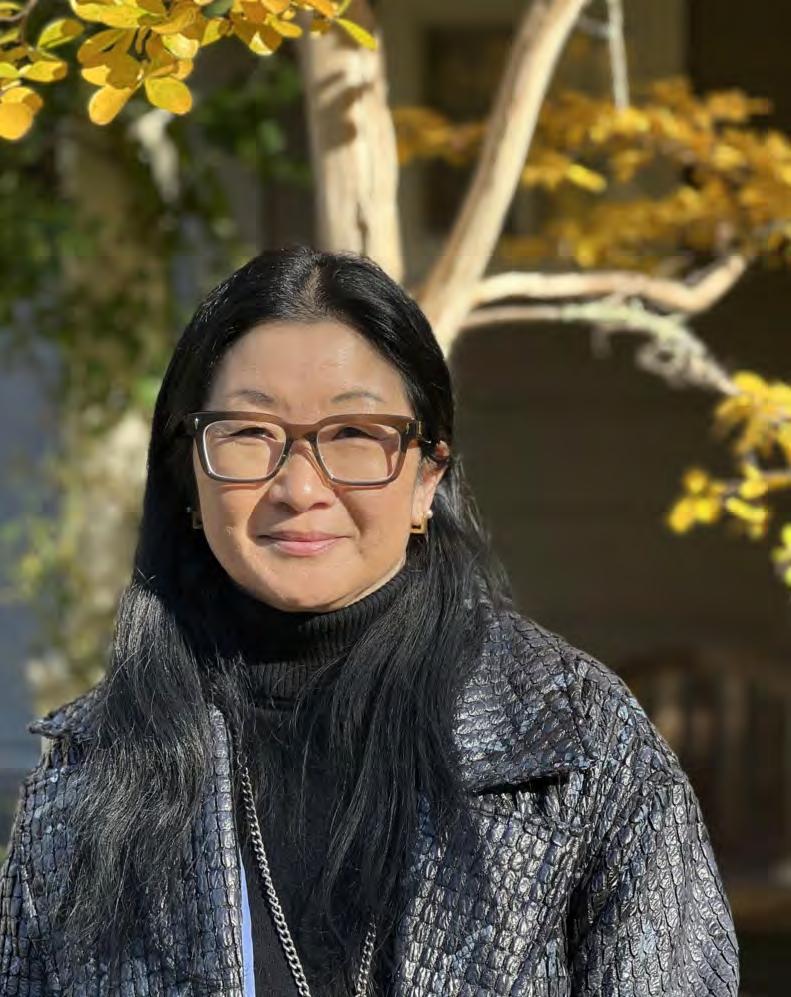
61ST ANNUAL PEOPLE TO WATCH SPONSORED BY MOHAWK FEATURING PACKAGING PEOPLE 2024 STUDENTS TO WATCH
DESIGN USA GD USA www.gdusa.com FEBRUARY 2024
GRAPHIC
FEBRUARY 2024
Made To INTRODUCING MOHAWK SUPERFINE FOLDING BOARD For more information about Mohawk Superfine Folding Board and Mohawk’s other papers engineered for packaging, visit mohawkconnects.com/madetofold
Fold What Will You Make Today? follow us @mohawkpaper
 GORDON KAYE AND SASHA KAYE-WALSH ARE EDITORS AT GDUSA
Comments,
editorial@ gdusa.com.
GORDON KAYE AND SASHA KAYE-WALSH ARE EDITORS AT GDUSA
Comments,
editorial@ gdusa.com.
For the 61st time, GDUSA presents ‘People To Watch’.
The annual edition highlights leaders in the creative community who have something important to say and back up their words with deeds — talent, achievement, leadership, service, newsworthiness.
It is necessarily a subjective selection, and we acknowledge our limitations upfront. But we think you will agree, this group is worthy of those who have come before. You can peruse the entire 60 year roster of legends, near-legends and occasional one-hitwonders at gdusa.com
For the 2024 edition, we have added a twist: a heavy overweighting of people engaged in, and thought leaders concerning, package design. Why? Because it is impossible to miss the fact that, in the evolving post-pandemic media world, packaging stands out and stands tall as both a vital communications tool and a rare growth opportunity.
In general, I prefer to let the “People To Watch” speak for themselves because they do it so well. But I cannot resist two quick observations based on their commentaries.
First, as we move forward, there is a clear consensus that graphic design is experiencing an elevated role in business and society, with the unprecedented potential to make human connections and shape commerce, culture, causes, brands and organizations.
This special power is amplified by the understanding – borne of the profound disruption of the past few years – that design is at its best when it is authentic, transparent and reflects heartfelt social, cultural and environmental values. Not to mention, when it is more inclusive in the messaging and in who creates the message.
Second, the package designers in our crowd see themselves as ready to meet the moment. Amidst the cacophony, clutter and confusion, effective packaging is a difference maker. It is tangible, immediate, interactive, emotive, tells the story and advances the brand promise at the moment of truth. And these days that moment can be prior to pur-chase, at the moment of purchase, in the unboxing phase, and can even last long beyond
The packaging industry faces challenges: first and foremost, the demand for sustainable materials and processes. The need to better integrate smart technologies and data into the process and finding the right role and balance for AI loom as well.
But Kaleb Sindec of Bakery Agency nicely captures the promise of great packaging and the joy of creating it: “We’re given the unique opportunity to invigorate all five senses to transport the consumer into a world we have meticulously crafted.” Mauro Porcini of PepsiCo takes a simlar but broader perspective: “The best packaging and graphic de-sign takes a people-first approach and places the wants and needs of human beings at the center of everything.”
– GDK/SKW
LETTER FROM THE EDITORS | WELCOME TO THE 2024 ‘PEOPLE TO WATCH’ EDITION
suggestions and letters can be sent to

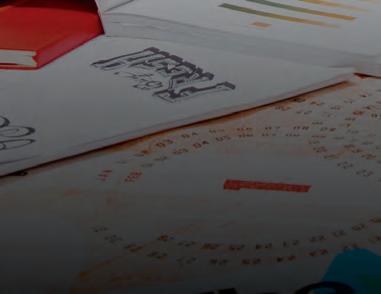
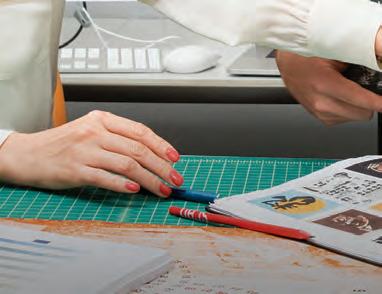
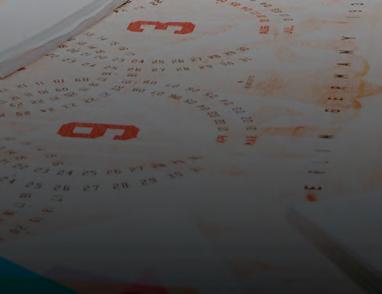
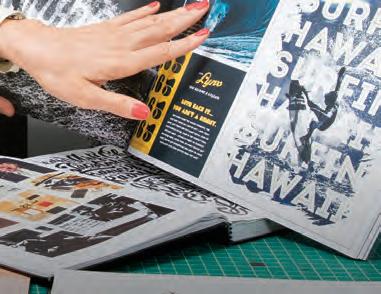







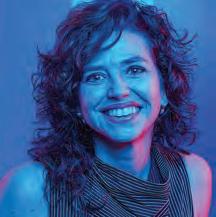
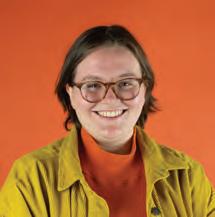

GDUSA - Graphic Design USA Volume 61 / No. 1 January/February 2024
Kaye Publishing Corporation (ISSN0274-7499/USPS227020). Published 6 times a year with combined issues in January/February, March/April, May/June, July/August, September/October, November/December. Executive, editorial and advertising offices at 89 Fifth Avenue, Suite 901, New York NY 10003. Phone: 212.696.4380, Fax: 212.696.4564, www.gdusa.com.
SUBSCRIPTION: Domestic, $72 one year. International, $140 one year. Periodicals postage paid at New York NY and additional mailing office.
POSTMASTER: Send address changes to GDUSA - Graphic Design USA, PO Box 3072, Langhorne PA 19047. Permit #224.
8 PEOPLE TO WATCH
GDUSA starts each year by featuring selected creative and design professionals who embody the spirit of the creative community and some special combination of talent, leadership, newsworthiness, insight, business savvy and/or community involvement. For 60+ years, this endeavor has provided a fascinating glimpse into what moves, motivates, worries and inspires. This year, recognizing the importance and vitality of package design in the creative business mix, we heavily weighted our invitees with people engaged in, and thought leaders about, packaging design. We know our limits and recognize that our selections are subjective. Still, we think you’ll find this year’s cohort as worthy — and exceptional — as the many who have come before.
12 PAPER FOR PACKAGING
Why use paper for packaging? And, just as importantly, how to specify and use paper for packaging? These questions can be intimidating but this brief article helps demystify the process.
60 STUDENTS TO WATCH
With the help of leading art and design schools nationwide, we identify top graphic design students nearing graduation. It’s a win-win: the students get recognized and we get energized by their fresh take. We honor students from the traditional design schools with elite reputations. We also reached out to wonderful public and private universities, as well as select online programs, that continue to evolve and expand. In the next print and digital edition, we’ll publish our annual list of Top Design Schools + Programs from whence many of these rising stars ... well... rise.
110 A DIGITAL CAREER PATH
Lucy Marino of global talent solutions firm Robert Half on why digital design is in such great demand and how you can prepare yourself to take the digital career path.
GDUSA.COM
Our popular website features news, ideas and information, as well as two current features that complement this print edition. First is a complete roster of People To Watch spanning six decades, with names like Bass, Chermayeff, Dorfsman, Glaser, Landor, Vignelli and hundreds more. Second up is our compilation of Designer-Friendly Suppliers + Services who serve and support the creative community. There is a symbiotic relationship between creators and their tools; links makes it easy to connect.
CONTENTS | FEBRUARY 2024
A GRADUATE DEGREE AS UNIQUE AS YOU ARE.
The Multimedia, Photography and Design program is for students who are passionate about expanding their career and gaining industry ready skills in the field of graphic design, motion design, 3D design, XR and immersive design, UI/UX design as well as photography and cinematography: all hands-on.
newhouse.syr.edu
THANK YOU TO MOHAWK
Mohawk Fine Papers, Inc. is the exclusive sponsor of this 61st annual People To Watch edition and the inspiration for featuring Package Design People in 2024. See pages 12-13 for insights from Mohawk on why and how to use paper in packaging.
With a culture of innovation reaching back to its beginning in 1931, Mohawk is committed to providing the finest materials that help make every printed project more beautiful, effective, and memorable for commercial and digital printing, and luxury packaging. Mohawk is based in Cohoes NY with operations located throughout North America and a global sales team to support customers near and far. As a leader in environmentally and socially responsible business practices, Mohawk was the first U.S. manufacturer of commercial printing papers to match 100% of its electricity with wind power renewable energy credits and the first U.S. premium paper mill to shift toward carbon neutral production. Mohawk’s portfolio of recycled papers is certified by Green Seal and the Forest Stewardship Council (FSC). Mohawk fine papers and envelopes include the signature brands Mohawk Superfine®, Crane Lettra® Strathmore®, and Renewal®, as well as proprietary treatments Inxwell® and i-Tone®.
Please visit mohawkconnects.com and mohawkconnects.com/packaging-papers
ABOUT THE COVER
Joanne Chan is global CEO at Turner Duckworth, a world-class branding agency. She is one of our 2024 GDUSA People to Watch. It all starts at PAGE 8.
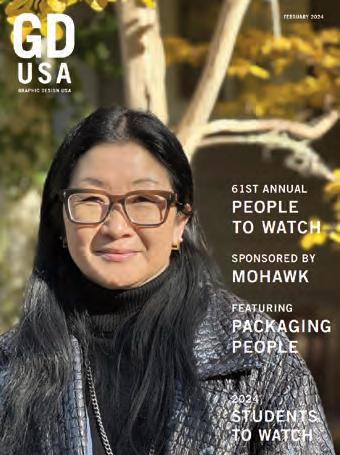
COVER PAPER CREDIT : The cover of this special edition of GDUSA is printed on FSC-certified Kallima Coated Cover C2S, part of the Kallima Paper family of FSC-certified coated cover paperboard, manufactured by the Tembec Paper Group. A leading advocate of sustainability, Kallima has a distinct low-density high-bulk construction resulting in less trees used and signficant cost savings to the customer. Contact: kallimapaper.com and 1.800.411.7011
GD USA
Gordon Kaye
Ilana Greenberg
Sasha Kaye-Walsh
| WEBSITE +
Gordon Kaye
| PRINT EDITION
Charlotte Kaye
Althea Edwards
SERVICES
Angelo Abbondante
MANAGER
Jennifer Hoff
Scott Sczcypiorski
Maliya Malik
Jay Lewis Jeffrey Rosenberg
Ron Andriani
Milton L. Kaye
GRAPHIC DESIGN USA
PUBLISHER
CREATIVE DIRECTOR
EDITOR
ENEWS + SOCIAL MEDIA
EDITOR
GRAPHIC DESIGN
READER
ACCOUNTS
INTERNET
SERVICES
CONSULTANT
SOCIAL MEDIA | DESIGN
PHOTOGRAPHY
ADVERTISING SALES + INTEGRATED MARKETING + BUSINESS DEVELOPMENT 201.669.9884 212.696.4380 randriani@ gdusa.com
1921–
FOUNDER COPYRIGHT 2024 BY KAYE PUBLISHING CORPORATION
2016
MATCHING TALENT WITH SUCCESS NATIONWIDE ®
The Great Resignation has left companies scrambling for talented designers and creatives searching for fulfilling projects. That's where Artisan Talent comes in. We're a boutique creative staffing agency here to make things easier for you - whether you’re hiring talent or finding work. From small agencies to major corporations, our team is in the business of connecting people. That’s what makes us Artisan.
TOP PLACED TITLES
Art Director
Brand Designer
Copywriter
Product Designer
Digital Designer
Graphic Designer
Senior Designer
Visual Designer
UI/UX Designer
ARTISANTALENT.COM
PEOPLE TO WATCH

8 GDUSA
FOR 61 YEARS, THE FIRST EDITION OF GDUSA HAS RECOGNIZED ‘PEOPLE TO WATCH’ WHO EMBODY THE SPIRIT OF THE CREATIVE COMMUNITY.
Individuals we know and respect for a combination of talent, success, leadership, newsworthiness, influence, thought-leadership and service. In a community so big and deep in talent, this is clearly subjective. Still, for six decades, it has worked out pretty well; the roster of past participants is star-studded and this group adds to the shine. In 2024, there’s a twist: we feature a preponderance of people engaged in package design because that is where we expect outsized action, ferment and opportunity in the coming year.
t
2024 MAURO PORCINI
CHIEF DESIGN OFFICER, PEPSICO, PURCHASE NY
Mauro Porcini is PepsiCo’s first-ever Chief Design Officer. He joined the food and beverage company in 2012 and in said role he is infusing design thinking into PepsiCo’s culture and is leading a new approach to innovation by design that impacts the company’s product platforms and brands, including Pepsi, Lay’s, Mountain Dew, Gatorade, Doritos, Lifewtr, Bubly, Aquafina, Cheetos, Quaker, 7Up, Mirinda, and many others.
His focus extends from physical to virtual expressions of the brands, including product, packaging, events, advertising, fashion and art collaborations, retail activation, architecture, and digital media. He leads teams based in New York City, Purchase, Dallas, Chicago, Los Angeles, Orlando, Miami, London, Dublin, Moscow, Il Cairo, New Delhi, Shanghai, Bangkok, Mexico City, Sao Paulo and Cape Town.
Since 2020, he has been a presenter and judge on the TV show New York by Design and America by Design, airing on CBS and Amazon Prime Video.
In fall 2022, Mauro published his first book in English, The Human Side of Innovation: The Power of People in Love with People (Berrett-Koehler), which focuses on innovation, design and leadership. The book was named a Gold Winner of the Better Future – New York Design Award. In spring 2021, he published his first book in Italian “L’età dell’eccellenza – Come innovazione e creatività possono costruire un mondo migliore” (Il Saggiatore).
Prior to joining PepsiCo, Mauro served as the first ever Chief Design Officer at 3M, where his mission was to build and nurture a design sensitive culture in a technology driven global corporation.
We see an increased emphasis on Package Design to advance the brand, tell the story, amplify the experience, and forge an emotional connection with consumers. Do you agree with this observation and, if so, why is there an intensified focus on package design? I completely agree. In this global, high-tech, and digitized world we live in, the best packaging and graphic design takes a people-first approach and places the wants and needs of human beings at the center of everything. Design can be fun, convenient, precious, and accessible, but good design is always an act of respect, an act of empathy, and an act of love. This type of human-centric design forges the deepest connections with people. As a discipline, packaging design provides a unique opportunity for us to tell stories and connect with people right where they are. Designers paint people’s daily interactions with the brands that surround them, and packaging is one of the most visible aspects of a brand. I have noticed a few trends that I think will continue to triumph in 2024 and beyond. In both packaging design and all other design disciplines, there is an increased focus on implementing sustainability, providing authentic personalization, and incorporating wellness. Additionally, we will continue to utilize new forms of technology, like wearables, data, 3D printing as a tool to unlock these focus areas, while maintaining a humancentric and empathic approach to design.
| SPONSORED BY MOHAWK|
GDUSA 9
A MESSAGE FROM THE SPONSOR | MOHAWK FINE PAPERS
From your morning coffee to your late-night snack, from Amazon to Zappos and everything in between, the things we buy have one thing in common: nearly all of it comes in some kind of packaging.
Each packaging component is a touchpoint between company and consumer. All those boxes, bags, wraps, tags, envelopes, and mailers are anything but afterthoughts; they are designed to give you pause.
Packaging provides an opportunity to reinforce or realign a buyer’s thoughts on — and impression of — a brand. You must consider every material input used and what it says (or does-n't) about your business or product.
So why use paper for packaging? And, more importantly, HOW can you use paper for packaging? Knowing how to specify paper for packaging can be intimidating — to demystify the process of designing packaging for print, from concept to production, we must answer these questions first:
Why Use Paper For Packaging?
There are many advantages of paper packaging. Tactile paper adds dramatic visual and tactile appeal that helps set the product inside apart from the competition. Uncoated paper in particular adds richness to imagery and illustrations while holding the dense color and exquisite detail that luxury brands depend on for maximum impact in the retail environment.
Paper is also a sustainable alternative to plastic because it is biodegradable and easily recycled. By choosing paper instead of plastic you reduce carbon dioxide emissions and can increase positive public perception of your brand or product as environmental consciousness is highly valued by consumers.
What Is A Packaging Paper?
Truthfully, any paper can be used for packaging if you get creative enough, but papers engineered for packaging are made to specification and designed with special chemistry to be scored and folded without cracking.
BOX
WRAPS: Lighter, text-weight papers can be used as box wrap to add flair to plain, sturdy, ridged box packages, or you can even use paper as a gift wrap.
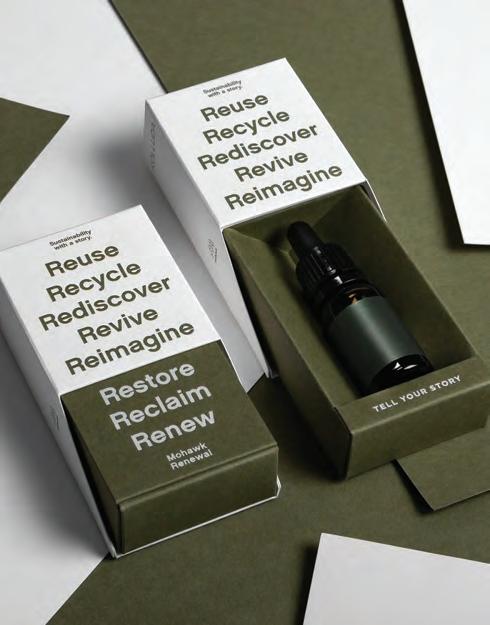
FOLDING
BOARD: Heavier, cover-weight papers that are sturdy enough to hold their own with products inside. There’s no offi-cial standard weight and often depends on the size of the item in the box. 18 point folding board is a very common weight specified for folding boxes. That said, Mohawk has engineered 16pt – 24pt Superfine folding board designed to be scored and folded for box applications.
How Do You Choose A Packaging Paper Weight?
Are you wrapping a heavy candle that will sit on a boutique shelf? A lightweight personal care item, like cosmetics or soap? A luxury chocolate bar or craft spirit?
Generally, heavier items will necessitate sturdier packaging. 18pt is a relative starting point, but folding board papers are available in weights ranging from 12pt to 24pt depending on your project’s needs. It’s important to think about what the container will have to withstand. Will it be mailed directly? Will it be handled frequently in a high-touch retail environment? Or will it need to have a second life beyond its shelf life?
10 GDUSA

This should all factor into not only what weight folding board you select, but the texture and color of the paper you choose for your packaging as well.
Make Your Packaging Memorable.
Every print object — especially packaging — creates a physical experience. With a little planning, you can make sure people experience your work in a way that evokes emotion and creates strong, memorable connections. Whether your project calls for sustainable materials, rich color, or beautiful textures, Mohawk has a diverse portfolio of papers available worldwide, including Fedrigoni papers, for your most demanding and discerning packaging projects.
Before you open a package, touch communicates, evokes emotions, and even sometimes challenges expectations. This documented effect is called embodied cognition and it’s something we all experience subconsciously that affects us emotionally and influences our interaction with an object. Colored and textured paper is a simple, but impactful way to embrace the unexpected and enhance your packaging by letting materials play a key role in support of your design intent.
For more information on colored, textured, and sustainable packaging paper options and custom colors, weights and sheet sizes from Mohawk visit ...
mohawkconnects.com/packaging-papers
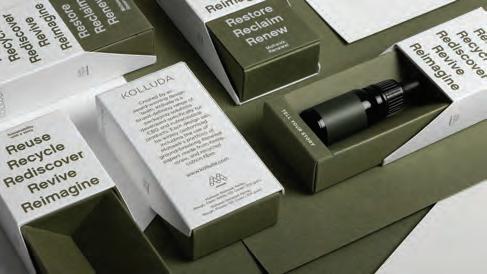

GDUSA 11
Made To INTRODUCING MOHAWK SUPERFINE FOLDING BOARD For more information about Mohawk Superfine Folding Board and Mohawk’s other papers engineered for packaging, visit mohawkconnects.com/madetofold
Fold What Will You Make Today? follow us @mohawkpaper
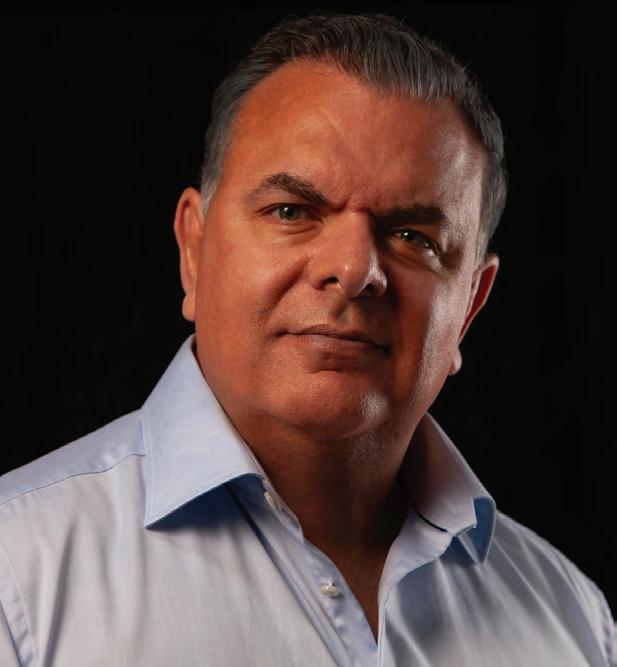
ARIEL FREANER
PRINCIPAL/FOUNDER
FREANER CREATIVE AND DESIGN, SAN DIEGO CA
Ariel Freaner has over 35 years of experience in creative development, illustration, and design. Born in Hermosillo, Sonora, Mexico, Freaner founded Freaner Creative and Design in 1985. His award-winning fullservice creative firm offers traditional and digital innovative services including creative development, graphic design, editorial and print, brand development, advertising campaigns, web and app design, online marketing, illustration, animation, game design, social media and 3-D development, and other related services.
Freaner Creative and Design’s multilingual, cross-border, and international commercial campaigns have distinguished it from many Southern California firms, earning numerous international and industry awards from organizations including Graphis, International Design Awards, American Institute of Graphic Arts, the Society of News Design, and PRINT magazine. Recently, Freaner received five Emmy Awards for Art Direction, Visual Effects, and Sound Design.
Among U.S. clients, Freaner has produced creative and design projects for the County of San Diego, the Red Cross, Motorola, the U.S. Navy, The San Diego Union-Tribune, and Todd Gloria’s successful San Diego
mayoral campaign. Freaner’s international clients range from Fujitsu Latin America, Clarion Latin America, Uniradio, Smart & Final Mexico, Lintel, Las Colinas Industrial Park, Zeta Weekly, and TBWA Mexico, among many others.
As we pivot into a post-pandemic era marked by societal challenge and change, are you optimistic about the future of Graphic Design in supporting and shaping commerce, culture and causes? Why do you feel the way you do? Are you optimistic about the future of your own design career or business?
The pandemic forced graphic designers to leap forward to an entirely new level in our digital era. One that would enable us to communicate more diretly, boldly, and even more intimately with our audiences. Those of us who embraced new technologies and new media have felt part of a revolution. I always see change as an opportunity to improve and grow, whether in media or the technology we use. It sparks creativity in novel and exciting ways. Our adoption of the new and latest technologies allows us to take design to impressive new heights. It helps us envision and produce even more effective designs that support our clients’ messages by captivating and influencing their audiences. I find that exciting, so yes, I am very optimistic about my firm’s future.
We see an increased emphasis on Package Design to advance the brand, tell the story, amplify the experience, and forge an emotional connection with consumers. Do you agree with this observation and, if so, why is there an intensified focus on package design? Whether a physical object, something two dimensional, or purley digital like an app or a website, package design is critical to engaging consumers and forging a connection so they relate to and desire what’s being sold. Package design is like creating an aura of magic around a product. Companies, like us, that effectively focus on package design are securing brand recognition.
14 GDUSA 2024 | PEOPLE TO WATCH
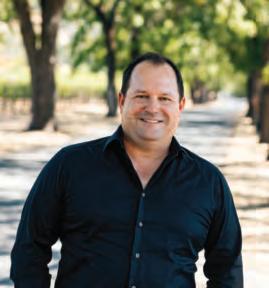
DAVID SCHUEMANN
OWNER/CREATIVE DIRECTOR
CF NAPA BRAND DESIGN, NAPA CA
For nearly 50 years, CF Napa Brand Design has set the standard for alcohol beverage branding. We focus on translating brand ethos visually, never using a one size fits all approach for projects. The result is a bespoke solution rooted in strategy and, most importantly, a design that sells.
With the dream to marry his passions for wine, beer, and spirits with brand design, David Schuemann joined CF Napa as Creative Director in 2001. A year later in 2002 he purchased the firm and has since led CF Napa to become one of the world’s preeminent brand agencies specializing in the alcohol beverage industry, creating some of the fastest growing and most successful brands in the world.
The firm’s work has earned recognition from nearly every major design competition, has been showcased in the Museum of Modern Art, is part of the permanent collection at the Cooper Hewitt Design Museum at the Smithsonian in New York City and at the permanent collection of the American Design Archives at the Denver Art Museum.
Schuemann authored “99 Bottles of Wine, The Making of the Contemporary Wine Label, writes for numerous periodicals, and is a regular industry speaker.
As we pivot into a post-pandemic era marked by societal challenge and change, are you optimistic about the future of Graphic Design to support and shape commerce, culture and causes? Why do you feel the way you do? Are you optimistic about the future of your own firm?
Strategic thinking combined with graphic design will always play an integral role in shaping the landscape of thinking and the future of commerce, culture, and causes. Graphic designers have the unique ability to harness the power of, and shift with, technologies to improve communication for their clients. Rather than technology replacing graphic designers I see us shaping and effectively communicating ideas through sophisticated and educated filters to produce communications that continue to drive thought leadership. My firm, CF Napa, has grown from a corner shop to a firm working with clients globally. Despite our very niche positioning I continue to be excited about the opportunity to grow sustainably by growing our client offerings in the years to come.
We are seeing an increased focus on Package Design to advance the brand, tell the story, amplify the experience, forge an emotional connection. Do you agree with this observation and, if so, what advantages does packaging have over other graphic communications?
Packaging is a crucial driver of initial trial, perception of quality and repurchase decisions. Exceptional packaging backed by evocative storytelling is one of the keys to cutting through the noise and standing out from the crowd and is certainly a trend that is here to stay. Packaging has the huge advantage of interacting with your target consumer at the point of purchase. Additionally, it is far more engaging than other forms of graphic communication, the customer is actively interacting with the product and considering spending money in the retail market when they come across your package. Other forms of communication, such as advertising, are interrupting your activity.
GDUSA 15
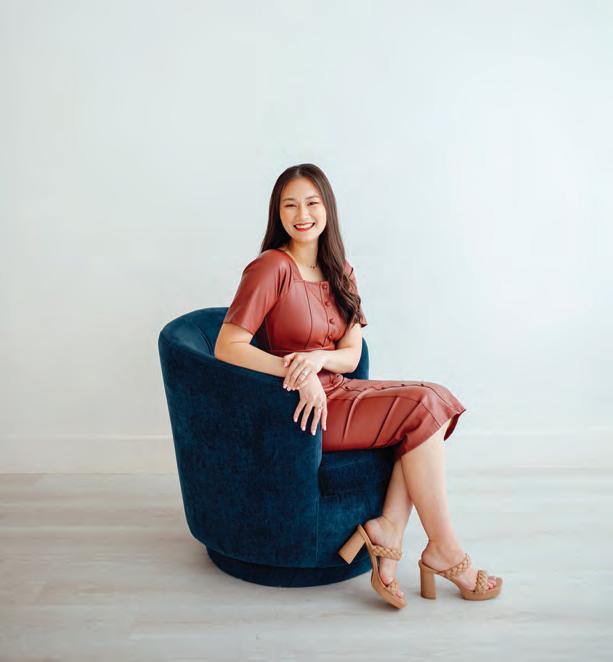
ANITA WONG ZHOU
SENIOR GRAPHIC DESIGNER/CREATIVE LEAD
DAVID WEEKLEY HOMES, HOUSTON TX
Anita Wong Zhou, a creative professional, embarked on her journey in the bustling landscape of New York, where she kickstarted her career at Vogue Magazine and later contributed her creative insights to PHYTO Haircare. Always passionate about art and design from a young age, Anita honed her skills and artistic sensibilities, culminating in a Bachelor of Fine Arts in Communication Design from Parsons School of Design. Returning to her hometown of Houston, TX, she transitioned into the dynamic realm of the oil and gas industries, marking the beginning of a diverse and enriching professional trajectory.
Over the past eight years, Anita has made significant contributions to the real estate sector, serving as the Senior Graphic Designer & Creative Lead at David Weekley Homes. In this role, she has led with innovation, ensuring brand cohesiveness and delivering compelling visual experiences that reflect her strategic approach to design. Anita's career is a testament to her lifelong passion for art and design, as well as her versatility and excellence, earning her recognition as an
award-winning creative professional. Her ability to excel across multiple industries reflects her dedication to making lasting impacts within each.
As we pivot into a post-pandemic era marked by societal challenge and change, are you optimistic about the future of Graphic Design in supporting and shaping commerce, culture and causes? Why do you feel the way you do? Are you optimistic about the future of your own design career or business?
The post-pandemic era presents exciting opportunities for Graphic Design to thrive in shaping commerce, culture, and causes. Graphic Design's adaptability has proven crucial during societal shifts, and with the significant move to online platforms, it has emphasized the importance of visual communication, branding, and user experience. This shift underscores the integral role design will play in helping businesses connect with their audiences in innovative ways. Additionally, recognizing the importance of raising awareness about various cultures and ways of thinking, and drawing from personal experience, growing up as a minority; I didn't see a lot of people who look like me in the media. This has fueled my commitment to diversity and inclusion, understanding how representation matters. It is crucial to elevate diversity by being the change you want to see, and as designers embrace this responsibility, they contribute to a positive shift in societal perspectives. For me, this includes being the kind of role model I wish I had seen growing up, actively working to inspire and pave the way for future generations. With technological advances and an evolving landscape, the future holds promise for designers who embrace change, stay informed, and actively contribute to positive societal shifts. Personally, my optimism stems from a commitment to continuous learning, adaptability, and a deep passion for the transformative potential of design.
16 GDUSA 2024 | PEOPLE TO WATCH
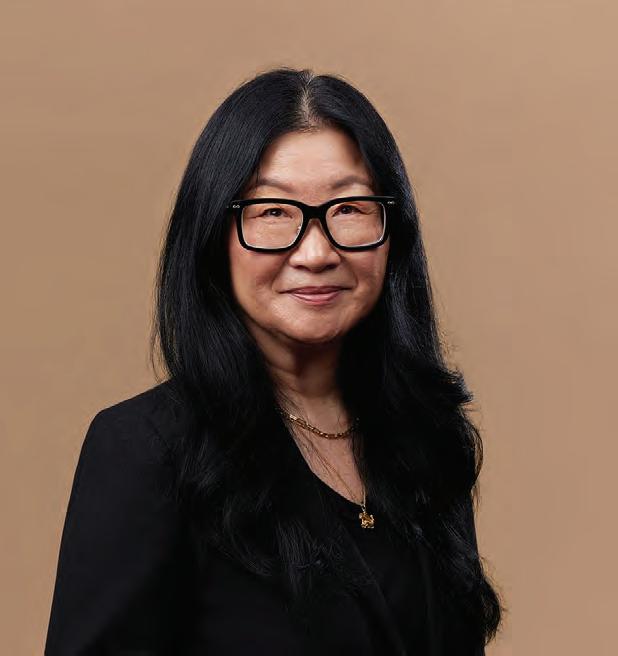
JOANNE CHAN
CEO, TURNER DUCKWORTH, SAN FRANCISCO CA
Joanne Chan is the global CEO of Turner Duckworth, a world-class branding agency with studios in San Francisco, London, and New York. Turner Duckworth has designed some of the world’s most valuable brands, including Amazon, McDonald’s, Coca-Cola, Levi’s, and Samsung, and has won the design world’s most coveted awards, including a Cannes Grand Prix for Design, induction into the Clio Hall of Fame, Pentawards #1 Packaging Design Agency and even a Grammy. Turner Duckworth’s book, I Love It. What Is It? The Power of Instinct in Design and Branding will be available wherever books are sold in March 2024.
Joanne’s first career was in the art world, having worked at prestigious art galleries in New York, Monaco, and San Francisco, and the Guggenheim Museum. After deciding on a career shift, Joanne became employee #2 at Turner Duckworth San Francisco, establishing and growing its design business in the United States. Over 26+ years, Joanne went from managing brand identity and packaging projects to focusing on new business, operations, and finance, leading to the acquisition of Turner Duckworth by Publicis Groupe in 2014. Joanne was appointed global CEO in 2019. She lives in Marin County, where their four cats outnumber her, her husband, and her teenage daughter.
As we pivot into a post-pandemic era marked by societal challenge and change, are you optimistic about the future of Graphic Design to support and shape commerce, culture and causes? Why do you feel the way you do? Are you optimistic about the future of your own firm?
In 2023 more of our clients had the confidence to have fun with their brands, perhaps because we’ve collectively come out of the pandemic feeling the need for some lightness. It’s refreshing that many clients are valuing their fans - not just for their spending power, but also for their emotional currency. This is why I’m optimistic about the future of Turner Duckworth. We help our clients shape culture through creativity, by designing lovable, flexible, covetable things that connect with consumers on a visceral and emotional level.
We are seeing an increased focus on Package Design to advance the brand, tell the story, amplify the experience, forge an emotional connection. Do you agree with this observation and, if so, what advantages does packaging have over other graphic communications?
Packaging has always been key, it's the brand in your hand. Packaging works far harder than other graphic communications. On a basic level it is functional–it needs to protect the product inside, survive its transport to the shelf and home, and it needs to be easy to open and close. It’s also informative–it needs to tell you what’s inside and communicate benefits and claims. It needs to speak from the shelf in a crowded environment and urge you to pick it up. Packaging is highly emotional–when done right–it grabs attention, peaks curiosity, and can make a person feel something. ‘I love it, I want it.’ Packaging is a unique storytelling opportunity and a primary way for consumers to interact with and embrace brands. We’re seeing brands catch on to the power of surprise and delight: big brands behaving like challenger brands, bold use of color, shapes, textures, and typography, and thankfully, brands that are taking the approach of ‘less is more.’
GDUSA 17
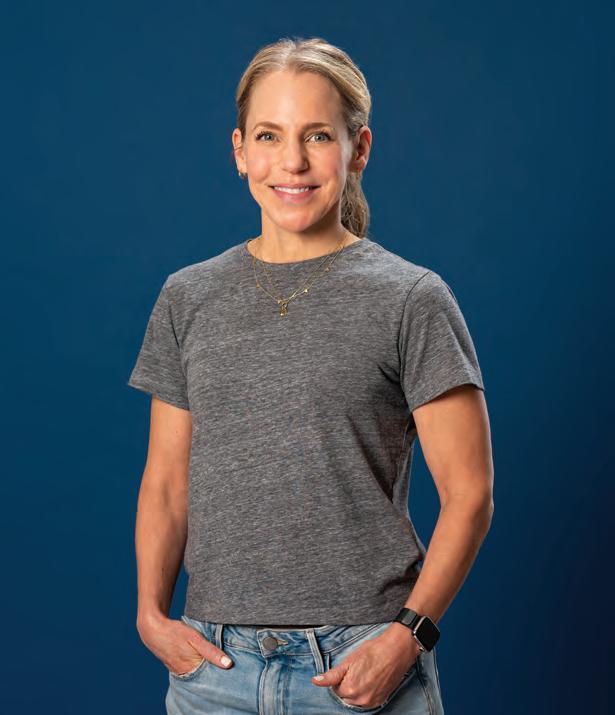
BECKY NELSON DAHL
CO-FOUNDER/CO-CREATIVE DIRECTOR BEXBRANDS, SAN DIEGO CA
With a career spanning over 20 years in design and advertising, Becky Nelson Dahl is a force when it comes to the world of food and beverage. After a decade working with top agencies throughout Los Angeles, Orange County, and San Diego, she started BexBrands with her husband, Jeremy Dahl in 2012. Together, they’ve changed the game when it comes to branding and design, pushing the boundaries of packaging, and celebrating purpose-driven brands throughout the industry.
Inspired by innovation and how to design for change, Bex integrates a whole-team, whole-brand approach in everything they do. From start to finish, strategy permeates a project; inviting designers in to understand the unseen forces that shape a brand. For Bex, it’s about not only creating beautiful visual identity systems and packaging, but solving for that point where form meets function.
Bex’s clients have included: Suja Juice, Once Upon a Farm, Dr. Praeger’s, Chameleon Cold Brew, Back to the Roots, and many more. Their work has won multiple design awards and they are continuously grateful for the enduring nature of the brands they’ve built. Bex is proud to say every project is a passion project.
As we pivot into a post-pandemic era marked by societal challenge and change, are you optimistic about the future of Graphic Design to support and shape commerce, culture and causes? Why do you feel the way you do? Are you optimistic about the future of your own design career or business?
I’m an unashamed optimist so I am, of course, optimistic. However, I do think there are two significant forces we have to consider as we look toward the next 10 years of graphic design. The first is AI, and the second is our post-pandemic social behavior. I definitely don’t think AI will completely take away my job, but I do think it’s going to be used increasingly. At BexBrands, we use it to cut down on tasks that can potentially take a lot of time. It never replaces a real person for us, though. After all, you notice when there isn’t a human touch. In terms of social behavior, it’s changed a lot for all of us since 2020. I think it’s made a lot of people appreciate genuine connection and real-life community. Personally, I think we’re naturally social creatures and that the pendulum is swinging back toward a team-work frame of mind. For us, our best creative work comes from collaboration and that’s exciting
We are seeing an increased focus on Package Design to advance the brand, tell the story, amplify the experience, forge an emotional connection. Do you agree with this observation and, if so, what advantages does packaging have over other graphic communications?
Trend #1 — Bright colors and “Goopy” type. Somehow this has been applied to everything from oatmeal to chips to kombucha. It just lacks originality and distinctiveness.
Trend #2 — Sustainable Packaging Structures. The cost of more sustainable packaging options is becoming more realistic and suitable for consumer packaged goods. This is a win for everyone.
2024 | PEOPLE TO WATCH 18 GDUSA
NEWTALENTPREVIEW
HiretheLatestDesignTalentOurdesignersarethenewesteditiontothelegacy oftheSyracuseUniversitycommunicationsdesign program.Theirportfoliosrepresentdiverseprojects thatspanabroadrangeofskillsincludingbranding,art direction,editorialdesign,packagingdesign,UI/UX design,webdesignandadvertising.Notwoportfolios arealike.Viewtheimpressivecollectionofworkhere:
vpa.syr.edu/cmd2023
admissu@syr.edu
315.443.2769
vpa.syr.edu/cmd2023
@su_commdesign SCHOOL OF DESIGN
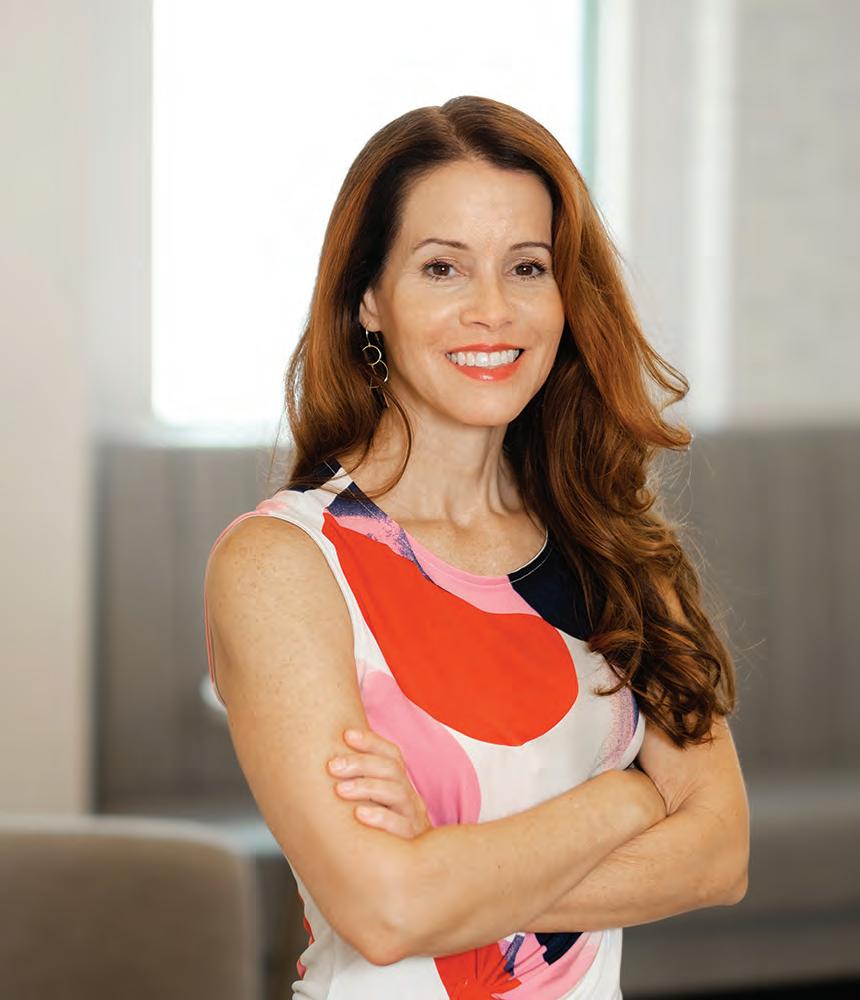
BRANDIE KNOX
PRINCIPAL/CREATIVE DIRECTOR
KNOX DESIGN STRATEGY, NEW YORK NY
Brandie Knox is the Principal & Creative Director of Knox Design Strategy. In addition to transforming the identity of law firms and legal adjacent companies, the studio dives deep into unraveling intricate UX/UI challenges for internal applications – think client portals, knowledge databases, and intranets designed to streamline processes, enhance collaboration, and tackle realworld business issues.
A native of North Carolina, Brandie's journey led her from earning her BA and MFA at East Carolina University’s School of Art & Design to serving on its faculty. She soon made the bold move to the bustling streets of New York City where she was eventually recruited by an international AmLaw 50 law firm and was immersed in the intricacies of legal marketing and design.
In 2009, Brandie's expertise reached new heights when she ventured into the world of entrepreneurship and founded Knox Design Strategy. Brandie and her team love digging into their clients’ businesses and strategies, learning how they work and succeed, and creating solutions that help meet their goals. She has now spent over two decades honing her knowledge of the legal industry.
Brandie is not just reshaping brands – she's creating a paradigm shift. The studio is on the verge of unveiling its own groundbreaking product.
As we pivot into a post-pandemic era marked by societal challenge and change, are you optimistic about the future of Graphic Design in supporting and shaping commerce, culture and causes? Why do you feel the way you do? Are you optimistic about the future of your own design career or business?
I'm hopeful that society is gaining a better grasp of the significance of design and its potential to shape culture and drive change. While there's still progress to be made, I see a positive trajectory. Shifting our focus from the tangible results of design, such as end products, to the design process itself – embracing design thinking – holds the key to genuine transformation and impactful results. As designers, it's the journey that often leads to solutions, involving problem-solving, thoughtful consideration of alternatives, and open ideation without premature judgment. I am concerned that in our digital age, the crucial ideation process might be overshadowed by tools producing polished designs that fall short in addressing real problems. I'm encouraged by the growing realization within corporations and organizations that diverse perspectives, beyond the C-suite, are essential for generating innovative ideas, influencing outcomes, and offering unique viewpoints. So, while my optimism remains strong, I'd underscore that it's not solely about graphic design but more about embracing the ethos of design thinking.
20 GDUSA 2024 | PEOPLE TO WATCH

ROB BAIRD
CO-FOUNDER/CHIEF CREATIVE OFFICER PREACHER, AUSTIN TX
In 2014, Rob Baird co-founded PREACHER in Austin, TX, with Seth Gaffney and Krystle Loyland, two colleagues from Mother New York. They moved to Texas to find more soul in the business and more room to experiment. The agency's home is now a two-story hospitality-forward space, with a contemporary art gallery, a professional recording studio, and a storefront named Divine Provisions which helps support the agency’s charitable initiatives. Preacher’s current clients include ESPN, Foot Locker, Shake Shack, EJ Gallo, and YETI, and the agency has been fortunate to be honored by AdAge’s Small Agency Awards and A-List every year since 2015.
Prior to Preacher, Rob spent almost a decade in the New York and London offices of Mother leading award-winning creative for Virgin Mobile, Stella Artois, Coca-Cola, and Sour Patch Kids, and has also led work at TBWA Chiat Day, Fallon, BBH and Arnold. He’s previously judged D&AD, The One Show, the Art Directors Club, AICP, and Communication Arts among others.
Rob has been lucky enough to have his work featured in every major advertising award show over the years, and has occasionally been mentioned in his family's annual Holiday letter.
As we pivot into a post-pandemic era marked by societal challenge and change, are you optimistic about the future of Graphic Design to support and shape commerce, culture and causes? Why do you feel the way you do? Are you optimistic about the future of your own firm?
I’m actually really optimistic about the role graphic design is playing right now, and will continue to play in the future. When you think about the power of design and visual communication to supercharge movements and important causes, to give life and momentum to small businesses that might be someone’s true passion in life, or even just to bring happiness as a beautiful package, it’s pretty endless. It feels like brands and organizations have placed the importance of design strategy and visual craft as essential to their success. It’s a wonderful time to embrace multi-disciplinary design.
We are seeing an increased focus on Package Design to advance the brand, tell the story, amplify the experience, forge an emotional connection. Do you agree with this observation and, if so, what advantages does packaging have over other graphic communications?
It feels like the emotional connection brands make with their consumers has never been more important, because now, consumers truly crave it. I’ve seen so many products putting little unexpected moments of great brand personality into the nooks and crannies and undersides of packaging. This is a fantastic time for package design, and for designers, to really impact businesses in a meaningful way.
GDUSA 21
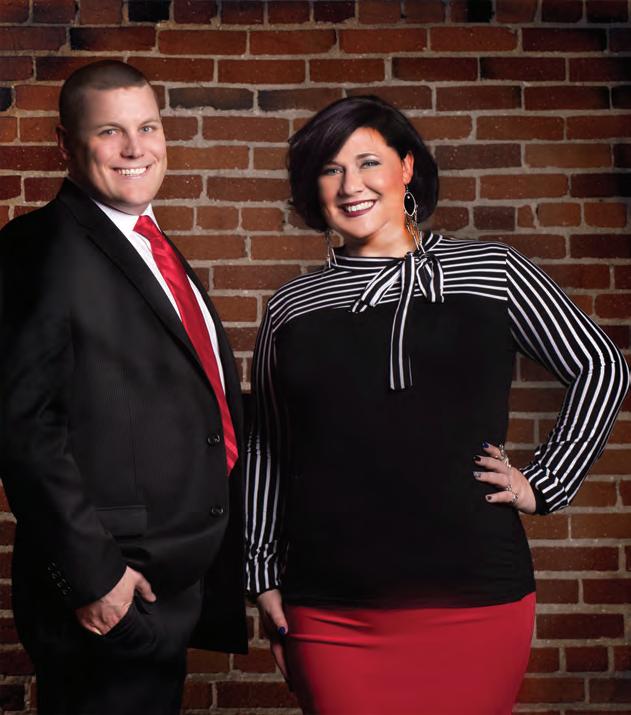
COURTNEY MEREDITH
CREATIVE DIRECTOR/LEAD BRAND STRATEGIST DESIGN ON EDGE, RENO NV
Courtney Meredith is the Creative Director and lead Brand Strategist at Design on Edge, co-founded by husband Chris Meredith in 2006. Design on Edge is a boutique agency passionate about building identities for businesses through a broad array of creative services. Developed in the wake of the recession to provide marketing and design support to struggling small businesses and nonprofits. Today, the agency focuses on the industry's growing trends, providing award-winning insight and techniques to its clients. The evolving creative studio and integrated digital marketing agency specializes in graphic design, brand strategy, advertising, campaign development, marketing consulting, and website design.
As we pivot into a post-pandemic era marked by societal challenge and change, are you optimistic about the future of Graphic Design in supporting and shaping commerce, culture and causes? Why do you feel the way you do? Are you optimistic about the future of your own design career or business?
Graphic design will continue to fulfill its fundamental purpose as we contemplate recent societal shifts in our post-pandemic era or any era. Moreover, we believe Graphic Design will delve deeper into the intricacies of user behavior, explore its psychology, and better reflect trends in packaging, fashion, and culture. This exploration, coupled with the integration of AI, challenges designers to break through barriers and forge a new path, creating authentic and meaningful content while still honoring traditional methodologies. As a small boutique agency, it is imperative that we allocate resources to methods that offer visual support to our clients and staff, that we shake hands with new software and ideals, and try to push ourselves outside our comfort zone. Despite the prevalence of pre-created templates, AI design, and client-curated work that may deviate from brand guidelines or feel disconnected from campaigns, we must uphold our role as professionals; it is crucial, now more than ever, to educate consumers on the significance of great design, authentic illustration, media ethics, and strategic brand development.
We are seeing an increased focus on Package Design to advance the brand, tell the story, amplify the experience, forge an emotional connection. Do you agree with this observation and, if so, what advantages does packaging have over other graphic communications?
Package design has evolved into an exciting combination of visual appeal and functionality in-store and online. For many businesses, package design has become an opportunity to create a deeper connection with customers, differentiate their products, stand out in a competitive market, and create unique experiences. Physical interactivity and packaging that provide multiple functionalities have become increasingly popular, combining tactile and digital elements for a multisensory experience. Furthermore, sustainability will continue to be a crucial consideration partnered with new trends towards simplicity and clarity in design, with clean lines, hyper-contrast, and a discreet yet deluxe look promoting the product's qualities.
22 GDUSA 2024 | PEOPLE TO WATCH
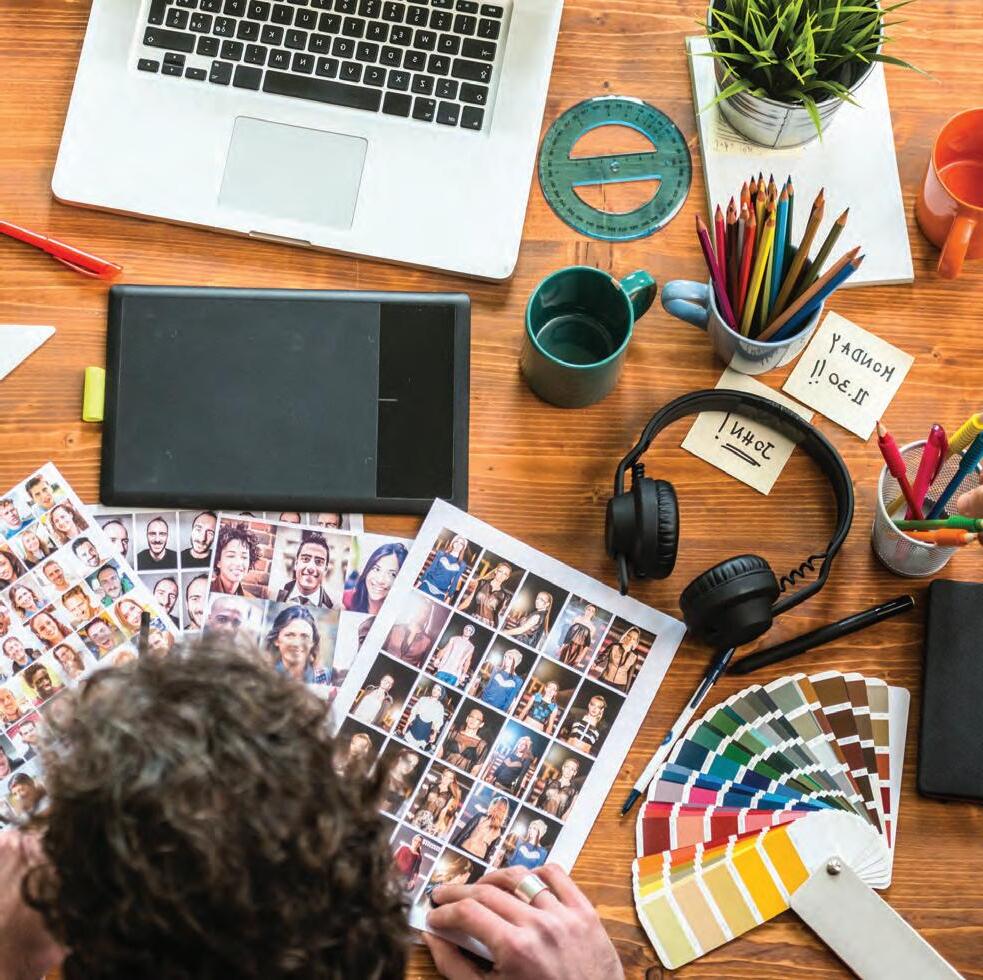
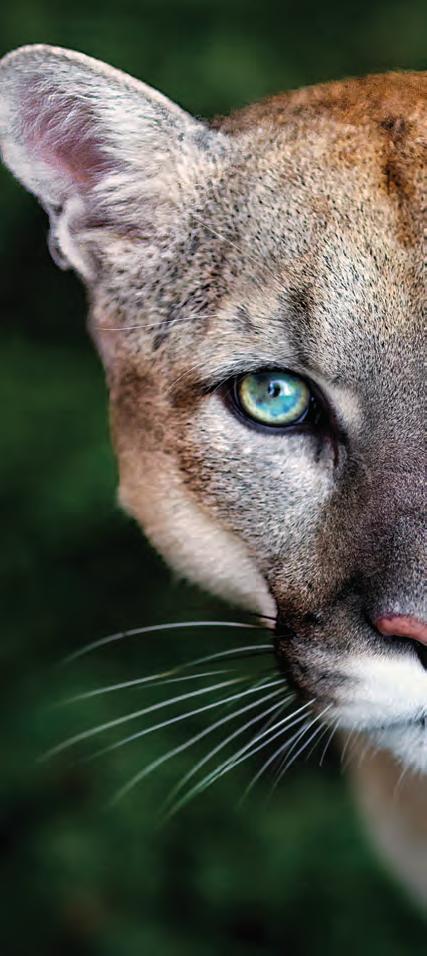

Cougar® is noted as the premium paper of choice for conveying emotion and creating memorable experiences. With three luxurious finishes, two colors, matching envelopes, an extensive digital offering and a vast array of sizes and weights, Cougar is a powerful way to bring your project to life.

Request your copy of the new Cougar Paper Trails series. bit.ly/3tJmmh8

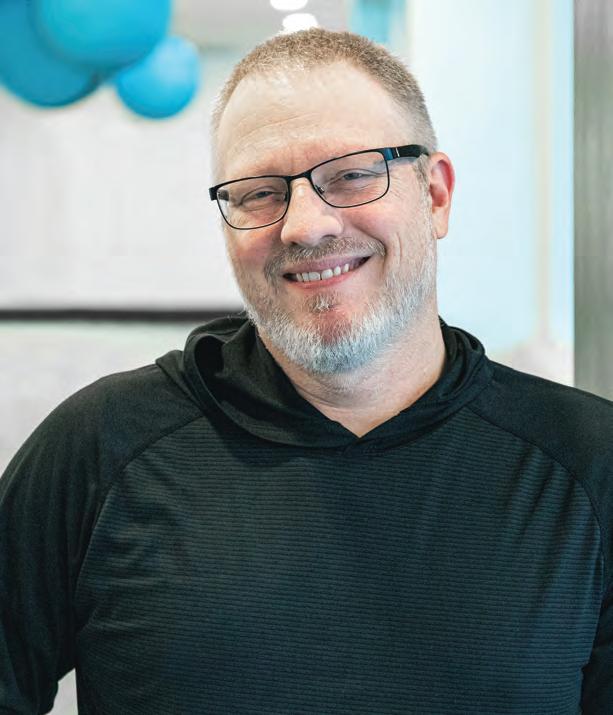
ERIC EJCHLER
CREATIVE DIRECTOR SPECTRUM BRANDS, ST. LOUIS MO
Eric Ejchler is an award-winning designer and creative director whose passions include his family, his team, collaborating with internal partners and bringing the brand story to life.
With nearly 25 years of industry experience, 22 of those at Spectrum Brands, Eric leads the inhouse creative team responsible for packaging, displays, point-of-purchase and print materials to support its pet care and home care brands.
The team boasts over 50 awards for packaging and branding over the past five years. From creative conception and brand presence, to writing and editing, to production art, prototyping and prepress, they use their decades of combined expertise to drive visual brand strategy and results.
As a leader, Eric values the roles that individual personal experiences, interests, side projects and beliefs play in allowing us to inspire and motivate each other. He believes these factors mold our ability to be better strategic thinkers and more empathetic visual storytellers. As a husband, father and designer, Eric’s love for packaging and the joy he finds in
holding design in his hands shapes his attention to every detail, frames his mindset toward storytelling, and inspires him to seek ways to deliver magic to timelines, brands and consumers.
As we pivot into a post-pandemic era marked by societal challenge and change, are you optimistic about the future of Graphic Design to support and shape commerce, culture and causes? Why do you feel the way you do? Are you optimistic about the future of your own firm?
Graphic design is everywhere. It’s in storefronts, street corners, road signs and media. It’s in packaging, websites, palms and on desktops. It’s individuals and teams passionate about communication, creating, crafting a message, and reaching people in meaningful ways. That passion makes me optimistic about graphic design and its ability to promote change now and into the future. And passion makes me optimistic about my business’s future as well. The passion and strength of my team makes me proud to be part of a group that supports and trusts each other without fail and consistently rallies to pull off what seems impossible.
We are seeing an increased focus on Package Design to advance the brand, tell the story, amplify the experience, forge an emotional connection. Do you agree with this observation and, if so, what advantages does packaging have over other graphic communications?
Although package design is extremely important to the story, I believe we’re seeing an overall increased focus on the entire brand and shopping experience. True, at physical shelf the package must wholly tell the brand and product story, help overcome tighter inventory controls, win the battle of limited space, and meet sustainability objectives that introduce new complexities. But forging a bond is more than great branding and visual storytelling on pack. Package and digital design influence and propel each other in interactive and complementary ways now more than ever. Delivering great package design requires all the puzzle pieces to fit seamlessly. There is no opportunity to evoke emotion without collaboration of all stakeholders and external partners to further the overall brand and shopping experience.
24 GDUSA 2024 | PEOPLE TO WATCH
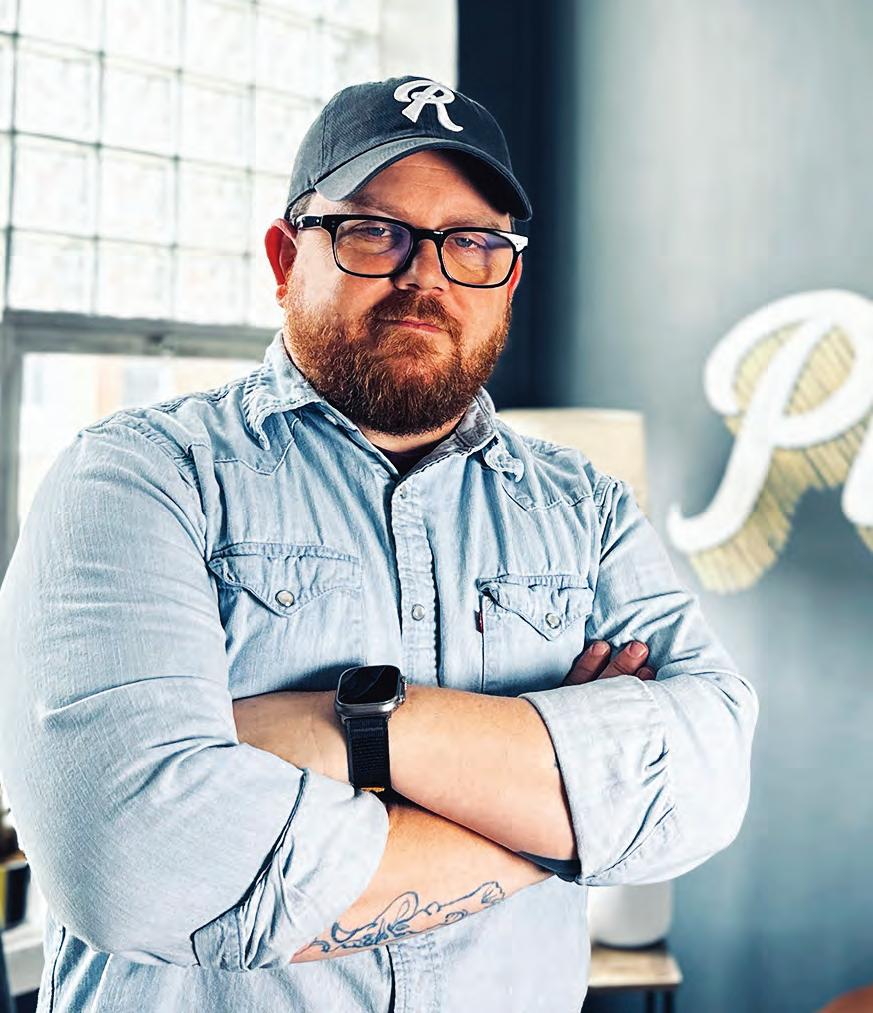
BRAD STONEKING
PRINCIPAL CREATIVE PIEDMONT BRAND CO., WILLOW SPRING NC
Brad Stoneking is a lot of things. He’s a dad, a husband, karaoke god, agent of chaos, and, of course, a Graphic Designer.
Starting out as a poster designer in 1998, Brad has spent the last 25 years growing his talents and reputation as a creative savant, working for multiple agencies, across various industries, all while building a solid freelance roster.
In 2020, at the height of a global pandemic, Brad decided to leave agency life behind, and set out on his own, under the banner of Piedmont Brand Co. Brad lives by the creed that "Everyone deserves good design," a principle that fuels his small-yet-fierce agency. As such, he champions accessible and impactful design, specializing in brand identity, illustration and packaging.
His design work has been recognized nationally and has been showcased in publications, including GDUSA. In 2016 he co-founded Last Friday
in Clayton, a monthly community event that celebrates local art and culture. Brad is also an active participant in many design conferences across the country, including Crop Cons, where he will be the Emcee in 2024.
TL;DR: Brad is a designosaur on a singular mission: to build an agency that stands as a testament to good design and to the timelessness of creativity.
As we pivot into a post-pandemic era marked by societal challenge and change, are you optimistic about the future of Graphic Design to support and shape commerce, culture and causes? Why do you feel the way you do? Are you optimistic about the future of your own firm?
I feel that proper craft and an understanding of design fundamentals has taken a back seat to mass-produced, disposable moments of content. We, at Piedmont, believe that good design will always push commerce, culture and causes forward, but good design requires understanding the “WHY” so you can execute the “HOW.” As long as humans rely on visual communication, Graphic Design will endure. As long as I can hold a pencil, Piedmont will endure. But I worry for those who are quick to call themselves graphic designers without a firm grasp of the fundamental principles of design.
We are seeing an increased focus on Package Design to advance the brand, tell the story, amplify the experience, forge an emotional connection. Do you agree with this observation and, if so, what advantages does packaging have over other graphic communications?
The rumors are true. Package design is going through a renaissance right now. Long before the internet, we used to have to leave our homes and physically buy things to make a connection with packaging, but now there are entire YouTube channels dedicated to the unboxing experience. For me, the ones that stand out most are the projects where the package gets to enjoy a life beyond delivery, like a seemingly innocuous cell phone box that converts into a nightstand dock, or a food package that has sunflower seeds embedded in the biodegradable container. I firmly believe that creating a tactile response is vital to building an authentic brand. In an age where advertising focus tends to be digital-first, I feel that brands that lean into curated experiences with thoughtful packaging will have a deeper, more meaningful connection with their intended audience.
GDUSA 25

DAVID MCCLINTON DESIGNER
dm DESIGN, AUSTIN TX
Dave McClinton has worked in the design industry for 25+ years, gaining experience in print, digital and brand design. That knowledge and drive has been earned within the publishing world, tech startups, and design studios. As an accomplished senior designer, he is passionate about advancing the strategic value of smart design.
Logo design and developing the visual aspects of brand communications for individuals, businesses and nonprofits is his current sweet spot. Dave’s work as a graphic designer has been to communicate quickly and efficiently through logo and branding work. That economy of message can be applied to art. In addition to continually serving design clients, he is also an emerging artist who has exhibited highly personal work for the last few years. And it’s not an either-or situation as Dave will happily continue to pursue challenging creative outlets of all sorts. making good in the world.
As we pivot into a post-pandemic era marked by societal challenge and change, are you optimistic about the future of Graphic Design in supporting and shaping commerce, culture and causes? Why do you feel the way you do? Are you optimistic about the future of your own design career or business?
Shaping culture and causes is what design has always done. I’ve witnessed the slow crawl of influence over years (pre internet), to the instantaneous delivery of an impactful message in today’s media landscape. With Graphic Design being firmly seated as a factor regardless.I believe design should be seen as an integral part of the strategy of building a message or supporting a cause. Lack of attention to the power of design can be expensive. Making the extraordinary communicate as attainable, the inexplicable read as tangible. It’s what we do.I have engaged with more people who understand that design is strategic, not just decoration. Nonprofits, state agencies and small businesses all want to be more presentable and professional when facing their audience. Having a clear voice in this evolving era of communications is being valued which means the future can be bright for the design industry.
We are seeing an increased focus on Package Design to advance the brand, tell the story, amplify the experience, forge an emotional connection. Do you agree with this observation and, if so, what advantages does packaging have over other graphic communications?
As a design insider, I’m still susceptible to a beautifully designed package. I understand how the use of color, font, and texture are manipulating me. There are products I do not want that will have me lingering in an aisle, admiring the design. I’ve purchased coffee drinks, I suspected would taste awful, because of the way the bright orange text popped of that dark brown background with the textured paper… whew. Anyway, who among us hasn’t purchased wine based on the label? Because we have become accustomed to shopping online, even for groceries, package designers are trying harder to engage us with touch. To reward the experience when we’re there in person. And, if shipping the product is the main interaction, often the unboxing experience is better than we might have expected. Art directed product photography, tactile satin papers and high-end boxes can make the consumer feel as if they’ve been let into a club. Bios of the makers, or anecdotes about the original users of the product turn the package into a vehicle for a story. Modern consumers are bored, cynical and need to be wooed. Packaging that succeeds in the “pick me up” game has a huge advantage over their competition.
26 GDUSA 2024 | PEOPLE TO WATCH

IAN MONTGOMERY
FOUNDER/CREATIVE DIRECTOR
GUACAMOLE AIRPLANE, SAN FRANCISCO CA
Ian Montgomery is the Founder and Creative Director of Guacamole Airplane, a San-Francisco based design agency focused on sustainable packaging. Guacamole Airplane's general projects cover structural packaging design and sustainability consulting, and their clients include Harry's, Nike, Whole Foods, and Dell. Ian did his undergraduate coursework in Environmental Science at Stanford and masters work in Packaging Design at Pratt, and his studio pursues work from a shared interest in sustainable material innovation, packaging manufacturing, origami, climate science, 1970’s hippie modernism, and the unique opportunities of modern industry to work towards decarbonization.
As we pivot into a post-pandemic era marked by societal challenge and change, are you optimistic about the future of Graphic Design to support and shape commerce, culture and causes? Why do you feel the way you do? Are you optimistic about the future of your own firm?
I’m incredibly excited about this new era of sustainable material innovation. The investment and advancement we’re seeing with new plastic alternatives, biofoams, coatings, and fibers is astounding. After WWII, a similar explosion of new materials, namely plastics, gave architects, product designers, and packaging designers completely new building blocks to radically reshape society. This decade’s designers are the first to have access to a completely new suite of biomaterials that will similarly reshape the world, ideally tempered with a bit less overconsumption. Yvon Chouinard said “do no unnecessary harm”, and that’s about the best we can aim for, luckily for us designers low carbon or even carbon-negative polymers, paperstocks made from agricultural waste instead of virgin pulp, bio based films, and low carbon methods of manufacturing have opened to doors for truly thoughtful products that wouldn’t have been possible even ten years ago. I’m optimistic about the future of design, so long as young designers take the time to educate themselves about the ecological implications present in their mass produced work. Paul Hawken’s “Drawdown”, Brian Dougherty’s “Green Graphic Design”, and Tom Szaky’s “The Future of Packaging” are books I suggest to design students to read.
We are seeing an increased focus on Package Design to advance the brand, tell the story, amplify the experience, forge an emotional connection. Do you agree with this observation and, if so, what advantages does packaging have over other graphic communications?
Packaging is unique in that it’s both a functional protective vessel and an emotive canvas for graphic messaging. We’re not super conscious of graphic trends in our work, but instead we have more of a form follows function approach, working with new substrates like seaweed films, algae inks, and agricultural waste papers to see what unique low impact forms and printing styles we can accomplish in the context of large scale manufacturing while doing the least possible harm.
GDUSA 27


Pride and passion in premium.
Sterling® Premium is crafted in America with pride by people who bring generations of papermaking skill and passion to every product we make. Engineered for next-level consistency, Sterling Premium offers quality, printability and sustainability. Available in matching digital and offset sheets, Sterling Premium is made using 10% recycled fiber carrying three chain-ofcustody certifications. All of this backed by service and support as strong as our passion for paper.
Sterling Premium. An American classic.
©2023 Billerud Americas Corporation. All rights reserved.
Billerud Americas Corporation 8540 Gander Creek Drive Miamisburg, Ohio 45342 800 258 8852 billerud.com

JAY BYRNES
DIRECTOR OF BRAND, MNML, CHICAGO IL
Jay leads the brand practice at MNML. He plays a critical role in helping companies connect strategy with design to drive real business impact. Jay has crafted memorable brand experiences across traditional and digital platforms in a breadth of industries from healthcare and commercial real estate to fashion and non-profit for clients like Google, Meta, Sterling Bay, Bose, Coca-Cola, Acadia Pharmaceuticals, and the Museum of Science and Industry. Jay ran an independent streetwear brand for over a decade and brings expertise in brand identity and visual systems accompanied by integrated campaigns. His personal creative work can be seen at adapt-studio.com and on IG at @fourthisking. He believes in the power of curiosity, data and analytics, collaboration, and human connection.
MNML collaborates closely with startups and Fortune 500 companies, crafting solutions that establish emotional connections with consumers, ultimately amplifying our clients’ and partners’ value. Our clients include renowned names such as Meta, Bose, Bang&Olufsen, Nespresso, Steelcase, Theragun, and Xbox, showcasing our ability to create beautifully simple solutions that harmonize brand, strategy, industrial design, engineering, and digital, resulting in exceptional customer experiences.
As we pivot into a post-pandemic era marked by societal challenge and change, are you optimistic about the future of Graphic Design in supporting and shaping commerce, culture and causes? Why do you feel the way you do? Are you optimistic about the future of your own design career or business?
Cautiously optimistic! There will always be a need for companies, communities, and causes to express who they are and why they are different. And do it in a way that connects personally with their audiences. MNML is a special place. Not only are we independently owned, but we are a small team of multidisciplinary veteran experts. We are unique in that we overlap design across both product and brand. We have built and launched many of our own companies which helps us understand and anticipate our clients’ needs. That being said, surviving as a small design business is getting much harder. Clients’ budgets and timelines are tighter. As we look ahead, we will continue to thrive because we are scrappy, we value our client relationships, and consistently overdeliver. It’s the only way we know.
We are seeing an increased focus on Package Design to advance the brand, tell the story, amplify the experience, forge an emotional connection. Do you agree with this observation and, if so, what advantages does packaging have over other graphic communications?
When buying in person, packaging design grabs attention and can convert a sale. However, with the surge in online shopping, the sequence of the packaging experience often shifts to post-purchase. Now, it's about enhancing the unboxing, ensuring smooth usability, and injecting a narrative that surprises and delights—creating something special that customers can't help but share. Eco-friendly materials and refills continue to be priorities, and digital and AR storytelling can add an innovative layer. Current trends favor bold colors, character illustrations, retro typography, foils, and embossed prints.
30 GDUSA 2024 | PEOPLE TO WATCH
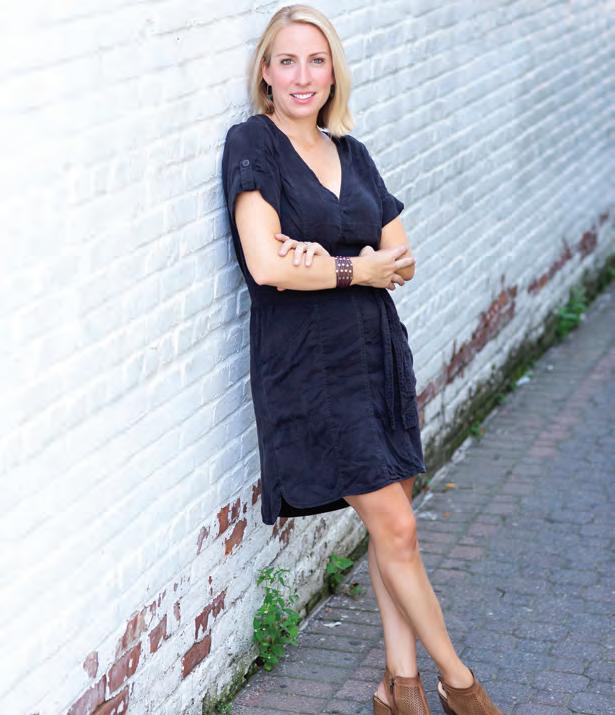
DENISE DELANY
DESIGN LEAD, HELLO PRODUCTS, MONTCLAIR NJ
Denise Delany is focused on creating a distinctive brand world with a unique vibe and clever moments of magic sprinkled throughout. The magic happens alongside a brilliant group of curious and friendly team members spanning each category of the hello brand who seek to elevate the everyday in oral and personal care routines. As the new kid on the block at Colgate-Palmolive, hello is in the midst of exciting growth and change. Inspired by the abundant energy, close collaboration and the entrepreneurial spirit of the team, Denise is excited to continue transforming the brand in sophisticated and unexpected ways.
Her love of crafting compelling brand stories through innovative packaging design for some of the world's top beauty, food and beverage brands spans 20+ years. From cereal box redesigns to custom fragrance bottles, Denise has consistently led with a clean, modern aesthetic and true passion for bringing brands to life. Prior to joining hello, she spent 12 years with Bath & Body Works, where she drove thoughtful, strategic design across the brand’s largest body care portfolio, including many iconic fragrances such as Japanese Cherry Blossom. As a team leader, Denise imagined countless new fragrance launches and oversaw the redesign of the entire Signature Collection, including new structure and visual identity.
She is constantly in search of new ways to approach design, always inspired by the world around her and truly committed to making a brand shine.
As we pivot into a post-pandemic era marked by societal challenge and change, are you optimistic about the future of Graphic Design in supporting and shaping commerce, culture and causes? Why do you feel the way you do? Are you optimistic about the future of your own design career or business?
Absolutely. Design influences and informs everything around us. It has the ability to teach us through clear, concise messaging, it can capture our attention with bold, unexpected mashups and it can simply make us smile with a witty graphic or a clever design wink. The power of design is truly endless. At hello, our passion for the brand is a constant source of inspiration and drives us to be curious, brave, and bold in our decisions. It is truly a pleasure to go to work each day to see what we can dream up next.
We are seeing an increased focus on Package Design to advance the brand, tell the story, amplify the experience, forge an emotional connection. Do you agree with this observation and, if so, what advantages does packaging have over other graphic communications?
Brand and packaging design are truly my first love. It has always been fascinating to me that a brand’s essence and personality can be conveyed through one single package. That one package has the power to stop a consumer in their tracks, invite them to pick it up and begin a journey with a new brand, simply by a vivid color choice, a unique pattern, a fun name or even a clean, simple and sophisticated tube like hello. I strive not only to deliver a memorable package design, but also create moments of magic by adding some yay into the everyday, which is needed now more than ever in these hazy post pandemic times.
GDUSA 31
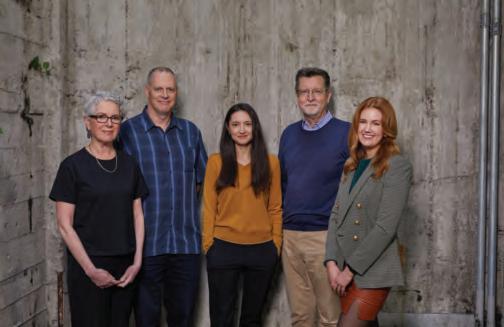
LORI MURPHY ROB KEIL
JULIA GAUGER DAVID GAUGER
JENNA PILE
CREATIVE LEADERSHIP TEAM
GAUGER & ASSOCIATES, SAN FRANCISCO CA
The secret to a half-century of success is design agility.
Gauger + Associates is an award-winning advertising and design firm. The studio works with start-ups, non-profits, and some of the nation’s leading brands to define strategies and implement unexpected thinking to help clients grow and prosper.
The agency was co-founded by Creative Director David Gauger 50 years ago. Lori Murphy, Senior Art Director, and Rob Keil, Associate Creative Director, help lead the creative team, while Julia Gauger, Vice President and Account Director, provides strategic vision.
The team has helped create numerous category leaders through effective brand strategies, positioning, naming, package design, advertising, website creation, media planning, public relations, and social media. Through this work, Gauger has developed a clear process that unfolds logically from extensive information review to creating strategic and impactful communication. The creative goal is to consistently surprise and delight.
As we pivot into a post-pandemic era marked by societal challenge and change, are you optimistic about the future of Graphic Design in supporting and shaping commerce, culture and causes? Why do you feel the way you do? Are you optimistic about the future of your own design career or business? There is a greater awareness than ever that we must create products and messages that support healthy lifestyles and environmental sustainability. That is a primary focus of our designers and the studio. The goal of every assignment is not only to create clear communication but to add value to our client’s products and their customer’s lives. We do this based on a philosophy of constant evolution. Over the past 50 years, we have successfully packaged and launched hundreds of products because we embraced change and have evolved to meet cultural transitions. We are in the idea business, and while AI is a new and important tool in our arsenal, we use it and all the other tech tools to bring our ideas to life.
We are seeing an increased focus on Package Design to advance the brand, tell the story, amplify the experience, forge an emotional connection. Do you agree with this observation and, if so, what advantages does packaging have over other graphic communications? When we design a package, we develop a strategic visual language that we extend to all other marketing materials. We focus on how it will compete and stand out against competitor products on the shelf and online. We also consider its use in the home as an extension of the consumer's values and part of who they are. We also think about the environmental impact of packaging and how that impact can be reduced. How the product and package can have a synergistic relationship is most important to us
32 GDUSA 2024 | PEOPLE TO WATCH
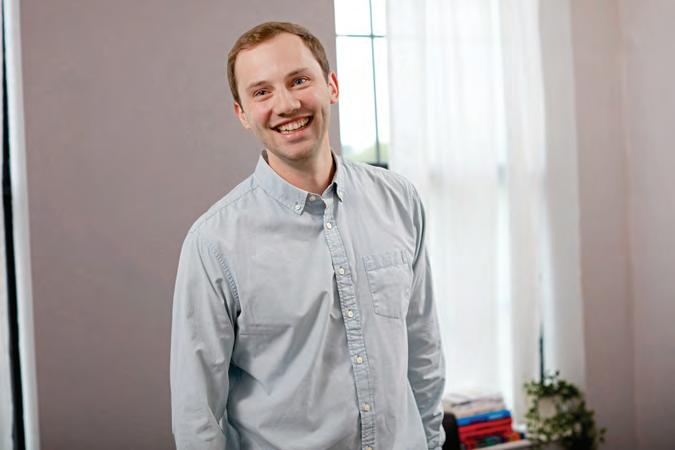 JOSHUA TYNER
JOSHUA TYNER
CREATIVE DIRECTOR/SENIOR PARTNER QUILL CREATIVE, OSHKOSH WI
Joshua Tyner is an experienced branding and design professional who has been developing and implementing brand strategies for over 15 years. He founded Quill Creative in 2015, where he leads a team of talented designers and strategists who have helped numerous businesses, from startups to Fortune 500 companies, create strong brand identities, position themselves effectively in the market, and design memorable brand experiences.
Joshua's areas of expertise include strategic messaging, corporate identity, package design, and government proposal responses. He has a proven track record of success in developing and implementing impactful branding strategies that resonate with target audiences.
Quill Creative is a full-service branding and creative agency that offers a comprehensive range of services, from brand strategy and identity development to website design and packaging design. We believe that every brand has a unique story to tell, and we are committed to helping our clients find their voice and share it with the world. We take pride in working with a variety of clients, such as Oshkosh Corporation, Great Northern Corporation, Good Foods, and Feeding America. We are passionate about building long-term partnerships with our clients and helping them achieve their branding goals.
As we pivot into a post-pandemic era marked by societal challenge and change, are you optimistic about the future of Graphic Design in supporting and shaping commerce, culture and causes? Why do you feel the way you do? Are you optimistic about the future of your own design career or business?
The future of graphic design seems to be very bright and more important than ever. As our society continues to change its views and values, design will play a
pivotal role in establishing brands and causes in a very competitive space. Design that is purposeful and personal will be critical to creating genuine connections and ultimately shaping our perceptions in the long term. At Quill Creative, we are receiving more requests from brands that want to tell their stories with intent and build relationships with customers based on shared values. With such objectives, our work is becoming increasingly collaborative with brands and we are designing unique brand systems that permeate throughout organizations from the ground up.
We are seeing an increased focus on Package Design to advance the brand, tell the story, amplify the experience, forge an emotional connection. Do you agree with this observation and, if so, what advantages does packaging have over other graphic communications?
We have noticed that brands are increasingly focused on the design of their packaging as a way to create a stronger emotional connection with their customers. With the rise of new media forms and an increasingly crowded marketplace, packaging will continue to be a key area of focus for brands. Packaging has a unique advantage over other forms of communication, due to its physical nature and tactile experience. However, due to the multitude of sales and distribution methods available the need for packaging to be tailored and personalized has risen. This presents great design opportunities and poses great challenges in utilizing the physicality in a meaningful way, across many variations, while maintaining brand integrity and consumer connection. From a trend perspective, there is a high demand for sustainable materials and repurposable structures in packaging design. These types of packaging offer fantastic design opportunities as they can serve multiple purposes. We are seeing some of the best work done when brands design their packaging to communicate effectively and resonate with the audience throughout the entire lifecycle.
GDUSA 33
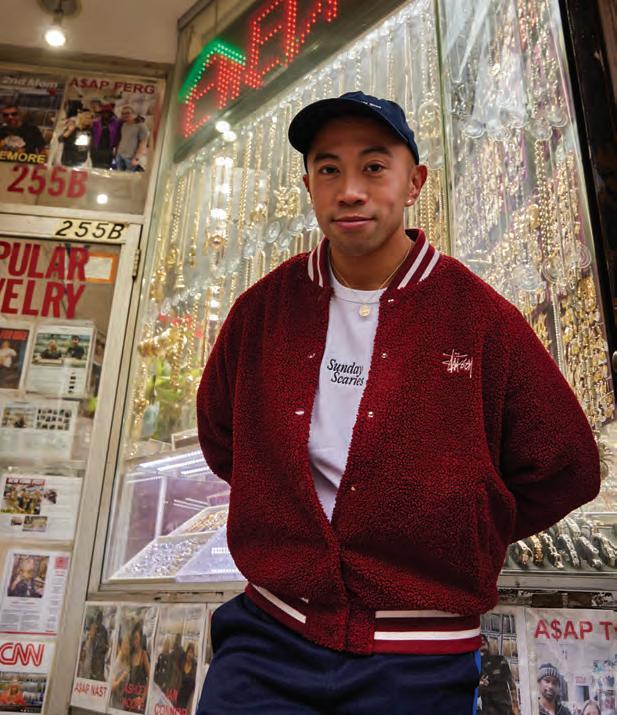
RICH TU
PARTNER/EXECUTIVE CREATIVE DIRECTOR
SUNDAY AFTERNOON, NEW YORK NY
Rich Tu is a first generation Filipino-American and award-winning designer and artist residing in Brooklyn, NY. He is a Partner and Executive Creative Director at Sunday Afternoon. Previously, Rich has held creative leadership roles at Jones Knowles Ritchie, MTV Entertainment Group, and Nike Inc.
In addition, he hosts the Webby-honoree podcast "First Generation Burden", which focuses on intersectionality and diversity within the creative industry, and is co-founder with The One Club for Creativity of the COLORFUL grant program, dedicated to creating opportunities for early career BIPOC creatives.
Rich is a graduate of SVA’s Illustration as Visual Essay MFA program. He has previously won the ADC Young Guns award and recently received the prestigious Paul Manship Medallion for significant contributions to the Art Directors Club and creative industry. Creatively, his focus is on emerging audiences and energetic brands that benefit from an eclectic and unique point of view.
Awards and honors include: ADC Annual Awards, D&AD, Webby Awards, Telly Awards, CLIOs, Cynopsis D Awards, PromaxBDA, The Shorty Awards, Power of Purpose Award, New York Festivals, ADC Young Guns, PRINT Magazine, American Photography, American Illustration, and The Society of Illustrators among others.
Clients and collaborators include: The New York Times, The New Yorker, MINI, NIKE, A24, Budweiser, Paramount, Adidas, Converse, G-Shock, American Express, NPR, NorthFace Purple Label, Coca-Cola, Verizon, Skype, Fuse TV, Alfa Romeo, Bombay Sapphire, and Hamilton The Musical, among others. Also, he has exhibited at galleries and festivals in New York, Los Angeles, Berlin, and Miami.of design, the strength of strategy and a desire to be exceptional.
As we pivot into a post-pandemic era marked by societal challenge and change, are you optimistic about the future of Graphic Design in supporting and shaping commerce, culture and causes? Why do you feel the way you do? Are you optimistic about the future of your own design career or business?
I’m definitely optimistic about Graphic Design’s ability to create change. When we look back on history, visual culture has been shaped by images that communicate with intent. The challenge is when the creative community places the practice of design above the communication itself, and the output loses purpose, and therefore becomes ephemeral (which I’m cool with). I’m always shifting and pulling myself in unexplored directions in my own career. Design has given me a platform to present my ideas, whether the output is design-based or not. At the end of the day, my goal is to communicate, and to do so with impact. As long as there are creative problems to solve in the world, I know there will be a place for me.
34 GDUSA 2024 | PEOPLE TO WATCH

MARK CHRISTOU
PRINCIPAL, CBX, NEW YORK NY
Mark is looking to the future with senior leaders and collaborating with the CBX team, who are equally as passionate about creative as he is.
Before joining CBX, Mark was the Founder and Creative Partner of ROOK/NYC as well as the Founder & Partner of R/Co Ventures – a venture group established to invest in CPG companies that require expert brand and capital partnership.
Mark is deeply passionate about partnering with and investing in CPG brands and their founders to effectively communicate their unique core purpose, vision, and value proposition through strategic thinking and disruptive creative that drives growth. It’s through this vision of building true partnership that he has been approached to co-found and co-create a number of brands including Love Corn, a premium crunchy corn snack, Culture POP Soda, a probiotic soda with unique flavor profiles and Avuá Cachaça, a hand-crafted, single-sourced Brazilian rum.
Mark has nearly 20 years of experience in the creative industry both in London and New York. Prior to founding ROOK his roles included Creative
Director at Sundial Brands, and Pearlfisher New York, Design Director at The Brand Union (Superunion), and Designer at Pearlfisher London.son Coors, General Mills, Pfizer, Unilever, and Hershey’s. His work has been recognized by major US and international design and packaging awards programs.
As we pivot into a post-pandemic era marked by societal challenge and change, are you optimistic about the future of Graphic Design to support and shape commerce, culture and causes? Why do you feel the way you do? Are you optimistic about the future of your own firm?
Having a brand expert partnering with you to help you grow internally and externally remains essential. As far as (perceived) threats around AI, things are still playing out. And for now, this is another tool—another team member, if that makes sense. Helping us do what we need to do. But hands down, the need for strategic brand expertise will always be here.
We are seeing an increased focus on Package Design to advance the brand, tell the story, amplify the experience, forge an emotional connection with consumers at the moment of truth. Do you agree with this observation and, if so, what advantages does packaging have over other graphic communications?
In our field, everyone obsesses over the 10/5/2 rule when it comes to nailing packaging, and ultimately driving sales. But the reality is that there’s the 30,000-foot view. The bigger picture. Because if you don’t have great packaging, great storytelling and great interaction—tapping into emotion—things won’t sell. Packaging is only one touchpoint of a brand’s ecosystem. And the best branding experts consider the wholistic brand, not just the packaging. It’s the “red thread” which surrounds an entire brand, and you’ve got to nail it all. The way we see it at CBX, great package design is becoming table stakes, such that if you don’t have great packaging, you don’t get the opportunity. But if you don’t have a great product, your consumer won’t dig further. Which means you’re selling your brand short.
GDUSA 35
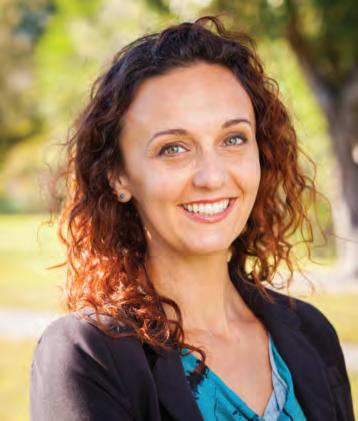
LAUREN CASGREN-TINDALL
PRINCIPAL, CRÈME DE MINT, MIAMI BEACH FL
Lauren’s love for design was initially sparked by her curiosity for costume design. Fast forward to working at the Old Globe Theater and On and Off Broadway, where she learned everything she could about composition and presentation. Returning to San Diego City College for graphic design, she discovered her true calling, going on to create branding and packaging for companies such as Avon, Victoria’s Secret, and Bliss, as well as consulting in Australia, the UK, and the Netherlands.
In 2010, she founded her own creative agency, Crème de Mint, to give herself the freedom to work while traveling (a novel idea at the time) and to allow her to combine her design expertise with her passion for coaching entrepreneurs through the process of launching or growing their business.
Lauren has successfully guided clients through impactful rebrands, resulting in significant growth in their retail presence and considerable revenue gains. With a background in design and a portfolio featuring collaborations with renowned icons like Fergie and Reese Wither-
spoon, along with the launch of her own makeup brand, Lauren brings a wealth of experience to the table.
As we pivot into a post-pandemic era marked by societal challenge and change, are you optimistic about the future of Graphic Design to support and shape commerce, culture and causes? Why do you feel the way you do? Are you optimistic about the future of your own firm?
In the post-pandemic era, I am optimistic that conveying powerful messages makes it a crucial tool for shaping commerce, causes and culture. I believe graphic design can play a pivotal role in fostering positive change. I also feel a level of uncertainty as well in regards to AI and the economy. I feel that the outlook for my design agency will depend on our ability to innovate, adapt to emerging trends and embrace new tools.
We are seeing an increased focus on Package Design to advance the brand, tell the story, amplify the experience, forge an emotional connection. Do you agree with this observation and, if so, what advantages does packaging have over other graphic communications?
Packaging holds several advantages over other graphic communications. It is a tangible and immediate touchpoint for consumers, and remains a continuous presence in their lives, delivering its brand message from where it sits on a kitchen counter or bathroom vanity. As far as notable trends in package graphics, there is a clear emphasis on sustainability, with a shift towards biodegradable materials and zero-waste policies. Interactive elements, such as QR codes and augmented reality, are gaining prominence. In terms of package production, there is a focus on e-commerce optimized packaging to meet the demands of online shopping, as well as an integration of smart packaging and technology to provide consumers with experiences and additional information. Additionally, AI is expected to help reduce material usage and track recycling, analyze consumer data to tailor designs for specific demographics, and enable personalized packaging for individual customers.
2024 | PEOPLE TO WATCH 40 GDUSA

CHRISTIAN CABRERA
HEAD OF VISUAL AND GRAPHIC DESIGN G&A, WASHINGTON DC
Christian Cabrera is the Head of Visual and Graphic Design at design studio G&A – an interdisciplinary firm specializing in story-driven, community-centered experiences. His dedication to craft has fueled the team’s award-winning work across G&A’s portfolio of cultural, entertainment, and corporate clients.
Over a career steeped in design, Christian has championed a multidisciplinary approach, incorporating elements of art, graphics, materiality, and immersive media to shape experience. His creative curiosity served him well, sharpening his skillset as he worked everywhere from small bespoke design studios to global architectural firms like Gensler. But it was at G&A where he found a uniquely collaborative spirit, working together to build beloved experiences for the Chicago Architecture Center, Capitol Visitor Center and the United States Olympic and Paralympic Museum.
Christian believes the power of design lies in its broad reach, creating spaces that increase community-building, foster cultural understanding and elevate the human experience.
As we pivot into a post-pandemic era marked by societal challenge and change, are you optimistic about the future of Graphic Design to support and shape commerce, culture and causes? Why do you feel the way you do? Are you optimistic about the future of your own firm?
Like any discipline, we can be a force for good or for bad. I think the one thing we’re uniquely positioned to champion is the idea of clarity. There is so much noise in our environment: in the physical world, in the digital space, and even in our heads. The heart of what we do is to communicate: a feeling, a message, an ideal, so that people understand. If we can look at our work with the goal of minimizing the noise (or to amplify a thing that is really important), then we can be a positive force for culture and understanding.
We are seeing an increased focus on Package Design to advance the brand, tell the story, amplify the experience, forge an emotional connection. Do you agree with this observation and, if so, what advantages does packaging have over other graphic communications?
Packaging design is not a discipline we dive into too much as an experiential design firm. I spent my early years as a print designer so I definitely appreciate the creative approaches to creating something memorable. I think overall people want experiences that are designed to last. I also have mixed feelings about consumables in general, as a ‘throw-away’ piece feels antithetical to the intent of design. To that end, creating packaging or materials that can work as a keepsake, to extend the life of an object, should be top of mind. There is no such thing as sustainable swag.
GDUSA 37
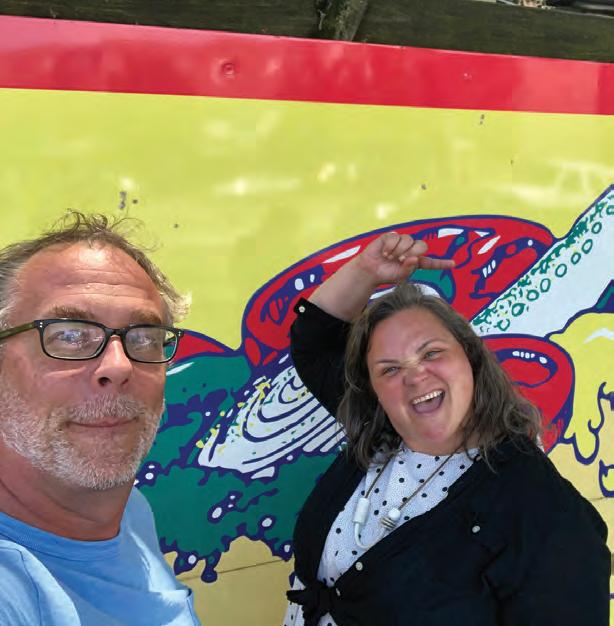
BRYAN VANDERWARKER KRISSY VANDERWARKER
FOUNDER/PRINCIPAL + VICE PRESIDENT SEEDHOUSE, CHICAGO IL
Sibling duo, Bryan and Krissy, have been in brand identity and packaging design (and Chicago-style hot dog enthusiasts) for 20+ years. They grew up in a Chicago advertising family where big ideas, creative solutions and entrepreneurism were prized.
Bryan has been on both client and agency sides, and brings a varied set of skills in operations, management & marketing while Krissy brings a storytelling and theater background to all engagements. Both were former Planners (consumer insights/research) working with large, multinational CPG brands prior to Seedhouse and leverage that experience to help brands better compete in the marketplace.
Started in 2010, Seedhouse is an independent brand & packaging design firm that delivers big agency results, an all-star ‘A-team’ and full access to clients. The majority of its clients, and many of the prospects that were pitched but not won, come back to Seedhouse again for additional work/opportunities.
As we pivot into a post-pandemic era marked by societal challenge and change, are you optimistic about the future of Graphic Design in supporting and shaping commerce, culture and causes? Why do you feel the way you do? Are you optimistic about the future of your own design career or business?
It’s human nature to believe that we are at the precipice of the end of the world. Fortunately, as designers, we somehow summon enough optimism (or ego) to believe that we can make it all work a little better in the meantime. We are very optimistic about the business of design and how we participate in that because we get to tell awesome stories that help people connect with things or services they need or want. Understanding how people make decisions and the context in which those decisions are made is a crucial part in designing a better future. Solving creative challenges and giving back to the planet makes work feel like play (Seedhouse is a member of 1% for the Planet). Ultimately, we are optimists - about the future, our abilities to solve problems & create opportunities, the economy, the way consumers interact with our designs, our clients’ intelligence & trust, the ability to see change and the effect that good design can have on almost anything. Seriously.
We are seeing an increased focus on Package Design to advance the brand, tell the story, amplify the experience, forge an emotional connection. Do you agree with this observation and, if so, what advantages does packaging have over other graphic communications? Packaging is crucial in creating an emotional connection to the brand. It’s a brand’s silent salesperson and one of the few mediums that your customer will see 100% of the time, gets in their hand and goes home with them. In an increasingly noisy and digital world, packaging has a weight, a reality, a haptic sensibility that can cut through. Brands need to stay attuned, adjust accordingly and fend off competitive pressures. Evolution is hungry, and good design champions margins, positions and goals. We’re most excited these days by the challenge of a DTC brand moving to retail. A retail package has to do much heavier lifting while not crushing the soul and spirit that the DTC brand built their business on.
38 GDUSA 2024 | PEOPLE TO WATCH

LAURA ROSENBERG
FOUNDER/CREATIVE DIRECTOR
TIARA AGENCY, NEW YORK NY
Laura Rosenberg is a designer and illustrator turned marketing and creative leader, and the Founder and Creative Director of Tiara Agency.
She has led and designed for in-house multidisciplinary teams across the beauty, CPG, retail, fashion, and non-profit industries – and brings this broad expertise to her clients at Tiara Agency. Laura’s creative for Mars Chocolate, Coty, Johnson & Johnson, Godiva, McCormick, Marc Jacobs, Emory University, Bloomingdale’s, and many more brands can be seen on shelf, online, in print and in your home.
Laura infuses her work with a unique blend of traditional, digital, strategic, and analytic skills. From lending a whimsical flair to an illustration, adding a luxurious feel to a product, expanding the reach of a campaign, to crafting a unique voice and positioning. Her deep technical knowledge also guides Tiara Agency’s production and web development teams, bringing a complete “concept through production” experience to their clients. Laura’s right- and left-brain approach truly covers every aspect of a brand.
In addition to GDUSA, Laura has also won several Cosmetic Executive
Women, The Fragrance Foundation, and New York State Council on the Arts awards and grants.
As we pivot into a post-pandemic era marked by societal challenge and change, are you optimistic about the future of Graphic Design in supporting and shaping commerce, culture and causes? Why do you feel the way you do? Are you optimistic about the future of your own design career or business?
Graphic Design will always shape the way consumers and audiences view products and campaigns. Messaging and content are the foundation of a product, and Graphic Design presents these core assets as a cohesive whole. I’m optimistic about the growth of my business and career - adaptation is a key tenet of my personal and professional view. I strive to keep abreast of new technologies and approaches, folding in additional services as needed. That’s how I turned what started as a packaging, illustration, and accessory design consultancy into a modern, 360-degree print and digital agency.
We are seeing an increased focus on Package Design to advance the brand, tell the story, amplify the experience, forge an emotional connection. Do you agree with this observation and, if so, what advantages does packaging have over other graphic communications?
Packaging can be the ultimate brand connector. It’s personal: what consumers touch, take and bring into their homes. It’s physical: they may caress the facets of a fragrance bottle, or forcefully grip a utilitarian sports drink. It’s often the only exposure to a brand without promotion: the billboard, vessel, and voice all in one. Over time I’ve observed less defined trends in packaging, similar to fashion. Social media has completely changed the game on branding, blurring trends globally. The surge of direct-to-consumer products has also blended what is expected of online vs in person packaging. It truly is an open landscape of design - more challenging, but also more exciting!
GDUSA 39

LAUREN CASGREN-TINDALL
PRINCIPAL, CRÈME DE MINT, MIAMI BEACH FL
Lauren’s love for design was initially sparked by her curiosity for costume design. Fast forward to working at the Old Globe Theater and On and Off Broadway, where she learned everything she could about composition and presentation. Returning to San Diego City College for graphic design, she discovered her true calling, going on to create branding and packaging for companies such as Avon, Victoria’s Secret, and Bliss, as well as consulting in Australia, the UK, and the Netherlands.
In 2010, she founded her own creative agency, Crème de Mint, to give herself the freedom to work while traveling (a novel idea at the time) and to allow her to combine her design expertise with her passion for coaching entrepreneurs through the process of launching or growing their business.
Lauren has successfully guided clients through impactful rebrands, resulting in significant growth in their retail presence and considerable revenue gains. With a background in design and a portfolio featuring collaborations with renowned icons like Fergie and Reese Wither-
spoon, along with the launch of her own makeup brand, Lauren brings a wealth of experience to the table.
As we pivot into a post-pandemic era marked by societal challenge and change, are you optimistic about the future of Graphic Design to support and shape commerce, culture and causes? Why do you feel the way you do? Are you optimistic about the future of your own firm?
In the post-pandemic era, I am optimistic that conveying powerful messages makes it a crucial tool for shaping commerce, causes and culture. I believe graphic design can play a pivotal role in fostering positive change. I also feel a level of uncertainty as well in regards to AI and the economy. I feel that the outlook for my design agency will depend on our ability to innovate, adapt to emerging trends and embrace new tools.
We are seeing an increased focus on Package Design to advance the brand, tell the story, amplify the experience, forge an emotional connection. Do you agree with this observation and, if so, what advantages does packaging have over other graphic communications?
Packaging holds several advantages over other graphic communications. It is a tangible and immediate touchpoint for consumers, and remains a continuous presence in their lives, delivering its brand message from where it sits on a kitchen counter or bathroom vanity. As far as notable trends in package graphics, there is a clear emphasis on sustainability, with a shift towards biodegradable materials and zero-waste policies. Interactive elements, such as QR codes and augmented reality, are gaining prominence. In terms of package production, there is a focus on e-commerce optimized packaging to meet the demands of online shopping, as well as an integration of smart packaging and technology to provide consumers with experiences and additional information. Additionally, AI is expected to help reduce material usage and track recycling, analyze consumer data to tailor designs for specific demographics, and enable personalized packaging for individual customers.
2024 | PEOPLE TO WATCH 40 GDUSA
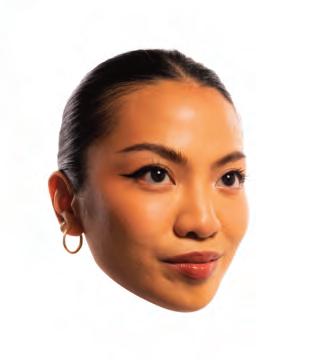
KALEB SINDAC
SENIOR DESIGN LEAD, BAKERY AGENCY, AUSTIN TX
Kaleb Sindac is a Senior Design Lead at Bakery Agency, a creative and culture agency designed to ignite brand obsession. With a focus on Packing Design and Product Innovation, she spearheaded the evolution of Shiner Beer’s packaging to reflect the multi-cultural and bold demographic landscape of Texas.
As we pivot into a post-pandemic era marked by societal challenge and change, are you optimistic about the future of Graphic Design to support and shape commerce, culture and causes? Why do you feel the way you do? Are you optimistic about the future of your own firm?
We’ve seen how graphic design plays such a pivotal role in facilitating societal change and bringing awareness, which is evident in the impactful, informational Instagram posts that emerged during the pandemic. However this isn’t an isolated instance of how powerful graphic design can be. Throughout history it’s served as a potent tool for education and advocacy in various forms. As we look into the future of how graphic design supports commerce, culture, and causes, there’s an overall collective effort to be more conscientious of where our design inspirations derive from. This heightened awareness, especially concerning cultural references, has brought on so much positive change. Designers are more inclined to do their due diligence, being more intentional in representation. This shift was catalyzed by the pandemic and various social movements that inspired a generation of designers characterized by intentionality, empathy, and heightened awareness of their environmental and social surroundings. Bakery as an agency and within the design department has done an
excellent job of upholding that practice. Our push for inclusivity and intentionality predates the pandemic, which stems from the diverse backgrounds of the team. I feel confident that we will continue to uphold and enhance these principles in the future.
We are seeing an increased focus on Package Design to advance the brand, tell the story, amplify the experience, forge an emotional connection. Do you agree with this observation and, if so, what advantages does packaging have over other graphic communications?
Great packaging design is fueled by intention. As packaging designers, we have to consider how all these various elements interact to create a visceral experience. We’re given the unique opportunity to invigorate all five senses to transport the consumer into the world we’ve meticulously crafted. Through our utilization of various printing techniques, intricate diecuts, tactile materials, and unique structures, it reminds you that you can bring life to whatever you imagine. Beyond pretty, shiny packaging, it’s an invitation to engage, play and nurture curiosity! I love seeing how the maximalist, nostalgic aesthetic continues to thrive and evolve in space. It’s really influenced all aspects of design and I don’t think it’s a “trend” that will fade away so quickly because of how it elicits such a strong reaction or memory. This trend’s sustained success speaks to how as a collective we’re yearning for more meaningful connections with the products we choose to bring into our lives.
GDUSA 41

REGINA PUNO DESIGN DIRECTOR
THE WORKING ASSEMBLY, NEW YORK NY
Regina Puno leads an NYC-based team of passionate collaborators and experts, focused on end-to-end brand building for a wide range of clients—from evolving Fortune 100 companies to trending and emerging brands. Apart from her day-to-day work, she is passionate about mentoring and advocating for young international designers as they jumpstart their careers.
Originally from the Philippines, Regina came to the US to study at Parsons School of Design. She began her career at a small design studio called Hinterland, where alongside her mentor, Scott Buschkuhl, first got to experience working in design from initial conceptualization to full execution on branding, print and digital projects for the American Museum of Natural History, The New York Times, and the School of Visual Arts, as well as smaller brands and start-ups. Regina then transitioned to work at the popular luggage startup, Away, where as an early member of their in-house design team, helped to define a visual brand identity built for scale and flexibility. She also held roles at JKR, where she worked with Planters, Burger King, and Hilton on integrated brand identities and full brand redesigns.
As we pivot into a post-pandemic era marked by societal challenge and change, are you optimistic about the future of Graphic Design to support and shape commerce, culture and causes? Why do you feel the way you do? Are you optimistic about the future of your own firm?
Absolutely. Graphic design in itself is visual communication, and to our benefit, good, thoughtful, design has become table stakes at any company, especially as a means to convey their values and principles. As we enter a post-pandemic era, I definitely feel that there is more of a social and cultural impact to our choices as designers—in what projects we choose to take on, who to work for and with whom—and I think we have more of a responsibility and platform to promote and give opportunity to underrepresented voices in our communities. This is why I am optimistic about The Working Assembly, an agency and business that carries these same values, prioritizes making space for a more diverse team and inclusive work culture, and ensures we partner more frequently with socially charged brands that have the power to shape the future.
We are seeing an increased focus on Package Design to advance the brand, tell the story, amplify the experience, forge an emotional connection. Do you agree with this observation and, if so, what advantages does packaging have over other graphic communications?
Package Design is and will always be one of the most important expressions of a brand — it’s more often than not the first thing a consumer sees, what generates a first impression, and when successfully done, what establishes a consumer following. These days, I’ve found that Package Design has evolved to not only become a reflection of the brand but of their consumers as well, with a lot paying closer attention, sometimes even considering the Package Design more than the product itself. With this shift, it’s been really inspiring to see how brands have been pushing not just their designs but the overall packaging experience as well to ensure consumers’ experience of the brand is memorable and distinctive.
42 GDUSA 2024 | PEOPLE TO WATCH

ROBERT FROEDGE
EXECUTIVE VICE PRESIDENT OF CREATIVE LEWIS COMMUNICATIONS, NASHVILLE TN
While Robert’s title is that of an executive, his role is sometimes still very much a working creative director. His days might include handling any number of creative roles for clients including design, art direction, writing or strategy as well as helping guide creative groups in 3 different offices.
His work has been recognized by most major industry publications and award shows including Communications Arts Design, Advertising and Typography annuals, Graphis Advertising and Design annuals, Archive, Art Directors Club, Type Directors Club, PRINT, HOW and over 250 local, regional, national ADDY Awards including numerous Best in Show and Judges Choice winners as well as being named AAF Nashville Art Director of the Year 4 times. He also has brand identity work included in the Library of Congress permanent design archives.
Robert has been an employee at Lewis for 30 years, working his way up from graphic designer through every role in the creative department. Before that he spent 6 years as a graphic designer in a small Nashville design firm - Image Design, that specialized in branding and identity design.
As we pivot into a post-pandemic era marked by societal challenge and change, are you optimistic about the future of Graphic Design to support and shape commerce, culture and causes? Why do you feel the way you do? Are you optimistic about the future of your own firm?
Specifically, good execution of graphic design is the thing that elevates the delivery of basic textual and visual information to something more. Something more creative, interesting, engaging, relevant, and even emotional. Thoughtful and purposeful graphic design contributes to every part of our lives whether we recognize it or not. Sometimes it’s visibly relevant and it prompts us to feel, to buy or to act. And sometimes good graphic design is recognised only by the benefit itself of thoughtful design like a great wayfinding system or good UX/UI. It will always be a catalyst for engagement, whether it be digital or physical space.
We are seeing an increased focus on Package Design to advance the brand, tell the story, amplify the experience, forge an emotional connection. Do you agree with this observation and, if so, what advantages does packaging have over other graphic communications?
Package design is just the most forward facing element of brand identity - the end of a long process of thoughtful strategy and creative development that stares customers in the face from the shelf (or, more often these days, from a virtual shopping cart). During my career at Lewis, we’ve had the opportunity to build new, comprehensive brand IDs for everything from beer and whiskey brands to campers and Global Music Labels. What’s so much fun about package design, specifically, is that it’s the part of those identities that lives in the real world - going out into people’s homes. It’s also the part that lives closest to the point of purchase, making it incredibly important for helping a brand to stand out in a crowded marketplace.
GDUSA 43
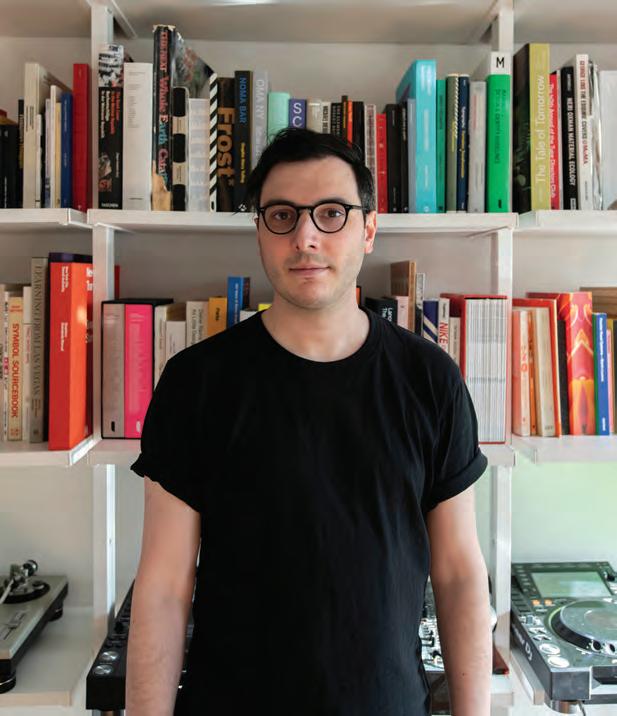
ARON FAY
FOUNDER/CREATIVE DIRECTOR, FAY, BROOKLYN, NY
Aron studied graphic design and book arts at the Maryland Institute College of Art (MICA) before joining Pentagram, where he worked for six years, ultimately as an Associate Partner for Michael Bierut. At Pentagram, Fay worked with a range of clients and projects, including rebrands for the MIT Media Lab, Verizon, and MIT Technology Review.
In 2018, he started his own graphic design & creative technology studio, FAY, where he and his team specialize in developing dynamic brand identity systems and custom-built generative design tools. The studio also works regularly on campaigns, brand strategy, print, book and web design. Clients have included Yale, MIT, Paradigm, OXMAN, Lobe Spatial Sound, Fast Company, Harmonic AI and more.
The studio also works on self-initiated projects as part of its LAB initiative, where they prototype new methodologies for visual communications in the future. These R&D projects combine design and emerging technologies in unexpected ways, with the goal of creating new, more meaningful and layered ways of communicating.
Fay previously taught graphic design & typography at the School of Visual Arts (SVA) and has run workshops, lectured, and been a guest critic at institutions such as Parsons, MICA, and SVA. His work has been published in books, publications (including GDUSA) and also recognized by various awards.
Aron is an avid electro (music) fan—in his spare time he can be found tinkering with his synth/drum machine collection, producing electro, and occasionally Djing.
As we pivot into a post-pandemic era marked by societal challenge and change, are you optimistic about the future of Graphic Design in supporting and shaping commerce, culture and causes? Why do you feel the way you do? Are you optimistic about the future of your own design career or business?
Hanging prominently above our office desks is a black & white flag. On it, drawn in the vernacular of a black metal logo, the word Futurism™ (a riff and ode to Experimental Jetset’s Modernism™ flag). It’s a reminder to us every morning why we do what we do. My team and I believe strongly in what the future can hold. We believe that through a thoughtful and intentional approach, our work can have a positive impact on culture, albeit, often at a microscale when evaluating this impact in a global context. That said, we do believe that whether it be design, creative technology, or any other discipline, if there are enough people making small positive contributions, they will add up. The hope of course is that these changes at scale, begin to manifest in more visible and tangible ways. For us, we see the work we do rooted deeply in changemaking and trying to shape better futures for the partners we work with. Clients come to us because they want to improve or rethink some aspect of their business or how they show up in the world. We feel it’s our duty to provide creative solutions that not only help address their near-term needs, but also set our partners up for success many years in the future. So yes, despite all of the truly awful things going on in the world right now, we do our best to stay optimistic and to encourage our partners and collaborators to take positive steps towards bettering their futures and the larger world around us.
44 GDUSA 2024 | PEOPLE TO WATCH
 DAVID LEMLEY
DAVID LEMLEY
PRESIDENT/HEAD OF STRATEGY RETAIL VOODOO, SEATTLE, WA
David Lemley is a seasoned brand strategist, creative marketer, and design practitioner who leads Retail Voodoo, a U.S.-based brand strategy firm that specializes in food, beverage, wellness, and fitness. He has experience in creating, growing, and evolving brands across consumer packaged goods (CPG) categories, such as water, snacks, soda, ice cream, supplements, and seafood.
Lemley is passionate about helping brands connect with their consumers and deliver meaningful innovation that drives bottom-line growth. He has a proven track record of restoring growth to declining brands, developing new brands, and accelerating growth on established brands.
He has worked with leading CPG companies, such as Pepsico, P&G, KIND, REI, and Walmart, as well as emerging and challenger brands, such as Essentia Water, HighKey, Derma E, and Sahale Snacks. He is also a published author and speaker who shares his insights and expertise on branding, packaging, and marketing.
As we pivot into a post-pandemic era marked by societal challenge and change, are you optimistic about the future of Graphic Design in supporting and shaping commerce, culture and causes? Why do you feel the way you do? Are you optimistic about the future of your own design career or business?
I am optimistic about the future of graphic design because it is always about solving problems. There will continue to be no shortage of them in our world. The challenge: the role of design is changing. Simultaneously more commoditized and more important than ever.. The opportunity: design professionals who want to make an impact can attack how the role of designer is changing as though it were a juicy design challenge. I feel this way because that is what I see happening in our world at Retail Voodoo. The Curious get stronger and smarter (and blow up categories), the Complacent end up making a lot of pretty stuff that the world may never see.
We are seeing an increased focus on Package Design to advance the brand, tell the story, amplify the experience, forge an emotional connection. Do you agree with this observation and, if so, what advantages does packaging have over other graphic communications?
The importance of package design in our commercedriven society cannot be underestimated. It is here to stay, even if forms changes, channels dissolve and AI becomes part of the team. Packaging is often the only brand interaction a prospective customer has with a brand. It has to work hard to break through the clutter. As far as trends, it is our policy to avoid them like yesterday’s sushi. Which is way harder than it sounds.
GDUSA 45

MICHELE CUTHBERT
FOUNDER/CREATIVE DIRECTOR BAKER CREATIVE, GROVEPORT OH
Baker Creative is an award-winning marketing, public relations, human resources and brand management firm founded in 2003.
Cuthbert is a graduate of the Columbus College of Art & Design and has taught at three local colleges and universities – Columbus State Community College, Columbus College of Art & Design and Capital University.
She was profiled in the Hispanic Stars Rising: Volume III book and honored by Ohio Business magazine as being among 500 of the most influential people in Ohio, with her firm being named one of the Best Workplaces in Ohio and a Best in Ohio Business. Cuthbert received the Chief Marketer Market Like A Mother Award and her firm received the Torch Award for Ethics from the Better Business Bureau of Central Ohio. She is the host of the award-winning Baker Creative BusHuddle (BusinessHuddle) podcast and founder of The Office Mommy blog supporting working mothers.
Cuthbert has decades of experience working with leading brands, including McDonald’s, Ohio State University Hospital, Columbus Crew, Columbus
Blue Jackets, NAPA, Ohio Tourism, Visit Florida, OhioHealth and Benary. She is Edge certified, a recipient of the Columbus Business First 40 Under 40 Award, and been recognized as a leading female chief executive officer by Columbus CEO magazine.
In addition to the headquarters office near Columbus, Baker Creative established two satellite offices in the United States and two in Europe. Cuthbert’s pro bono portfolio has assisted groups including firefighters and hurricane victims.
As we pivot into a post-pandemic era marked by societal challenge and change, are you optimistic about the future of Graphic Design to support and shape commerce, culture and causes? Why do you feel the way you do? Are you optimistic about the future of Yes, I am optimistic about the future of graphic design. There are always new tools coming in as AI -- Artificial Intelligence -- is now. You can see it as a threat or as an asset. I believe marketing is a people business. They may look at AI as a magic bullet, but there are still pitfalls which warrant a person to be part of the process. AI doesn’t replace the person if used appropriately. AI can’t replace creativity.
We are seeing an increased focus on Package Design to advance the brand, tell the story, amplify the experience, forge an emotional connection. Do you agree with this observation and, if so, what advantages does packaging have over other graphic communications?
Packaging has a 3-D capacity. You can hold it in your hand. It feels tangible versus a flat, digital image. And there are trends I see in package graphics. For example, in package graphics in the cannabis industry, there is either simplicity or it looks like the Grateful Dead graphics. One speaks to culture, one to the commercialization of cannabis. What’s the unique selling proposition of the product if all the visuals are similar?
50 GDUSA 2024 | PEOPLE TO WATCH

TRAVIS ROBERTSON
EXECUTIVE CREATIVE DIRECTOR/CO-FOUNDER COLOSSUS, BOSTON MA
Obsessed with design, enamored with the big idea, and armed with the weirdest backstory you’ve ever heard, Travis co-founded Colossus in 2021. His time at agencies like Arnold Worldwide, Fort Franklin, MMB and others saw him run creative departments and global accounts for iconic brands like Jack Daniel’s, Volvo, Subway and Toyota, among others. In stark contrast, he has also worked extensively with non-profits, startups and small businesses on everything from identity systems to packaging to activations and beyond.
But his true secret power is his life experience (see: backstory) which offers him a diverse perspective when approaching any problem — business, creative or otherwise. Perhaps that stems from working as an actor alongside Steven Spielberg as a child, boxing in the seedy underbelly of Bangkok or cooking under the tutelage of a James Beard award-winning chef (told you.)
His work has been honored by Cannes, The One Show, Clios, Emmys, FWA, D&AD, Type Directors Club, ADC, ANDY’s, Webby’s, Communica-
tion Arts, Graphis, Archive and is on exhibit in the permanent collection of the Cooper-Hewitt Smithsonian Design Museum.
As we pivot into a post-pandemic era marked by societal challenge and change, are you optimistic about the future of Graphic Design in supporting and shaping commerce, culture and causes? Why do you feel the way you do? Are you optimistic about the future of your own design career or business?
Emerging from the long hibernation of the pandemic era, I think we all felt a hesitant, but renewed sense of freedom and possibility. Essentially, our profession is built on a foundation of optimism. The variety of this practice, however, comes in many forms. Some days we are hawking salad dressing and fanny packs with little impact on the greater good. And yet, on other days we are articulating the environmental value of wind turbines or fighting against inequity in the justice system. I’m continually reminded that our work makes ripples in society. Our creativity helps steer culture–a massive privilege which cannot be taken lightly. Because of this, we must continue to make space for unique perspectives and marginalized voices in our field. It’s that diversity in thinking that moves culture forward. At Colossus, our growth and evolution over this past year has left us all feeling incredibly energized for the future. It’s an exciting time to be a creative mind.
We are seeing an increased focus on Package Design to advance the brand, tell the story, amplify the experience, forge an emotional connection. Do you agree with this observation and, if so, what advantages does packaging have over other graphic communications?
My appreciation for packaging can be traced back to my father’s jazz record collection. I’d obsess over the typography of Miles Davis and the geometric collages of Dave Brubeck. The visual storytelling set the mood long before the needle hit the wax. Color, typography, illustration, and other elements make mundane products like olive oil and house paint worthy of public display. Unboxing videos show consumers gushing over the intricacies of die-cuts, subtle shine of spot varnish, and clever copy on packaging inserts. An affinity once shared only by designers now commands appreciation by the masses.
GDUSA 47

MONIKA CASCONE
CREATIVE DIRECTOR, SMASHBRAND, CHICAGO IL
I fell in love with packaging design very early in my career, and I have worked on a variety of exciting projects in the last 15+ years. SmashBrand, where I am currently a Creative Director, is the first data-driven brand development agency where strategy, design, and consumer testing are integrated into a single, efficient process. I love that everything we do is rooted in extensive consumer testing, which ensures that our packaging not only resonates deeply with the target audience but also drives sales and excels in retail performance. We are the only agency with this unique approach; having worked here for over 8 years has allowed me to gain invaluable insights into the consumer’s mind. This understanding has helped my team and me craft designs that not only capture attention but also stand apart from the competition. And it puts a smile on all our faces to see our hard work come to life on retail shelves.
As we pivot into a post-pandemic era marked by societal challenge and change, are you optimistic about the future of Graphic Design to support and shape commerce, culture and causes? Why do you feel the way you do? Are you optimistic about the future of your own firm?
Graphic design is very adaptable and resilient when it comes to change; as long as consumers are buying products, there will be new brands, new challenges, and new opportunities. As brands reposition themselves post-pandemic, there's an ever-growing need for effective branding and communication as well as adaptability to new consumer behaviors. The pandemic also heightened the awareness of social and environmental issues for many consumers, so it’s important for brands to tell a cohesive and consistent story to meet these expectations. At SmashBrand we are constantly helping brands find new and better ways to speak to their consumers, and because of our testing, we minimize the risk of getting it wrong. As we know, one bad decision can sink a brand, while the right innovative approach can produce amazing results.
We are seeing an increased focus on Package Design to advance the brand, tell the story, amplify the experience, forge an emotional connection. Do you agree with this observation and, if so, what advantages does packaging have over other graphic communications?
Packaging is more than just a container; it's your brand's front-line ambassador. According to Nielsen IQ Research, packaging is responsible for 64% of consumers discovering new brands. That's more than TV ads, social media, or any other kind of exposure. That’s why it’s crucial to get it right, know who you are talking to, and know how to get their attention. The biggest thing we’ve noticed is that the most successful brands are able to speak to the “head" (the logical side) and the “heart" (the emotional side) of the consumer. Those are the brands that make you believe the product is worth it and that it is made for you; everything about the design, from the copy to the graphics, has to fit that narrative. Plus packaging is the only brand experience that extends directly into consumers’ hands, providing a sensory engagement— making it that much more fun to be a packaging designer.
48 GDUSA 2024 | PEOPLE TO WATCH
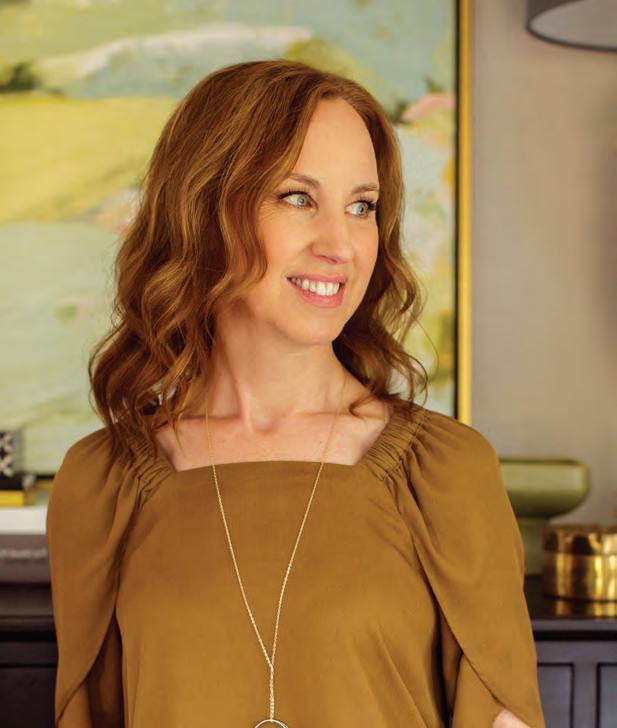
PAMELA HOWARD
PRINCIPAL/CREATIVE DIRECTOR FIREBRICK DESIGN, WEST HARTFORD CT
Pam Howard is a designer, illustrator, and painter based in New England. As the creative director of Firebrick Design, Pam is committed to bringing original, thoughtful solutions to identity systems and marketing challenges. She’s an experienced and accomplished professional who is constantly gathering inspiration from the world around her. Firebrick Design is the arena where Pam merges what she knows about design forms and techniques with modern technologies and concepts.
She has been the recipient of various international, national, and local awards from How Magazine International, Print Magazine, Graphic Design USA, the Sunday Magazine Editors Association, Connecticut Art Directors Club, the Mom’s Choice Awards, the Ad Club of Connecticut, American Alliance of Museums, New England Museum Association, and the IBPA Book Awards. The real prize is that she loves what she does.
As we pivot into a post-pandemic era marked by societal challenge and change, are you optimistic about the future of Graphic Design in supporting and shaping commerce, culture and causes? Why do you feel the way you do? Are you optimistic about the future of your own design career or business?
Design has always supported and shaped commerce, culture, and causes — and will continue to do so in the post-pandemic era and beyond. Our current climate is demanding, however disruption is inevitable — and healthy. Questioning the status quo is incorporated into the designer’s job description and solution-based decision making is a top skill for many in the design industry. Designers help communicate new concepts and make first steps less intimidating. Design is so powerful. It can clarify or obfuscate; empower or crush; entertain or irritate. The difference is in the “how” and the “why” design is wielded and the “who” design is in service to. Designers are early adapters, working with data and the large umbrella of advancements that are grouped under “AI”. I’m thankful that others are putting in the work on datahumanism, reminding us that every data point is a person and that the end-user isn’t a computer but, rather, a human being. In some of my work, the interaction of a person is paramount. For example, most identity systems that I build will include an elevated printed piece. If we’re going to expend resources like paper and ink, it needs to be in a targeted, thoughtful manner and the final piece needs to have some longevity. It should feel like a gift. The joy of discovery and the haptic nature of these pieces can only be experienced in real life. A yearning for a deeper connection with the world around us supports my feeling of optimism for my business in particular, and the world of graphic design at large.
GDUSA 49

MICHELE CUTHBERT
FOUNDER/CREATIVE DIRECTOR BAKER CREATIVE, GROVEPORT OH
Baker Creative is an award-winning marketing, public relations, human resources and brand management firm founded in 2003.
Cuthbert is a graduate of the Columbus College of Art & Design and has taught at three local colleges and universities – Columbus State Community College, Columbus College of Art & Design and Capital University.
She was profiled in the Hispanic Stars Rising: Volume III book and honored by Ohio Business magazine as being among 500 of the most influential people in Ohio, with her firm being named one of the Best Workplaces in Ohio and a Best in Ohio Business. Cuthbert received the Chief Marketer Market Like A Mother Award and her firm received the Torch Award for Ethics from the Better Business Bureau of Central Ohio. She is the host of the award-winning Baker Creative BusHuddle (BusinessHuddle) podcast and founder of The Office Mommy blog supporting working mothers.
Cuthbert has decades of experience working with leading brands, including McDonald’s, Ohio State University Hospital, Columbus Crew, Columbus
Blue Jackets, NAPA, Ohio Tourism, Visit Florida, OhioHealth and Benary. She is Edge certified, a recipient of the Columbus Business First 40 Under 40 Award, and been recognized as a leading female chief executive officer by Columbus CEO magazine.
In addition to the headquarters office near Columbus, Baker Creative established two satellite offices in the United States and two in Europe. Cuthbert’s pro bono portfolio has assisted groups including firefighters and hurricane victims.
As we pivot into a post-pandemic era marked by societal challenge and change, are you optimistic about the future of Graphic Design to support and shape commerce, culture and causes? Why do you feel the way you do? Are you optimistic about the future of Yes, I am optimistic about the future of graphic design. There are always new tools coming in as AI -- Artificial Intelligence -- is now. You can see it as a threat or as an asset. I believe marketing is a people business. They may look at AI as a magic bullet, but there are still pitfalls which warrant a person to be part of the process. AI doesn’t replace the person if used appropriately. AI can’t replace creativity.
We are seeing an increased focus on Package Design to advance the brand, tell the story, amplify the experience, forge an emotional connection. Do you agree with this observation and, if so, what advantages does packaging have over other graphic communications?
Packaging has a 3-D capacity. You can hold it in your hand. It feels tangible versus a flat, digital image. And there are trends I see in package graphics. For example, in package graphics in the cannabis industry, there is either simplicity or it looks like the Grateful Dead graphics. One speaks to culture, one to the commercialization of cannabis. What’s the unique selling proposition of the product if all the visuals are similar?
50 GDUSA 2024 | PEOPLE TO WATCH
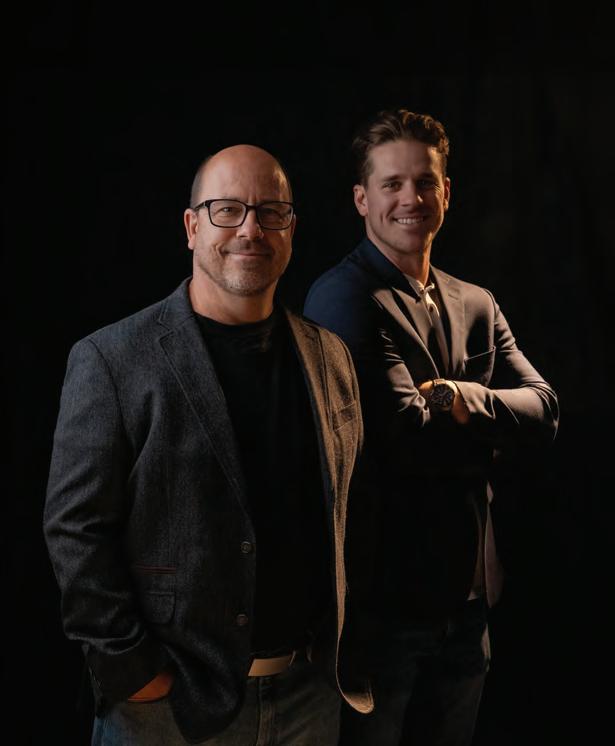
RANDY RICHARDS
PRESIDENT/CREATIVE DIRECTOR
RANDY RICHARDS DESIGN GROUP (RRDG), GROTON CT
Randy Richards is an award-winning fine artist and graphic designer. Before starting RRDG 10 years ago, he led creative at BIC, The Hartford, ESPN/Walt Disney, RollEase and Stanley Black&Decker where he was also Brand Council co-chairman.
RRDG is a nationally recognized brand development leader specializing in Home/Auto/Construction industries. They have been among the top award winners from GDUSA the last 3 years. RRDG also helped customers succeed during challenging pandemic times. The work had shifted to doing more photo, video and online content, so staff was added to support it – including Randy’s son, Kyle Richards, Senior VP of photography & video. With over 30 years experience, Dan Deming, was also added as brand package design director.
RRDG’s menu of services all work towards one goal - to help sell product, build strong brands and beat competition. With a team approach, they all work together and with the customer, making sure project goals are met.
Randy has designed many well-known logos and brands. Early on in his career he was part of one of the most successful toy product launches in history with Cabbage Patch Kids. In 1998 for The Hartford, he designed one of the very first corporate websites for which he won the Chairman award. In 1989 he was the first pen industry designer to put art/design on pens, creating the BIC Wavelengths. In 2001 at Stanley, he created the European package design standards guide used by most companies worldwide. Randy has also won multiple art museum awards.
As we pivot into a post-pandemic era marked by societal challenge and change, are you optimistic about the future of Graphic Design in supporting and shaping commerce, culture and causes? Why do you feel the way you do? Are you optimistic about the future of your own design career or business?
Over the past 40 years, graphic design has evolved greatly. It’s about to change again with new technology and Artificial Intelligence. Even with AI, there is still a need for a designer to manage, design and apply it correctly to projects. In 1998 when Randy designed The Hartford's first website as new technology, all basic design principals still applied to a digital screen rather than a printed piece. Designers will still be vital and design principals will apply again for AI or whatever comes after that!
We are seeing an increased focus on Package Design to advance the brand, tell the story, amplify the experience, forge an emotional connection. Do you agree with this observation and, if so, what advantages does packaging have over other graphic communications?
Trends we see are based on our customers desire to connect to consumers, communicate unique product features clearly and build strong brands, all through packaging. Sometimes packaging at POP is the only communication touch point a consumer has, so it’s got to be powerful and clear. Use of lifestyle or in-use product images helps to communicate and connect emotionally to consumers. The use of green packaging is also a current trend due to continuous environmental concerns. Brand consistency across all packages in a line builds a strong family of products.
GDUSA 51

NEIL RIDDELL
FOUNDER/CEO, NOUN VENTURES, BOULDER CO
Neil is the founder and CEO of Noun Ventures, a company that specializes in building maverick companies and purpose-built brands that positively disrupt their respective categories and are meaningfully connected to culture. Brands and products that people want to talk about and fall in love with. They operate across categories as diverse as transportation, wine & spirits, better-for-you foods & beverages, vertical farming, blockchain fintech, health & wellness, apparel, sports & entertainment, etc.
Neil brings extensive strategic & creative brand development experience having helped many Fortune 500 companies and small challenger brands find success. As an EVP during a 20+ year career at Crispin Porter + Bogusky, Neil founded and led their product/brand innovation engine, where they developed many successful brands from launch to exit. Neil has won numerous awards for his work and in 2015 was named to Adweek’s inaugural Creative 100—America’s Most Inventive Talent in Marketing, Media + Tech.
Prior to CP+B, Neil spent time working at Ogilvy & Mather, Young & Rubicam, and Foote, Cone & Belding. Neil studied Art Direction & Design at the Miami Ad School and also holds a degree in International Finance & Marketing from the University of Miami.
As we pivot into a post-pandemic era marked by societal challenge and change, are you optimistic about the future of Graphic Design to support and shape commerce, culture and causes? Why do you feel the way you do? Are you optimistic about the future of your own firm?
These new societal, cultural and business challenges, though daunting, bring about new opportunities. They must be framed in that light. Design is uniquely positioned as a tool for solutions because of its ability to effectively communicate information, stir emotion and inspire meaningful change. It connects people in powerful ways that serve to unite and rally them around a goal. Design is truly a magical weapon to wield when confronting these challenges. When design, commerce, and purpose intertwine and align in the right balance, it creates a powerful multiplier effect that can not only solve the problems in front of us, but can also build better versions of existing frameworks and systems that aren't working. I’m excited to continue that alchemy with more purpose-driven projects moving forward.
We are seeing an increased focus on Package Design to advance the brand, tell the story, amplify the experience, forge an emotional connection. Do you agree with this observation and, if so, what advantages does packaging have over other graphic communications? I do. Packaging is the first touchpoint emanating out from the product. It provides an amazing opportunity to communicate and reinforce a brand’s unique spirit in a very tangible way. It serves as a canvas for storytelling and when you can make that experience thought-provoking, insightful and interesting, you’ve leapt beyond being transactional and into the realm of magic and wonder.
52 GDUSA 2024 | PEOPLE TO WATCH

REBECCA SPRINGER
VICE PRESIDENT OF CREATIVE SERVICES
KAHALA BRANDS, SCOTTSDALE AZ
Rebecca Springer has led the Kahala Brands in-house team of highly skilled graphic designers for more than 11 years, balancing consistency and innovation within the company’s brands as well as collaborations with others. In the process, she and her team have won multiple awards for their work.
Kahala Brands is a global leader in quick-service restaurant franchising, operating in more than 27 countries around the world. The company has a diverse portfolio of highly popular brands, including Cold Stone Creamery, Pinkberry, Blimpie, TacoTime, and Great Steak.
Rebecca’s Creative Services team is responsible for designing advertising, branding, and promotional materials for over 28 unique restaurant concepts belonging to Kahala Brands.
The team plays a crucial role in driving customer traffic and creating brand awareness, which is essential for the company’s continued growth and success. Their designs are not only visually stunning but also extremely effective in conveying the brand’s message to millions of potential customers.
We are seeing an increased focus on Package Design to advance the brand, tell the story, amplify the experience, forge an emotional connection. Do you agree with this observation and, if so, what advantages does packaging have over other graphic communications? The first interaction a consumer has with a product is often through its packaging. At the very least, packaging protects the product's integrity, making sure it reaches consumers in pristine condition. Functionality is key, ensuring that the packaging is not just visually pleasing but also practical, enhancing the overall user experience. However, it’s not merely a wrapper; it's a visual ambassador that crafts an immediate and lasting impression. Beyond aesthetics, packaging becomes the face of a brand, weaving a consistent identity through color palettes, logos, and design aesthetics. It's the silent communicator, relaying vital information about ingredients, usage instructions, and other essential details, fostering trust.
Distinctive and appealing packaging doesn't just stand out; it differentiates a product in a crowded market and influences purchasing decisions. Moreover, packaging has the power to establish a profound emotional connection with consumers and fostering brand loyalty. From sustainability messaging to serving as a promotional canvas, product packaging design is a multifaceted tool that goes beyond the surface, making a lasting impact on consumer perceptions and preferences.
The restaurant industry is currently experiencing a positive trend toward online pickup and third-party delivery orders, which has opened new opportunities for businesses to reach a wider audience. However, this shift has also brought about new packaging challenges that require careful problem-solving. For instance, there is a need to ensure that all food is packaged properly to maintain its quality during transit. Additionally, there is an increased focus on food safety to maintain the quality and integrity of the food being delivered, which provides an opportunity for restaurants to demonstrate their commitment to providing high-quality meals. By addressing these packaging challenges, restaurants can continue to thrive in the rapidly changing landscape of the industry.
GDUSA 53
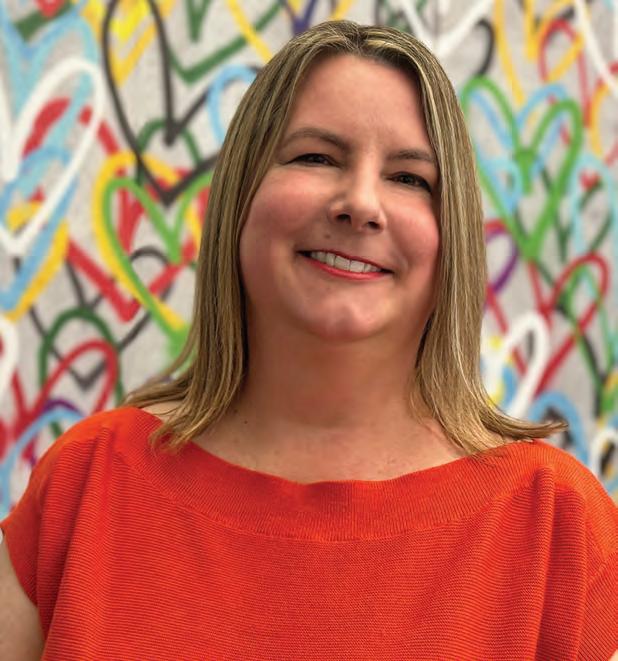 SARAH SANSOM EXECUTIVE DIRECTOR OF CREATIVE INNOVATION CSB, NEW YORK NY
SARAH SANSOM EXECUTIVE DIRECTOR OF CREATIVE INNOVATION CSB, NEW YORK NY
With three decades of brand identity and packaging experience, Sarah brings a range of skills to her role at CSB. As a leader, designer and collaborator, Sarah works with a range of tools to clarify each assignment and inspire creativity throughout CSB’s dynamic team, encouraging unique ideas. She has led a range of projects for challenger and legacy brands, from X2 Energy to SweeTarts candy and Poland Spring water. Most recently, she had the privilege of partnering with BKLYN Body to lead a redesign of their skincare packaging. Sarah believes there’s something special about creating emotional connections with an audience through visual language, to create a long-lasting, meaningful identity.
CSB (Cornerstone Strategic Branding for the OG’s), located in NYC, has been designing for established and emerging CPG brands since 1991. We are a fully independent, woman-owned company that translates business goals into captivating visuals that truly connect with consumers and grow sales. As an integrated team of experts, CSB provides an A-Z of brand design services through brand strategy and creative, to pre-print production, that gives brands center-shelf power to stand out.
As we pivot into a post-pandemic era marked by societal challenge and change, are you optimistic about the future of Graphic Design to support and shape commerce, culture and causes? Why do you feel the way you do? Are you optimistic about the future of your own firm?
I feel graphic design is more important than ever. At CSB, we’ve broadened our creative services for an online world. We’ve expanded brand identities beyond packaging to websites, mailer kits and online images. This allows our brands to have the same design expression across touchpoints while building upon the learning we already have. No need to brief another team! As a company, we have a flexible office space and are a balance of remote and onsite work to balance our client’s and team’s needs.
We are seeing an increased focus on Package Design to advance the brand, tell the story, amplify the experience, forge an emotional connection. Do you agree with this observation and, if so, what advantages does packaging have over other graphic communications?
As products become similar, packaging plays a stronger role. We’ve worked hard on our brand identities to use unique elements and convey brand values to stand out. As a packaging designer, I see design as critical for DTC brands to connect meaningfully with consumers. Since we have fewer inperson events, design can provide a personal connection through positive messaging and uplifting elements. When DTC brands follow the trend of moving to brick-and-mortar, like Allbirds or Bombas, the store identity builds outwards from the packaging. Peach pink Glossier stores, or blue and white Casper interiors show this well. Regarding sustainability, we’ve noticed clients across categories moving to aluminum structures, which are recycled at far higher rates than glass or plastic (63% vs 33% for PET plastic bottles). We’re happy to see this shift in a positive direction.
54 GDUSA 2024 | PEOPLE TO WATCH

DEVON LUXMORE TIM MCLAUGHLIN
CREATIVE DIRECTORS
INVOK BRANDS, TORONTO CANADA + NEW YORK NY
When Tim McLaughlin joined Invok Brands in 2019, the first project that he worked on was for a new client of the agency – Copperstate Farms. It was an exciting assignment because it was focused on creating a new brand in the relatively new market of recreational cannabis. It was also the first time that Tim had the opportunity to work alongside Devon Luxmore, who was Invk’s Design Director at the time.The two quickly established a rapport and respect for each other that went beyond design.
The Copperstate project ended up being the perfect introduction for the two designers, who now serve as the Creative Directors at Invk – an independent design firm with capabilities that range from strategy and design to production and pre-press. With Devon located at Invk’s Toronto studio and Tim based out of the NYC office, the two are able to tap into their past experiences and enhance each other’s strengths to ensure that every project delivers not only great creative, but also great business results for the client.
Devon brings a tremendous wealth of brand knowledge from their years of experience in the consumer branding world. Their strategic creative ap-
proach, combined with pragmatic problemsolving allows Devon to think holistically about the entire brand experience for Invk’s clients. Tim’s strategic, detailed systemized approach has allowed him to become an expert in large-scale projects where brands find themselves repositioning, extending into new lines, or building very detailed consumer approaches across multiple touchpoints.
As we pivot into a post-pandemic era marked by societal challenge and change, are you optimistic about the future of Graphic Design to support and shape commerce, culture and causes? Why do you feel the way you do? Are you optimistic about the future of your own firm?
The pandemic accelerated the need for brands to think holistically about consumer engagement. Brands need to simplify and streamline their visual expression to connect and create community with consumers. As creatives, we view this as a great opportunity. Through digital touchpoints and brand engagement, there are amazing tools and methods to connect with consumers. What makes us optimistic about the industry and the future of Invk is the potential for unlimited creativity for those who embrace the idea of thinking outside the box.
We are seeing an increased focus on Package Design to advance the brand, tell the story, amplify the experience, forge an emotional connection. Do you agree with this observation and, if so, what advantages does packaging have over other graphic communications?
Packaging has become a vehicle to drive consumers to connect with brands. From unique unboxing experiences to the resurgence of QR codes and advancements in AR/VR capabilities, package design has the ability to be a part of a much larger world that incorporates physical, digital and virtual. You do see though, that there is also a strong desire for simplicity and minimalism among certain consumers. There is a lot of excitement around trends and technology, but consideration always needs to be given to what will resonate and what will distract.
GDUSA 55
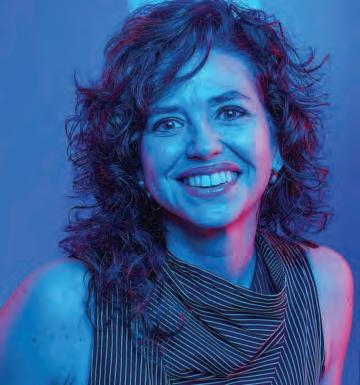
SHERI L. KOETTING
CO-FOUNDER/CHIEF STRATEGIST, MSLK, NEW YORK NY
Sheri L Koetting is the Co-Founder and Chief Strategist of MSLK, a branding agency based in New York. MSLK specializes in helping beauty companies find their voice in today’s crowded marketplace through 360° positioning — from overall brand strategy to brand identity, packaging, websites and digital marketing campaigns.
Over the past two decades, MSLK has helped brands strengthen their position in the beauty industry – from the very beginnings to launching line extensions, rediscovering their voice in a crowded market, and creating entirely new product categories.
Sheri has worked with clients such as Aveda, Chanel, Joico, John Masters Organics, Maybelline, Ouidad, Redken, Sephora, in addition to many smaller brands.
She frequently speaks about marketing and branding at conferences around the world. She has dedicated her career to producing events and workshops dedicated to best practices and business acumen for design agencies. In 2002 Sheri co-founded the non-profit organization, Spark Design Professionals.
As we pivot into a post-pandemic era marked by societal challenge and change, are you optimistic about the future of Graphic Design to support and shape commerce, culture and causes? Why do you feel the way you do? Are you optimistic about the future of your own firm?
The future looks bright at MSLK; the beauty and wellness industry rely on branding, design, and marketing to shape the overall impression consumers have of products. These tools are what differentiates a brand and inspires purchase for the first time. The beauty industry is trail blazing, demonstrating for all industries the way consumers yearn to connect with the products they purchase. Brands outside the category like Oatly are proof that consumers yearn for emotional connections and joy — no matter the product category or purchase price. Consumers want to be connected to a community of likeminded peers. When you clearly define a brand’s value proposition, culture, and values, the more likely you are to win market share.
We are seeing an increased focus on Package Design to advance the brand, tell the story, amplify the experience, forge an emotional connection with consumers at the moment of truth. Do you agree with this observation and, if so, what advantages does packaging have over other graphic communications? Also, do you see any notable trends regarding package graphics and/or package production?
One hundred percent of your customers will interact with your packaging. The primary display panel (PDP) does all the heavy lifting and must convey the essence of your brand. The colors, shapes, symbols, and words on your PDP speak volumes about your brand, inspiring consumers to pick up your package at retail or click on e-commerce. Packaging must be designed to address the fundamental product category requirements and be at parity with other brands — yet stand apart and offer something different. Beauty consumers yearn for these graphical elements to convey Trust, Education, and Intrigue to feel confident making a purchase from a brand for the first time. Great packaging balances all these elements while utilizing every millimeter of packaging space to make an impact. In the beauty industry some of the products with the highest price point and highest profit margin come in the smallest packages.
56 GDUSA 2024 | PEOPLE TO WATCH
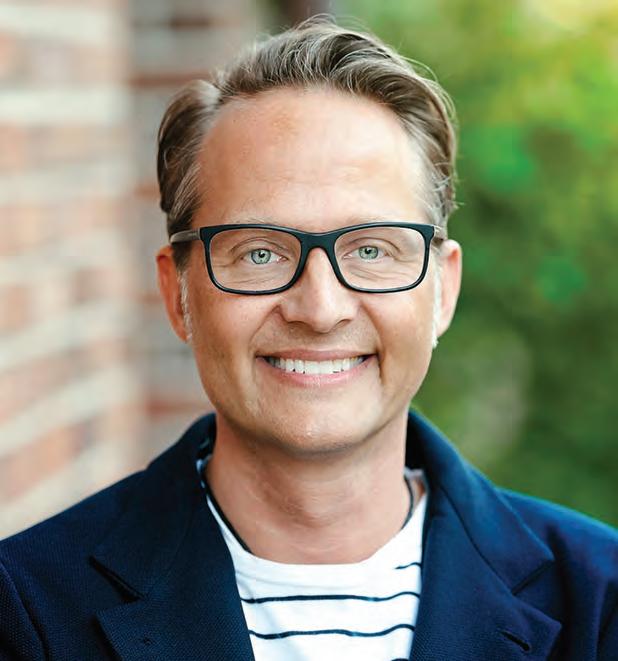
JIM PIETRUSZYNSKI
CEO, SOULSIGHT, CHICAGO IL
Jim Pietruszynski is honored to be the CEO of Soulsight, a full service brand design agency, that utilizes an empathic mindset to motivate consumer connections with brands emotionally, keeping brands relevant and evolving with culture. With over 3 decades of experience in iconic brand design, Jim has worked in every category and channel, and is driven not only by creativity, but understanding true human needs, turning brands into artifacts of our culture. He has spent the last 25 years at Soulsight with roles as a Designer, Strategist, Account Manager, and CMO.
Jim’s passion for the creative process begins with the formation of an environment where a strong strategic vision can truly thrive. Collaboration and honesty have been important factors that have fostered breakthrough innovation and game-changing creativity. Jim’s inspiration comes from insights grounded in basic human truths and an empathetic approach. His focus on strategic insight and design allows him to contribute compelling creative thinking for clients and colleagues. Jim has experience in working with global and iconic companies such as Kraft Heinz, Coca-Cola, Molson Coors, General Mills, Pfizer, Unilever, and Hershey’s, and his work has been recognized by major US and international design and packaging awards programs.
As we pivot into a post-pandemic era marked by societal challenge and change, are you optimistic about the future of Graphic Design to support and shape commerce, culture and causes? Why do you feel the way you do? Are you optimistic about the future of your own firm?
I have always believed that design will continue to define our culture and the world we live in. The core essence of solving needs has always been emended in what we do with design. The next chapter I see as an exciting time where we have the opportunity to build needs with the intention of creating better opportunities to enhance living. I feel with the desire to continue to grow and evolve it will be essential to lean in with more intentionality to provide solutions that are unanticipated and drive a new dimension of experiences. These experiences have the ability to express the values that are concrete, meaningful and supportive to humanity.
We are seeing an increased focus on Package Design to advance the brand, tell the story, amplify the experience, forge an emotional connection. Do you agree with this observation and, if so, what advantages does packaging have over other graphic communications?
Some have heard me say that the package design of a brand is the artifact that engages human connection. Empathy, transparency, and emotional relevancy is what is needed for package design and graphics to be effective and engage choice selection. Studies have revealed that anywhere between 70-95% of our decision making is made by our subconscious. In the subconscious, emotion and brands that exude an emotion will always connect and be relatable. All of the tools we use to tell a story, color, typography, image, texture, and form are intentionally selected to represent an emotional reason to believe. Successful design understands how to bring these elements together to illustrate, and act out the brand purpose and support the brands function.
GDUSA 57

ALYSSA VARSANYI
USER INTERFACE DESIGNER OOMPH, INC., SPRINGFIELD NJ
As a designer, I thrive in the creation process and am driven by a sincere curiosity and fascination with the intersection between design and data. As a neurodivergent individual, I fiercely advocate for accessibility, inclusion, and empathy in everything I touch.
Through my position, I perform various user experience exercises and create different design systems primarily for clients’ websites. There is no better feeling in the world, than starting a project from the first steps of discovery to finalizing a site’s style guide. My favorite part about Oomph has been the opportunity to partner with progressive clients who focus on making good in the world.
I wouldn’t be who I am as a designer today without the countless design professionals and professors who have helped me along my journey. In 2022, I earned my Master’s Degree in UX Design from the Maryland Institute College of Art (MICA), and transitioned my fulltime role from Graphic Design to UX/UI Design. Prior, I earned my Bachelor of Fine Arts in Graphic Design at The College of Saint Rose in 2018.
I currently reside in New Jersey but grew up in Upstate New York. In my spare time, I often spend time with my pup Luffy, enter Broadway lotteries, and create digital art.
As we pivot into a post-pandemic era marked by societal challenge and change, are you optimistic about the future of Graphic Design in supporting and shaping commerce, culture and causes? Why do you feel the way you do? Are you optimistic about the future of your own design career or business?
I am cautiously optimistic about the future of Graphic Design. On a positive note, remote work is now “normal,” and it seems that voices are amplified for the causes of sustainability, diversity, and one's own social responsibility. However, the introduction of AI tools like ChatGPT has started to change the landscape of business operations. We must use AI as a tool and enhance the human touch in our work, not replace it. Due to the pandemic, small but mighty formal art education programs, such as my own undergraduate program at the College of Saint Rose, have closed for good. Future generations of young designers will not be able to be shepherded through the same program that gave students such a competitive edge.. However, I feel that arts are nothing but resilient, and even without community, those who want to create will continue to create even without structure. In regards to the future of my own career, I take the UX approach of “pivoting” seriously: never settle, and keep changing to adapt to new tools, new information, and new trends. If I can keep contributing my creativity to communicate forward-thinking, positive messages and help make design more accessible to everyone, I will be successful.
58 GDUSA 2024 | PEOPLE TO WATCH

STUDENTS TO WATCH

60 GDUSA
2024
| STUDENTS TO WATCH |
With the help of several of America’s leading art and design schools, we once again identify top students ready to burst on the design scene. Some are undergrads, others are graduate or continuing education students, all have found personal and professional growth through their programs. Our Students To Watch feature has become tradition that resonates and renews: the students get recognized and the professional creative community gets refreshed. As you will see, we focus on the good and great traditional design schools and keep casting our net wide to include wonderful public universities, innovative online and certificate programs, and more. In the next edition of GDUSA magazine, selected institutions of higher learning from which these students come will themselves get the spotlight.
tJARIN MORIGUCHI
UNIVERSITY OF ILLINOIS CHICAGO
Jarin Moriguchi is a Chicago-based graphic designer and multidisciplinary artist from O’ahu, Hawai’i. Before attending the UIC School of Design to pursue an MDes in Graphic Design, he received his BFA with a focus in painting from the University of Hawai’i at Mānoa.
Jarin draws inspiration from speculative fiction, cinematic worldbuilding, the interplay between painting and type design, his experiences as a fifth-generation Japanese-American growing up in Hawai’i, and good books that he reads.
Current projects include challenging form and legibility through custom typography and developing typographic systems via selfgenerated prompting to design experimental letterforms. He also designs publications and cool PDFs with new and long-time collaborators for the unofficial Workers Comp enterprise, recently focusing on imagined worlds and speculative futures.
His extracurricular time is spent designing funky fonts for friends, eating tofu curry, and reading elaborate sci-fi fantasy.
During his time at the UIC School of Design, Jarin has worked as a designer for university programs, studios, and freelance clients both nationally and internationally. He has also participated in solo exhibitions, group exhibitions, and art book fairs in Honolulu, Los Angeles, and Chicago.
WHAT MAKES YOU FEEL INSPIRED?
I am inspired by design as a form of meditation and play through thoughtful and intuitive explorations of story and form.
WHAT AREA OR AREAS OF DESIGN ARE YOU HOPING TO WORK IN OR SPECIALIZE IN?
I would like to work as a type designer and work on visual identities for a studio that values having fun with design, good people and meaningful connections.
WHAT IS ONE THING THAT DESIGN SCHOOL HAS TAUGHT YOU THAT YOU DID NOT EXPECT?
Trust your intuition, reach out to those you look up to, create more work with friends, and pack more home lunches.
WHO IS SOMEONE YOU LOOK UP TO IN YOUR FIELD?
EITHER TODAY OR HISTORICALLY?
CJ Dunn is a friend and type designer from Honolulu, based in New York City and Tokyo, and his generosity in sharing knowledge, enthusiasm for design, and approach to type have challenged and inspired my own practice and design thinking.
WHAT ARE YOU READING, LISTENING TO, OR WATCHING?
I’ve been slowly and steadily working through Brandon Sanderson’s The Stormlight Archive fantasy book series.
GDUSA 61
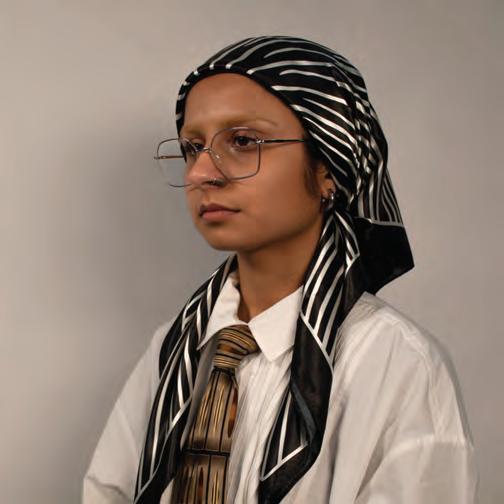
MUHADDISA ALI
RHODE ISLAND SCHOOL OF DESIGN (RISD)
Muhaddisa Ali is a Pakistani-American graphic designer born in Atlanta, GA and raised in Islamabad, Pakistan. They are currently based in Providence, RI, pursuing their BFA in Graphic Design at the Rhode Island School of Design. They are interested in the translation of human emotions and experiences through design. Motivated to balance work and life and find the beauty of simply living again, they are currently working on their degree project focused on the liberatory act of rest as resistance. They recently completed their extended internship at FARRYNHEIGHT and are currently a design director at the Brown Political Review. They love to laugh, and cry, they love their grandma and they are currently obsessed with all things silver.
WHAT MAKES YOU FEEL INSPIRED?
Cloud watching, long conversations over tea, slow mornings, walks, sitting by water bodies and deep breathing.
WHAT AREA OR AREAS OF DESIGN ARE YOU HOPING TO WORK IN OR SPECIALIZE IN?
Connecting to people, which might sound cliché, is my favorite part about designing; I love designing experiences led by empathy, curiosity and care with the intention of building community and sharing and uplifting identity and culture. So branding identities, web design, publications and animation/video are areas that I find myself deeply immersed in and enjoying.
WHAT IS ONE THING THAT DESIGN SCHOOL HAS TAUGHT YOU THAT YOU DID NOT EXPECT?
How important how you think about your work is. Just really the importance of thinking. A lot of people create things, but creating with intention and thinking through your decisions produces beautiful work that is thoughtful and resonates with people.
WHAT ARE YOU READING/LISTENING TO/WATCHING?
I’m currently reading Rest Is Resistance: A Manifesto by Tricia Hersey and re-reading All About Love by bell hooks.
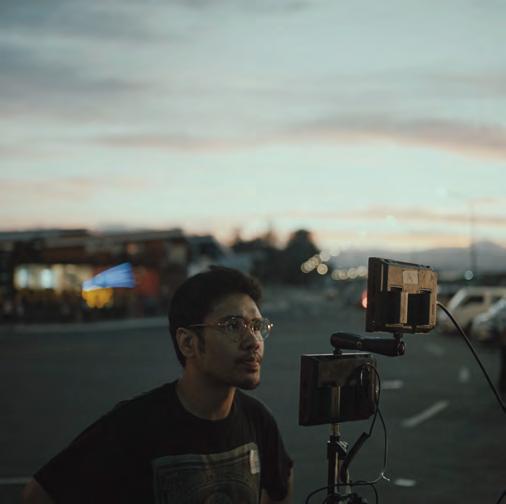
ALEC FIGURACION
RHODE ISLAND SCHOOL OF DESIGN (RISD)
Alec Figuracion (b. 1992) is a filmmaker and graphic designer born and raised in the Philippines, where he studied and practiced filmmaking. His second feature-length film, The Eternity Between Seconds, which he wrote, directed and edited, won Best Picture, Best Director, Best Cinematography, Best Editing and Best Sound at the CineFilipino Film Festival 2018. The film was also screened in the Busan International Film Festival in 2018, Osaka Asian Film Festival in 2019, and Cape Town Film Market & Festival in 2018, where it won Best Screenplay.
Currently, Alec is based in Providence, RI, where he is pursuing an MFA in Graphic Design at RISD. Here, he hopes to reconcile the many ways he wishes to tell and share stories, and strives to better situate himself as a storyteller, a visual thinker and an individual keeping up with a turbulent world.
WHAT MAKES YOU FEEL INSPIRED?
A good film, a good book, good music and simply the stories we tell ourselves and each other.
WHAT AREA OR AREAS OF DESIGN ARE YOU HOPING TO WORK IN OR SPECIALIZE IN?
I quite enjoy working on identities and I am decent in motion. It would be incredible to land somewhere at the intersection of film and graphic design.
DO YOU CURRENTLY, OR DO YOU PLAN TO, DESIGN FOR ANY CAUSES OR CHARITIES?
I used to make work for NGOs in my filmmaking practice, so I am very much open to the idea.
DO YOU FEEL THAT DESIGN SCHOOL HAS PREPARED YOU TO SEARCH FOR AND FIND A JOB?
Design school has definitely honed my skills and provided me with resources and design literacy I wouldn't otherwise have access to, so I think I am as prepared as I will ever be for life outside of it!
2024 | STUDENTS TO WATCH
62 GDUSA
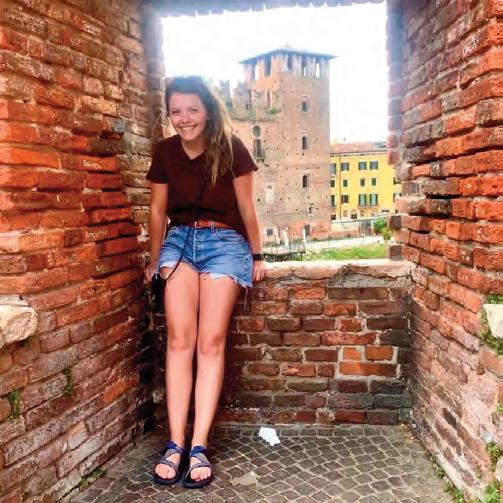
MADISON HATFIELD ACADEMY OF ART UNIVERSITY
I'm Madison, a rebellious designer based out of the wild landscapes of Eastern Oregon. I have an associate degree in Anthropology and am currently getting my BFA in Advertising at the Academy online. The online program is great because I can take classes on my own schedule, which allows me to work and have time for recreational activities like snowboarding and hiking. Living in a place that demands versatility, I've worn many hats—photographer, web designer, graphic maestro, and even brand virtuoso. From my earliest memories, the calling to be a designer has been my compass. Designing, for me, is a way to break free from conventional norms and a way for me to find solace in the chaos of my mind. While immersed in the ever-evolving world of advertising, I aspire to be an art director who defies the shadowy aspects of the industry. I dream of using advertising as a force for good and leaving a mark as rebellious as I am. In a world full of rules, I am here to break a few—all in the name of creativity and positive change.
WHAT MAKES YOU FEEL INSPIRED?
I’m drawn to what I call “rebellious” designers like David Carson and Jessica Walsh. I love the risks they take in their work.
WHAT AREA OR AREAS OF DESIGN ARE YOU HOPING TO WORK IN OR SPECIALIZE IN?
I love that every design challenge is unique and that there are almost infinite ways to find an interesting, innovative solution. I think some of my strengths as a designer are in typography, the use of negative space, and layout and composition.
WHAT IS ONE THING THAT DESIGN SCHOOL HAS TAUGHT YOU THAT YOU DID NOT EXPECT?
That I really can use my “advertising powers” for good. The Academy has taught me to dream big and given me the skills to turn those dreams into reality.

JINGJING ZHAO ACADEMY OF ART UNIVERSITY
I’m currently pursuing my MA degree in Graphic Design & Visual Media after completing my BFA at the Academy in 2020. I come from a small city in China called Changchun, but live in San Francisco now. As a student, I found that the Chinese approach to graphic design was too rooted in “fine art,” and not in solving realworld problems. The practical application of design is what drew me to the Academy, along with the spirit of innovation that defines San Francisco. I’m always trying to challenge myself by experimenting with new ideas, pushing boundaries, and embracing the unfamiliar. I love manga and Japanese anime and find both very inspirational. I’m also really interested in American TV shows. In terms of reading, I like everything from Brand magazine to National Geographic. I'm also a big fan of novelist Dan Brown; his storytelling is captivating and thought-provoking. Wherever I go in the world, I’m constantly looking at how designs can be more effective, more engaging, and more impactful—just like the art that inspires me.
WHAT MAKES YOU FEEL INSPIRED?
I believe inspiration comes from the most ordinary aspects of daily life, like signs, posters, and packaging. I ask myself, "If I were to design this, how could I improve it?”
WHAT AREA OR AREAS OF DESIGN ARE YOU HOPING TO WORK IN OR SPECIALIZE IN?
I have a strong passion for traditional graphic design, particularly in crafting book layouts, typography, and packaging. On the other hand, I am equally enthusiastic about venturing into new territories such as blended virtual reality, AI image generation, and game engines.
WHAT IS ONE THING THAT DESIGN SCHOOL HAS TAUGHT YOU THAT YOU DID NOT EXPECT?
I've come to deeply appreciate that the vibrant colors, graphics, and text in design serve a purpose – they are tools employed to identify and address problems. Design is not just about creating visually appealing artwork; it is a practical and effective tool for solving real-world challenges.
GDUSA 63
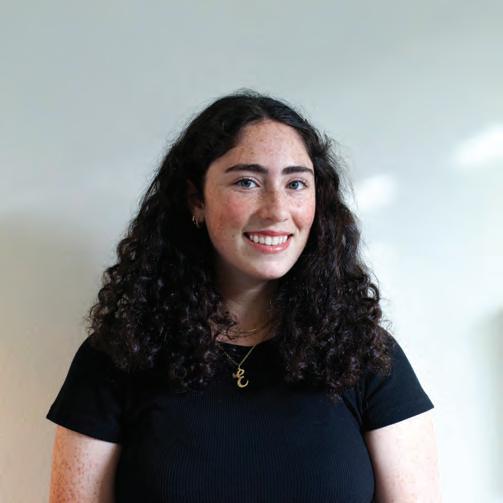
ELYZA NACHIMSON
SCHOOL OF VISUAL ARTS (SVA)
Elyza Nachimson is a senior pursuing a Bachelor of Fine Arts in Advertising at SVA. As an art director, she considers herself to be an upside-down problem solver. She loves to take on a challenge or creative brief and consider all angles of a solution, especially the unexpected ones. Outside of her love for advertising and design, she enjoys spending quality time with her friends and family, listening to music, rooting for the NY Mets, and experimenting with reflection photography. Last summer, Elyza had the opportunity to intern as an art director at Dentsu Creative and is excited to dive deeper into the advertising world after graduating.
WHAT MAKES YOU FEEL INSPIRED?
Unexpected twists! We see them in ad campaigns, artwork with hidden meanings, and even in books, TV shows, and movies. It’s so inspiring to see these stories build up and surprise people, especially understanding the brainstorming and planning that goes into a good twist.
WHAT AREA OF DESIGN ARE YOU HOPING TO WORK IN OR SPECIALIZE IN?
More than anything I’m hoping to work in a team setting. From my past work experiences, I love being able to bounce ideas with other creatives and see that work go out into the real world.
WHAT IS ONE THING THAT DESIGN SCHOOL HAS TAUGHT YOU THAT YOU DID NOT EXPECT?
One of the most important things I learned at SVA is that every project can have an infinite number of ideas, and the best ideas come when you think you’ve thought of everything else.
DO YOU CURRENTLY, OR DO YOU PLAN TO, DESIGN FOR ANY CAUSES OR CHARITIES?
Through SVA, I’m currently working with WildAid on a campaign to encourage people to build awareness of climate change and take action to help the environment.

SABRINA VALDERRAMA
SCHOOL OF VISUAL ARTS (SVA)
Sabrina is a senior focusing on UI/UX design and also exploring 3D work and motion graphics. She enjoys exploring different disciplines of design to strengthen her work while also exploring the mediums she’s been interested in over the years. She’s always appreciated and had a passion for the arts in different fields like music, media, and print, and hopes to work in one of these industries to pursue her passion. She is never afraid of a challenge and enjoys taking on leadership roles and working with others to face a problem at hand in order to come up with a creative solution. She loves pushing her boundaries and taking on new skills and opportunities to continue becoming a better designer.
WHO IS SOMEONE YOU LOOK UP TO IN YOUR FIELD? EITHER TODAY OR HISTORICALLY?
I personally don’t look up to just one person in my field. This industry is full of creatives who have different ways of expressing their passions so it’s hard to just find one person to look up to since I find inspiration in so many creatives. Especially now with social media, I find a new designer whose work inspires me almost every day.
WHAT ARE YOU READING/LISTENING TO/WATCHING?
I’ve been watching the show Law and Order: SVU recently. I think it’s a great show to just have in the background while doing my work. Every episode deals with a different plot, which is kind of like how each task I work on while watching is different. It definitely keeps me entertained while I’m sitting in front of my laptop for hours on end.
DO YOU FEEL THAT DESIGN SCHOOL HAS PREPARED YOU TO SEARCH FOR AND FIND A JOB?
Design school has definitely planted the seeds for helping me become a strong designer and strong person overall. It gave me the resources and support I needed to be able to push myself past any boundaries I had. It was up to me to use these resources and support in the best way possible to continue improving my skills and confidence in my work so that I would be confident in my job search.
64 GDUSA 2024 | STUDENTS TO WATCH
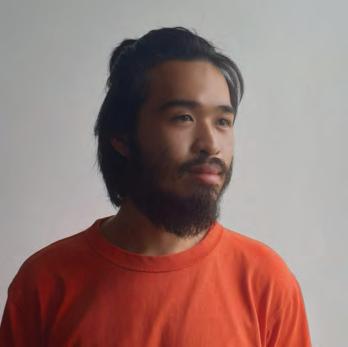
HONG NHAT PHAM
SAVANNAH COLLEGE OF ART AND DESIGN (SCAD)
My name is Hong Nhat Pham. I am a multidisciplinary designer based in Saigon, Vietnam, and a Graphic Design and Visual Experience M.F.A. candidate at Savannah College of Art and Design. I have always been fascinated with media, new technologies, and the ability to further my knowledge. Working as a multidisciplinary designer, six years ago, was my first foray into the advertising industry and, later on, being in-house, allowed me to dabble in many creative fields, like advertising, front-end development, interactive pieces, conceptual works, and more. Right now, I am working on my thesis about how designers and creatives can navigate the great opportunities and challenges that AI might bring about.
WHAT MAKES YOU FEEL INSPIRED?
Waking up and seeing my fellow designers' creativity and passionthis makes me realize how much there is to learn each day.
WHAT AREA OR AREAS OF DESIGN ARE YOU HOPING TO WORK IN OR SPECIALIZE IN?
The area of design is perhaps not as important to me as the opportunity to experiment and do work that challenges my skills and conceptual thinking.
WHAT IS ONE THING THAT DESIGN SCHOOL HAS TAUGHT YOU THAT YOU DID NOT EXPECT?
SCAD taught me the importance of playing with my hands and physically putting something together. My professors at SCAD have always encouraged me to see things through different lenses.
WHO IS SOMEONE YOU LOOK UP TO IN YOUR FIELD? EITHER TODAY OR HISTORICALLY?
Besides the great designers of the past and today, I look up to the people that surround me: my family, co-workers, professors, and my classmates at SCAD. I don't have to look far to learn something new each day.

ISABELLA SOTTILE
SAVANNAH COLLEGE OF ART AND DESIGN (SCAD)
I was born and raised in Savannah, Georgia, but most of my life before attending SCAD was spent pursuing a career in classical ballet. After dancing professionally for one year post high school, I decided to pursue college in New York City. Before landing in the design industry, I studied art history and fashion marketing. Then, two years into college, I discovered the world of graphic design, and I knew I had to return to Savannah to study at SCAD. Since studying at SCAD, I have been honored to receive awards from Communication Arts and GDUSA for my school projects. After graduation, I will be moving to New York City to join Temple St. Clair Fine Jewelry as their Design and Brand Coordinator.
WHAT MAKES YOU FEEL INSPIRED?
I feel most inspired when I’m working in collaborative environments, with other creative individuals who truly care about the power of good design.
WHAT ARE YOU READING, LISTENING TO, WATCHING (BOOKS, MOVIES, TV, SOCIAL MEDIA, MUSIC)?
I’m currently reading Twyla Tharp’s The Creative Habit, and my favorite music group that I’m listening to right now is Nathaniel Rateliff & The Night Sweats.
DO YOU CURRENTLY, OR DO YOU PLAN TO, DESIGN FOR ANY CAUSES OR CHARITIES?
I currently design for charities in my Savannah community and hope to continue doing so — I believe we have an obligation as designers to use our talents to make the world a better place.
DO YOU FEEL THAT DESIGN SCHOOL HAS PREPARED YOU TO SEARCH FOR AND FIND A JOB?
SCAD has prepared me very well to search for a job that best fits my interests, and to succeed in that job by offering a wide variety of skills that would benefit any team I join in the future.
GDUSA 65

ASHLEY GIROUARD
SYRACUSE UNIVERSITY SCHOOL OF DESIGN
Being a designer was never my plan, but somewhere along the way, this whole design thing really grew on me. I have always loved the thrill of having a crazy idea and working backward to figure out how to pull it off. I was surprised to realize that designers get to do that every day! Many of my interests in life aren’t directly related to design, but I love bringing design to everything I do. Whether I’m interviewing artists for my radio show, helping on the set of a music video, or planning a birthday party for my friend, I’m not technically doing any design, but I often catch myself still being a designer. Being a designer, to me, is a perfect concoction of curiosity, passion, and the relentless pursuit of awesomeness. I’m realizing more and more that I might have been a designer all along. I love big ideas, working through the “impossible,” and bringing energy to every aspect of a project. Right now, I'm most excited about package design, branding, illustration, and video, but my interests grow every day.
WHAT MAKES YOU FEEL INSPIRED?
I love acquiring random hobbies and getting really invested in them. Recently, I accidentally became a DJ. It's so cool to be all in on learning something new, and I'm often inspired by the new people, jargon, and experiences that a hobby brings me. This semester, I designed a musicrelated app that I would never have been able to do without my newfound DJ knowledge.
WHAT AREA OR AREAS OF DESIGN ARE YOU HOPING TO WORK IN OR SPECIALIZE IN?
I want to be a builder of worlds. Design that excites me most is design that allows us to experience something that has its own rules, characters, and feelings. I would love to work with startups or new brands to build from the ground up, collaborate with musical artists to create immersive tour and album experiences, or assist anyone trying to orchestrate an experience that allows others to enter a land of fantasy and surprise.

FRANCINE TONGOL
SYRACUSE UNIVERSITY SCHOOL OF DESIGN
Francine Tongol is a renaissance-minded senior pursuing a BFA in Communications Design with a minor in Information Management & Technology. She was born in the Philippines and raised on Long Island, New York. With an unwavering belief in the enchantment of life, she shamelessly views the world through rose-tinted glasses, maintaining a childlike wonder that she never outgrew. Her design philosophy is akin to being a chameleon, adapting seamlessly to the diverse styles and voices of each project. In her eyes, brands are not just entities; they possess a personality and soul, each a visual being with its own narrative. She passionately believes in the power of connecting with brands on a deeper level—interacting, experiencing, and living alongside them. She believes in making room for humanity in her work. Her mission extends beyond aesthetics; she envisions designs that evoke emotions, brighten someone's day, or instill a profound impact. In her hands, design becomes a conduit for forging meaningful connections, a testament to her commitment to infusing life into every project she undertakes
WHAT IS ONE THING THAT DESIGN SCHOOL HAS TAUGHT YOU THAT YOU DID NOT EXPECT?
Designing with a twist on the familiar. It’s this technique that I think most people including myself didn’t realize we consumed and processed on a subconscious level. It’s what makes some of the best works memorable, and it fascinates me to think about how similar the human experience must be for it to work so well with the masses.
WHO IS SOMEONE YOU LOOK UP TO IN YOUR FIELD?
EITHER TODAY OR HISTORICALLY?
Jessica Walsh
WHAT ARE YOU READING, LISTENING TO, WATCHING?
Watching Baz Luhrmann films. Reading Lightlark. Listening to SZA.
66 GDUSA 2024 | STUDENTS TO WATCH
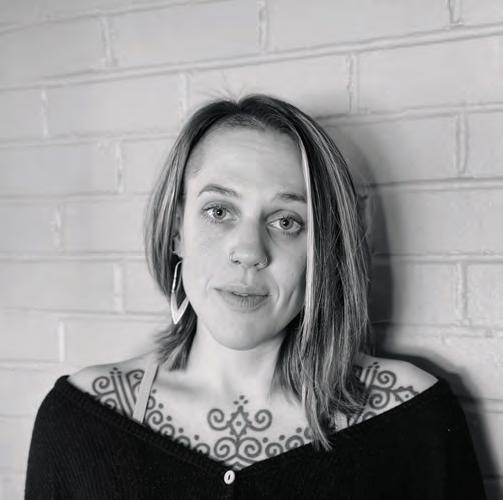
LEAH CHUTZ
VERMONT COLLEGE OF FINE ARTS (VCFA)
Leah is a graphic designer based in Denver, Colorado. She has lived and worked around the world and was most recently located in Taipei, Taiwan where she was a self-employed designer, taught Art and English, and studied Mandarin. Leah's approach to design is intuitive and rooted in her connection to the many places she's traveled. In recent years she has begun to compile a series of personal and historical essays relating to travel, memory, experience, and place. These have started to reveal her process of making visual connections between memories and examining how design can be used to transport you to places you never thought you were capable of going. As an avid biker, mover, and maker, Leah is always up for something new and can honestly say she's (mostly) not afraid to look or be ridiculous doing whatever that newness might be!
WHAT MAKES YOU FEEL INSPIRED?
Movement and new experiences keep me inspired. I'll ride my bike nowhere just as often as I'll ride it somewhere just to have a chance to get out of my head and connect with the world around me. Setting my body into motion is both a source of creative inspiration and a way of centering myself. Meeting new people, exchanging ideas, taking care of my vast plant collection, and getting tattooed from artists around the world also inspires me.
WHAT AREA OR AREAS OF DESIGN ARE YOU HOPING TO WORK IN OR SPECIALIZE IN?
I'd like to move into academia in the new year and reevaluate what my practice looks like. I think 2024 is going to be a defining year for how I decide to move forward with clients and projects that align with my interests and values. I'd love to work with more non profits, outdoor organizations, or local community based projects in and around Denver.
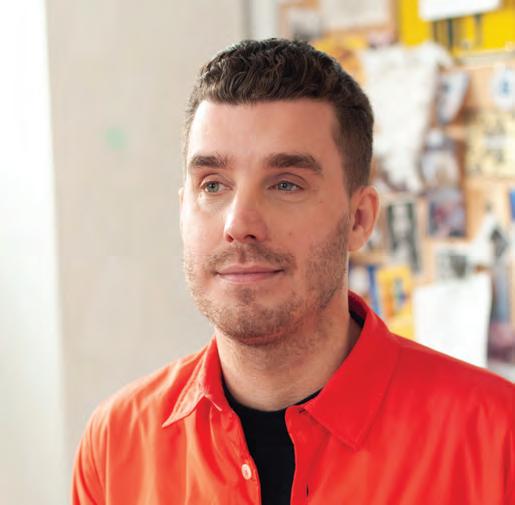
CHRIS LANGE VERMONT COLLEGE OF FINE ARTS (VCFA)
Lange is a graphic & web designer, digital artist, creative coder, creative worker, and 'part-time' professor focused on building community in Toronto, Ontario, Canada. He has 5 years of teaching experience at OCADU and George Brown College in graphic design, web design, interaction design, UI/UX, and any other buzzword you can think of. He also has almost 15 years of industry experience in visual communication in visual identity, custom typography, book, and web projects. He believes in unity, and co-operation instead of competition, and hyper-individualism. His graduate thesis studied the economic and political power structure behind the growth of monopsonies and monopolies. This has led to the realization that individual agency depends upon independent and community ownership models. He recently launched the Anti-Subscription Catalogue (www.a-s-c.org). The A·S·C project advocates for equitable public access to digital tools through open-source, co-operative, and collective ownership models using software that is free, open-source, and a one-time fee—instead of subscription-based. From educational access to digital literacy, Lange is looking to grow A·S·C locally at libraries in the form of workshops that promote a diversity of tools, software, websites, and approaches.
WHO IS SOMEONE YOU LOOK UP TO IN YOUR FIELD? EITHER TODAY OR HISTORICALLY?
Natalia Ilyin. Also if space allows: Vocations for Social Change, Lewis Hine, Berthold Brecht, Willem Sandberg, Ida Tarbell, Terry Gilliam, Jan Tschichold, Harry Braverman, Louis Riel, W.E.B. Dubois, Elizabeth Magie, bell hooks, Ursula K. Le Guin, Ramon Tejada.
DO YOU CURRENTLY, OR DO YOU PLAN TO, DESIGN FOR ANY CAUSES OR CHARITIES?
Nor co-op (www.nor.design) Canadian board member. Continue to work on publicly funded projects. A-S-C.org community-facing workshops. Recently launched https://pictongazette.ca/ — an independent news source and Canada's oldest weekly newspaper.
GDUSA 67
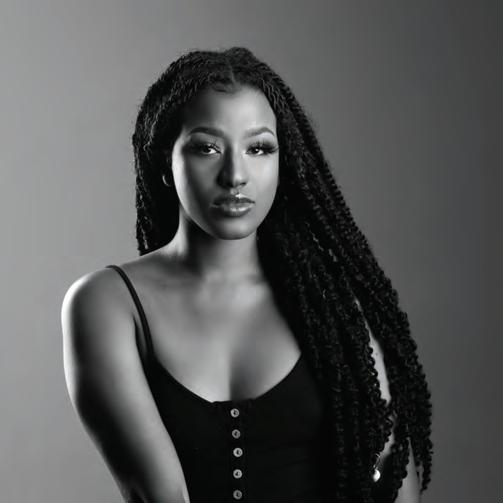
ADDIS BARGE
ARTCENTER COLLEGE OF DESIGN
In the pursuit of a BFA, Addis Barge's creative journey, profound joy is found in weaving connections between people and cultures, narrating tales that transcend time and space. Addis's passion lies in curating and facilitating culturally significant stories, breathing life into forgotten or misrepresented narratives through immersive, physical, and re-imagined spaces. The central question driving Addis's work is: How can design repurpose stories, allowing them to reclaim their rightful place in the collective consciousness?
Approaching design and art direction as a harmonious symphony of creative thinking, collaboration, intimacy, and curiosity, Addis delves into the depths of identity, social structures, and the vast array of perspectives. Each exploration becomes a catalyst for dialogue, sparking the ignition of new ideas that ripple through the open forum of design—a circle of exchange that perpetually evolves.
Within this dynamic dialogue, Addis is thrilled to contribute their perspective. The passion extends to realms such as art direction, research, visual identity design, art curation, trans-media, print/publication design, and the creation of design solutions with a profound cultural impact. Each endeavor is not just a stroke on the canvas but an invitation to partake in the ever-evolving narrative of design, where creativity and humanity dance in perpetual harmony.
WHAT MAKES YOU FEEL INSPIRED?
People, history, ancestral technologies, and current events inspire me. I frequently draw inspiration from both the past and contemporary art. The lens through which I observe the world is also a significant source of inspiration.
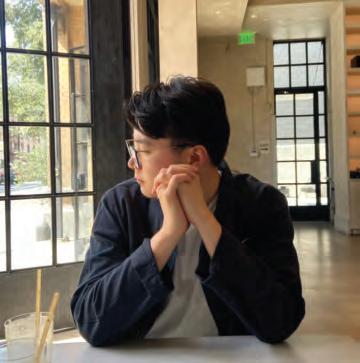
ALAN XU
ARTCENTER COLLEGE OF DESIGN
Alan is a designer that creates elegance and distinction through simplicity, reducing color and form to the bare bones, and then using that medium in the best way possible to create fascinating results. He is also the designer, organizer, and host for ArtCenter's Design Speaker Series, where he invited and hosted over 20 renowned designers from around the world and designed over 5 extensive campaigns for the series.
WHAT AREA OR AREAS OF DESIGN ARE YOU HOPING TO WORK IN OR SPECIALIZE IN?
I don’t have a specific area of design I hope to work in because I am a generalist, I want to get my hands on anything and everything creative from branding and identity to motion graphics and everything in between and beyond.
WHAT IS ONE THING THAT DESIGN SCHOOL HAS TAUGHT YOU THAT YOU DID NOT EXPECT?
Although not directly, ArtCenter has taught me to believe in my own work and abilities as a designer.
WHO IS SOMEONE YOU LOOK UP TO IN YOUR FIELD? EITHER TODAY OR HISTORICALLY?
I look up to co-founder and creative director of Massive Assembly (also my “boss” from my 2023 summer internship), Jason Yeh. His journey from his time at ArtCenter to opening his own studio with his good friend Eugene Seo inspires me.
WHAT ARE YOU READING, LISTENING TO, WATCHING (BOOKS, MOVIES, TV, SOCIAL MEDIA, MUSIC)?
Reading Hardcore Leveling Warrior. Listening to OverThinking by FanKa. Watching Dredd 2012.
DO YOU CURRENTLY, OR DO YOU PLAN TO, DESIGN FOR ANY CAUSES OR CHARITIES?
Not currently, but if I do have the energy and passion in the future I would design for causes and charities.
68 GDUSA 2024 | STUDENTS TO WATCH
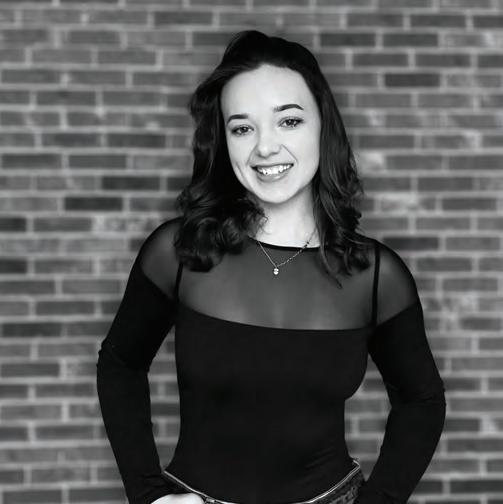
ALENA REVINSKAYA
PRATT MUNSON COLLEGE OF ART AND DESIGN
Alena Revinskaya, a designer from Chicago, is a second-year graphic design student. A childhood interest in art quickly morphed into her passion when Alena realized that she could use her work to enter a world of her own. One where she could portray her values and enthusiasm. Art and design has helped her relate to the community around her. With her community in mind, Alena leveraged her love for art to create distinctive designs and illustrations for t-shirts, posters, children’s books, and murals. Her designs have also been featured on custom-ordered clothes, shoes, accessories, ornaments and greeting cards. In addition to using her experience in the arts to lead workshops for community artists, she has sold her work at various shops and shows locally. Outside of design, Alena loves reading, listening to music and boxing.
WHAT MAKES YOU FEEL INSPIRED?
I find the most inspiration in personal values and passions, whether that is messages and morals that I believe in or hobbies, as well as the people and environment around me. When brainstorming ideas for projects, I tend to focus on things around me that are important in my life or things that the people around me might relate to or find use in. If I am ever stuck in “art block” I like to go on walks and see examples of art in real life and take pictures to make mental notes of what I like or don’t like in design, and how those things can improve my own work.
WHAT AREA OR AREAS OF DESIGN ARE YOU HOPING TO WORK IN OR SPECIALIZE IN?
When I first applied to design school I knew I wanted to do something in this field, but found it very difficult to answer the question of “What do you specifically want to do?” To some extent that may still remain true, since design is such a broad field and you can take it to so many different paths. However, I have grown more and more interested in the idea of branding. I love the idea of all of the historic aspects and/or moral research that goes into creating a brand identity, and I have really been enjoying thinking about what design aspects go into a brand, especially this past semester.
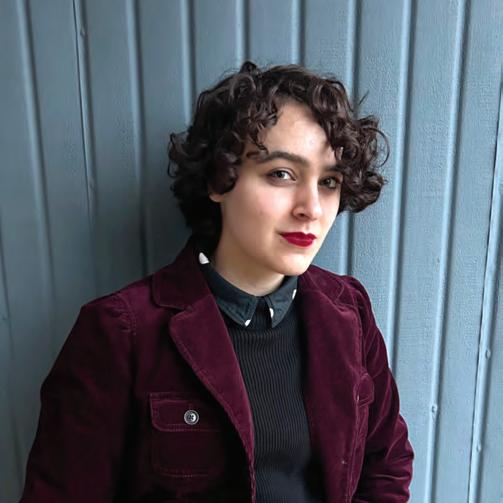
RUBY SCOVILLE
PRATT MUNSON COLLEGE OF ART AND DESIGN
Ruby Scoville is a second-year illustration major, hailing from a small town in Upstate New York. Her work focuses on art as storytelling, utilizing evocative compositions and period-inspired designs. In her spare time, she is constantly developing, writing, and illustrating projects based on her interests in film, history, literature, and the supernatural. Ruby is looking forward to completing her second year after receiving Pratt Munson’s Outstanding FirstYear Student award. Once she graduates, she hopes to continue developing her personal projects alongside a profession in the illustration industry.
WHAT IS ONE THING THAT DESIGN SCHOOL HAS TAUGHT YOU THAT YOU DID NOT EXPECT?
Above all else, confidence in my personal passions and interests, and the ability to share my enthusiasm about them with others.
WHO IS SOMEONE YOU LOOK UP TO IN YOUR FIELD? EITHER TODAY OR HISTORICALLY?
Marc Davis has been a huge idol of mine since I was very young, his illustrations possess a degree of life and personality I hope to match someday.
WHAT ARE YOU READING, LISTENING TO, WATCHING (BOOKS, MOVIES, TV, SOCIAL MEDIA, MUSIC)?
I am currently watching W. S. Van Dyke’s The Thin Man film series, reading P.G Wodehouse’s Jeeves books, and listening to anything by Ambrose and his Orchestra.
DO YOU CURRENTLY, OR DO YOU PLAN TO, DESIGN FOR ANY CAUSES OR CHARITIES?
I would like to design for and raise awareness about the Old Growth Forest Network.
GDUSA 69
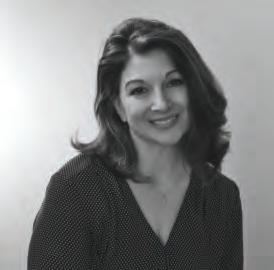
CAROLINE ITALIA CARLSON
FULL SAIL UNIVERSITY
Caroline Italia Carlson is enthralled with graphic design and fine art. She has won awards in both arenas. A native New Yorker, Caroline began her career on the East Coast, working in graphic design and illustration. Upon moving to California, she dove into magazine design and web design and development. She relocated to the Midwest in 2013, working in all facets of marketing. Caroline became a podcaster in 2017 and is the host of the Passionate Painter Podcast. She now resides in the Upper Peninsula of Michigan, where she works as a media specialist. She loves to teach and does so through oil painting workshops and several of her own online art and design courses. Caroline has a bachelor's degree in studio art and a minor in art history, and has always wanted to earn her MFA. As a working designer, she found the perfect fit through Full Sail University's online Media Design Master of Fine Arts program.
WHAT MAKES YOU FEEL INSPIRED?
Art inspires me, whether it’s music, a great design, a work of fine art, or a written work. Of these, music has been the most influential, providing inspiration for many of my paintings.
WHAT AREA OF DESIGN ARE YOU HOPING TO WORK IN OR SPECIALIZE IN?
Branding. I love working as a media specialist and am eager to apply what I’m learning to strengthen branding efforts where I am currently employed.
WHAT IS ONE THING THAT DESIGN SCHOOL HAS TAUGHT YOU THAT YOU DID NOT EXPECT?
I expected to learn more about the design industry, but I’m gratified by how well Full Sail University’s Media Design MFA program connects design instruction and its application on the job. Full Sail University has given me confidence by honing my experiential knowledge while providing a foundation and context for advancing to the next level.
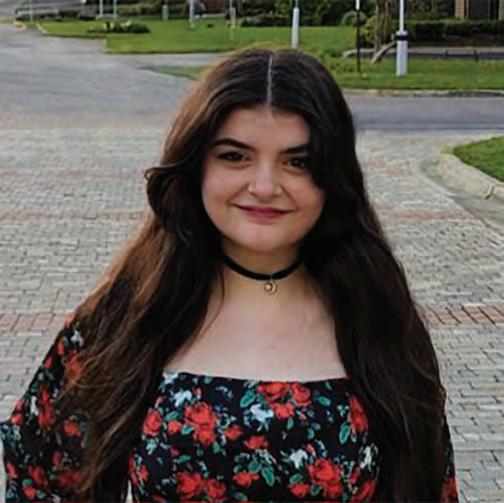
NICOLE MONTES
FULL SAIL UNIVERSITY
I was born in Tallahassee, Florida, but raised in Texas. I am graduating with a degree in Bachelor of Science in Graphic Design. After receiving a diagnosis of ADHD and Dyslexia, my parents decided to homeschool me. During that time, I learned to manage my learning differences. As a differently-abled individual, my brain works differently and is full of creativity. I work on my own techniques to help my brain focus and cultivate my creativity. I am passionate about creating innovative and meaningful designs that will produce emotional responses in the audience. My education at Full Sail has been an incredible journey of encouragement where I was constantly reminded that I could successfully reach my dream of becoming a designer. I have reached my dream through Grace, hard work, dedication, and the Full Sail faculty's incredible support, which is extended even after graduation. Full Sail never abandons its students and is determined to help us succeed. The university’s motto is "If you're serious about your dreams, we'll take your dream seriously." I can attest that Full Sail University certainly means it, for which I am forever grateful.
WHAT MAKES YOU FEEL INSPIRED?
I follow my passion and look within for inspiration to deliver meaningful and impactful visual designs.
WHAT AREA OF DESIGN ARE YOU HOPING TO WORK IN OR SPECIALIZE IN?
I plan to specialize in illustration, merchandise designing, and web, branding, advertising, and marketing design.
WHO IS SOMEONE YOU LOOK UP TO IN YOUR FIELD? EITHER TODAY OR HISTORICALLY?
I have admired Hayao Miyazaki and his work for a long time, even though he is not a graphic designer. He has an inspiring love and passion for art. He persistently pursued his dream to become an animator. With passion, great imagination, and determination, Miyazaki uses brilliantly painted backgrounds with persuasive characterization to make the fantasy world look like the real world.
70 GDUSA 2024 | STUDENTS TO WATCH
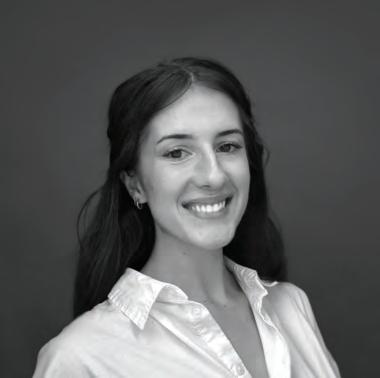
JANET DELAVAN
PARSONS SCHOOL OF DESIGN
Janet is a multidisciplinary designer, illustrator, and current senior pursuing her BFA in Communication Design set to graduate Spring of 2024. Based in New York City, her primary interests lie in branding, editorial design, and bookbinding techniques. Beyond her studies, she serves as the Creative Director for the New School Free Press, a student-run news organization, and assists fellow students as a Print Tutor Specialist with any bookbinding or printing concerns they might have. She believes fostering empathetic and joyful communication through thoughtful visual systems that keep viewers hooked is the priority. Her overarching goal is to incorporate care into the craftsmanship of design and include a genuine sense of fun within each project; creating for others and herself to enjoy.
WHAT MAKES YOU FEEL INSPIRED?
Going outside, talking to friends, book window-shopping, or making it a game to notice something new every day.
WHAT AREA OF DESIGN ARE YOU HOPING TO WORK IN OR SPECIALIZE IN?
I plan to specialize in editorial design or any book-making that I can get my hands on. However, what I really enjoy is creating systems - implementing, and repeating a visual language across various forms of media. Working in a brand studio, the publishing world, or in editorial is my hope.
WHAT IS ONE THING YOUR TIME IN DESIGN SCHOOL HAS TAUGHT YOU THAT YOU DIDN’T EXPECT?
How important it is to see other student’s work and to bounce ideas off each other. I wouldn’t have known how expansive graphic design could be; there really aren’t any rules! Design school, mostly through practice and feedback, removed the walls I used to put up for myself. I now know myself better as a creative, whereas before, I didn’t realize that I was completely lost in my identity as a designer. I know what I like, I know how to communicate why, and how to apply it. I also realize I’m in a privileged position, learning and attending art school and I’m extremely grateful to have such amazing professors who have been such an inspiration. I’m very lucky that I can pursue a dream career like this within the arts.
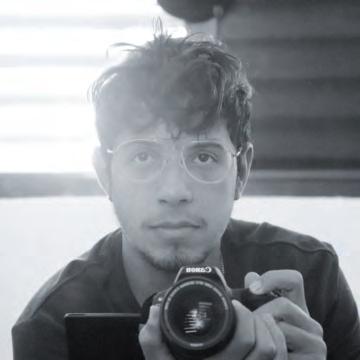
RODRIGO ALBUQUERQUE GOUVEIA
PARSONS SCHOOL OF DESIGN
Rodrigo is a Brazilian American graphic designer currently enrolled in the Communication Design graduate program at Parsons School of Design. He began his career with editorial design and then spent a couple years freelancing in the interior design hub of Los Angeles. In recent years, he has spent most of his time in an agency environment working for non-profits and social justice advocates. The vastly different projects he engaged with during his career made him more of a generalist designer, multitasking among branding, advertising, motion, and web. Now, at Parsons, he is venturing into the realms of user interface and experience design.
Rodrigo is deeply passionate about crafting narratives through his work and storytelling. He firmly believes that through design, one can communicate and connect ideas, and by doing so, designers possess the unique ability to select and organize the flow of information, taking their audience through distinct paths and journeys.
Outside of work (or school assignments), you will find him exploring coffee shops, capturing silly moments through his lens, or immersing himself in different worlds through his Switch.
WHO IS SOMEONE YOU LOOK UP TO IN YOUR FIELD?
EITHER TODAY OR HISTORICALLY?
Honestly, I am so inspired by my current professors. If I may mention names, Brendan Griffiths and Clara Bunker have reignited the flame of design over and over across the semester.
WHAT ARE YOU READING/LISTENING TO/WATCHING?
School has taken over all my readings, currently: Creative Selection by Ken Kocienda. As for music, I'd say Bad Bunny, but my Spotify Wrapped said it's Taylor Swift. One social media? Lapse.
DO YOU CURRENTLY, OR DO YOU PLAN TO, DESIGN FOR ANY CAUSES OR CHARITIES?
I currently design for a communications agency that exclusively serves non-profits and social justice campaigns.
GDUSA 71
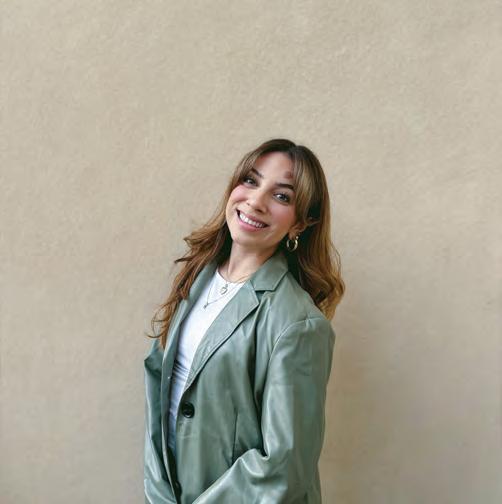
ALEXIS GALLEGOS
USC ROSKI SCHOOL OF ART AND DESIGN
Alexis Gallegos is a creative driven by art direction, strategy, and self-care; with a love for the intersection of design and advertising. Thriving in the agency world, she brings a hands-on approach to brand development, contributes to innovative marketing initiatives, and engages in strategic planning. Gallegos is currently pursuing her undergraduate degree in Design and Advertising at the USC Roski School of Art and Design, with a graduate specialization in Public Relations & Advertising. In her design work, the designer prioritizes collaboration, creative intuition, and infusing joy and positivity into every project. Beyond her creative pursuits, she's a nature enthusiast, finding inspiration in outdoor adventures with her Goldendoodle. As Gallegos advances in her studies and career, she aims to use her creative skills for a positive impact. Her diverse design approach and strategic mindset position her to shape compelling narratives in advertising and beyond. Alexis Gallegos isn't just a creative; she's a storyteller, crafting narratives that resonate and inspire.
WHAT MAKES YOU FEEL INSPIRED?
Interdisciplinary exploration. Before I went to the design school, I thought most “design” was done by one person and usually had a specific category, such as product design, graphic design, and architecture design. But my experience collaborating with people from different fields in design school has enriched my mind. Design is a tool, a way of thinking, and developing a good design requires interdisciplinary exploration.
WHAT AREA OR AREAS OF DESIGN ARE YOU HOPING TO WORK IN OR SPECIALIZE IN?
I aspire to specialize in art direction and creative strategy within advertising agencies. Additionally, I aim to contribute to smaller studio environments, leveraging my skills to cultivate the growth and success of emerging businesses.
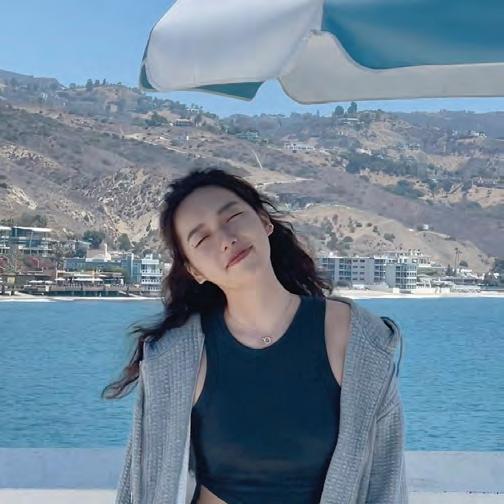
HANA ZHAO
USC ROSKI SCHOOL OF ART AND DESIGN
Hansha (Hana) Zhao is a second year MFA Design student at USC Roski School of Art and Design. She is originally from China and is currently based in Los Angeles, California. As a designer she has a strong interest in brand visual identity systems, publications, and editorial design; and enjoys incorporating abstract and geometric elements into her projects. Emphasizing the importance of visual storytelling, Zhao’s work focuses on delivering information, narratives, and emotions accurately, directly, and concisely. Other creative work includes motion graphics and collage. Hana always tries to keep it interesting.
WHAT IS ONE THING THAT DESIGN SCHOOL HAS TAUGHT YOU THAT YOU DID NOT EXPECT?
To reflect on yourself when giving feedback to others. It aligns with the idea that providing constructive feedback is not just about pointing out my thoughts for others' work, it also prompts me to question myself, asking what strategies I would adopt and how I could enhance the project's integrity if I were in charge. Through this process, I can approach the work more objectively, treating design with more thoughtful consideration.
WHO IS SOMEONE YOU LOOK UP TO IN YOUR FIELD? EITHER TODAY OR HISTORICALLY?
Paula Scher, Saul Bass, and Warren Lehrer.
WHAT ARE YOU CURRENTLY READING, LISTENING TO, AND WATCHING?
TV: "Blossoms," a story about the development of the Shanghai stock market and foreign trade industry in the 1990s, and "The Making of Ordinary Woman," a Taiwanese drama that narrates the coming-of-age stories of women.
For music: “Standing Next to You” by Jungkook, “Yes or No” by Jungkook, as well as “Love Wins All” by IU, God of Music by SEVENTEEN, and “Wife” by (G)I-DLE.
DO YOU PLAN TO DESIGN FOR ANY CAUSES OR CHARITIES
I designed for the charity A Climate Citizen last year.
72 GDUSA 2024 | STUDENTS TO WATCH
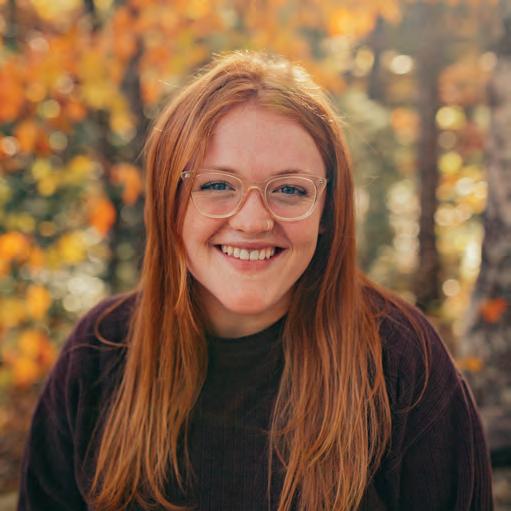
CHARITY JACK
UNIVERSITY OF CENTRAL OKLAHOMA
Charity Jack is a graphic design student at the University of Central Oklahoma. Originally from Oklahoma City, her journey into the world of design was influenced by her experiences living abroad in Thailand and Scotland. Inspired by a love for photography, writing, and illustration, and a deep appreciation for the beauty in everyday life, Charity found her passion in graphic design. Currently pursuing a major in graphic design with a minor in illustration, Charity's unique perspective combines aesthetics with functionality. Her work is characterized by meticulous attention to detail, a strong work ethic, and a contagious joy that permeates her designs. Charity's work has been recognized through numerous awards, including accolades from the ADDYs, Flux, GDUSA, and Communication Arts.
WHAT MAKES YOU FEEL INSPIRED?
Looking at vintage packaging, being in nature, exploring more tactile and analog methods of design, and my faith.
WHAT AREA OR AREAS OF DESIGN ARE YOU HOPING TO WORK IN OR SPECIALIZE IN?
Ideally, I would love to work in package design or anything print media.
WHAT IS ONE THING THAT DESIGN SCHOOL HAS TAUGHT YOU THAT YOU DID NOT EXPECT?
It taught me how to self-teach and self-motivate. The field requires those qualities and design school stretched and further developed those qualities in me.
WHO IS SOMEONE YOU LOOK UP TO IN YOUR FIELD? EITHER TODAY OR HISTORICALLY?
Today, I am very inspired by and look up to Annie Atkins--her career and work excite me for less traditional avenues of Graphic Design.
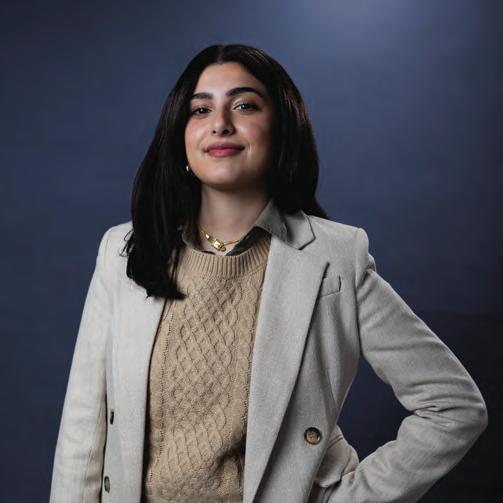
YOUSER KASSIM
UNIVERSITY OF CENTRAL OKLAHOMA
Youser Kassim is a Middle Eastern designer who grew up in Chicago. She has a deep passion for art, architecture, and design history. Her love for these subjects led her to switch from engineering to graphic design during college. Currently, she is pursuing a minor in design history in the UCO design program. Youser has spent her summers interning and contributing to the design community in various ways. She is also the Vice President of her school's AIGA student group. During her senior year, she gained valuable professional experience by working at a design agency located in Oklahoma City. In addition to her other responsibilities, Youser works part-time as a research assistant for her school's design history podcast. This has helped her to deepen her understanding of the history of design. Despite having a busy schedule, she maintains a positive outlook and values every opportunity to enhance her skills and work ethic.
Youser plans to continue working in her field and hopes to pursue a master's in design history. She wants to use her work to contribute to her Middle Eastern heritage and combine traditional and modern design to create unique designs.
WHAT ARE YOU CURRENTLY READING, LISTENING TO, AND WATCHING?
I enjoy listening to Lauryn Hill, Erykah Badu, Nas, and old-school Kanye. I also enjoy true crime podcasts like Rotten Mango.
DO YOU PLAN TO DESIGN FOR ANY CAUSES OR CHARITIES
I would love to contribute my skills and effort to UNICEF and help communities that have been affected by war and tragedy.
DO YOU FEEL THAT DESIGN SCHOOL HAS PREPARED YOU TO SEARCH FOR AND FIND A JOB?
Yes, I believe that design school has helped me build my confidence and work ethic to a higher level, which has helped me find a job in the field.
GDUSA 73
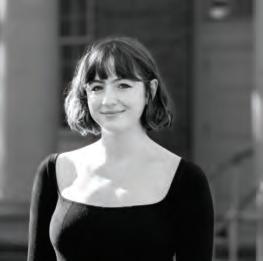
ERIN SECOSKY
NC STATE COLLEGE OF DESIGN
Erin Secosky is a graphic and experience designer from Raleigh, NC. Currently in her third year at North Carolina State University, Erin wants to explore how design can shape better futures for our world and question ideology. In her design work, she loves to experiment with new mediums, both digital and analog, like 3D modeling, augmented reality, screen printing, and cyanotype. When she’s not designing, you can often find Erin dabbling in cooking, collecting records, being outdoors, and spending time with loved ones.
WHAT MAKES YOU FEEL INSPIRED?
Randomness. I love browsing Wikipedia using “Special:Random” and just seeing what turns up. It’s a great way to find new topics I would’ve never heard about. In a more visual way, I’ve always been inspired by math and modular patterns. I’ve been really inspired by ASCII art, particularly the work of Heikki Lotvonen and his website glyphdrawing.club. I’m fascinated by modular design, especially when it comes to typography and I’ve been using the site to develop my own glyphs for a variable typeface!
WHAT AREA OR AREAS OF DESIGN ARE YOU HOPING TO WORK IN OR SPECIALIZE IN?
I have no clue. I’d love to work a variety of jobs to learn through doing what I enjoy, but at the moment I’m interested in type design, cartography, and speculative design. I’d also love to be a professor one day- there is so much to learn from teaching others.
WHAT IS ONE THING THAT DESIGN SCHOOL HAS TAUGHT YOU THAT YOU DID NOT EXPECT?
Iteration. I never would’ve expected the amount of changes and versions that I make within the scope of my studio projects. My freshman year, I took an interdisciplinary studio and definitely was shocked by the twists and turns the design process can take you on. I’ve really grown to love the process of designing and I appreciate learning to embrace change as an inspiration to my designs.
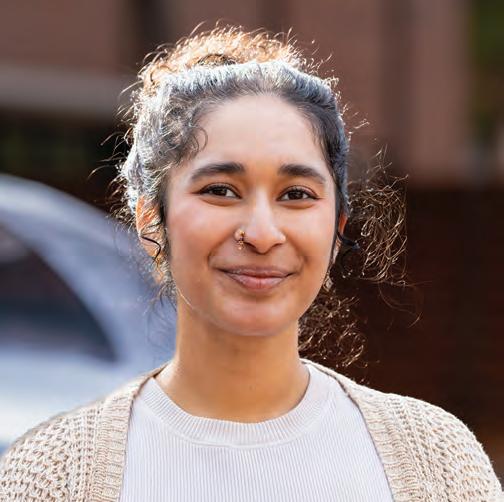
BHAVANA VEERAVALLI
NC STATE COLLEGE OF DESIGN
Bhavana Veeravalli (she/her/hers) is a senior studying Graphic and Experience Design. Her integration into the world of design began when she was young – starting with fingerpainting as a toddler and traditional media in high school before graduating into digital media and product design as an adult (even if she has a hard time believing it). Outside of design, she enjoys reading, volunteering at her community’s Women’s Center, and building connections with and between people.
WHO IS SOMEONE YOU LOOK UP TO IN YOUR FIELD? EITHER TODAY OR HISTORICALLY?
For the sake of being succinct, I will focus on someone who is a career mentor. Their name is AJ Griffies (they/them) and they are a UX Researcher who has worked for a variety of companies such as Lexus Nexus, IBM, Amazon, and now Workiva. However, what I find inspiring about them is how they live and embody their values in whatever context they find themselves in. They lead with kindness and empathy. Although they are a researcher and I am a designer, they have influenced how I approach design as a research-centered process. In doing so, I see more of the humanity in what I design, because people are at the forefront.
WHAT ARE YOU READING, LISTENING TO, WATCHING (BOOKS, MOVIES, TV, SOCIAL MEDIA, MUSIC)?
Right now, I am thinking a lot about my spirituality, so I have been re-reading the Bhagavad Gita, which is an important text in Hinduism that discusses what purpose means in life. Outside of that, I am listening to a lot of Shakira.
DO YOU CURRENTLY, OR DO YOU PLAN TO, DESIGN FOR ANY CAUSES OR CHARITIES?
I am currently designing for the Women’s Center at North Carolina State University. I am working on the promotional materials and branding for Take Back the Night, a protest, march, and survivor speak-out for survivors of sexual violence. In the future, I would like to be part of non-profit or NGO spaces that do similar work in protecting survivors.
2024 | STUDENTS TO WATCH 74 GDUSA
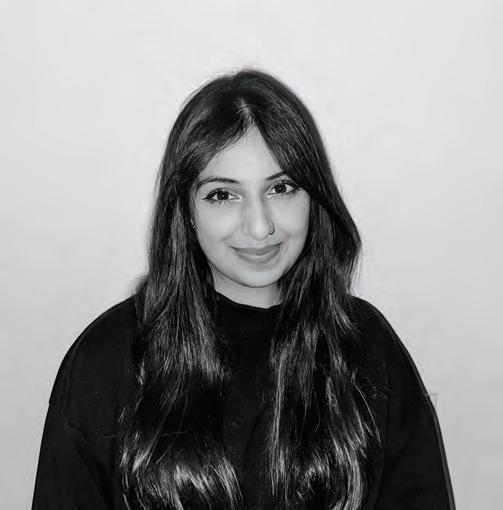
DEVINA BAWA VIRGINIA TECH
I’m Devina, a multidisciplinary designer based in the Washington D.C. metro area. I find joy in creating eye-catching, playful designs within visual branding, illustration, and packaging design work. I am currently on an exciting journey of creative self-exploration where I draw inspiration from global influences, especially that of my Indian heritage. Through this process, I experiment with traditional colors, patterns, and textures, and combine them with contemporary design principles. This way, I hope to produce soulful visual narratives that resonate with my cultural identity. Beyond the studio, you can find me searching for my next signature fragrance, baking up a storm in the kitchen, or having an A24 movie marathon with my best friends.
WHAT MAKES YOU FEEL INSPIRED?
All the types of media I consume daily. Digital mood boards full of film posters and vintage typography. Seamless Instagram carousels featuring insane art direction. And music, that oftentimes happens to match the aesthetic I am designing in.
WHAT AREA OR AREAS OF DESIGN ARE YOU HOPING TO WORK IN OR SPECIALIZE IN?
I’m interested in art direction, branding, and packaging design. Because makeup and fragrance are a big part of my self-identity, it would be amazing to be able to work in the beauty industry.
WHAT IS ONE THING THAT DESIGN SCHOOL HAS TAUGHT YOU THAT YOU DID NOT EXPECT?
How important it is to find an equally passionate group of creatives who will inspire you to go the extra mile, to work through your blocks, and will motivate you to explore design past the realms of what you are already familiar with.
WHO IS SOMEONE YOU LOOK UP TO IN YOUR FIELD? EITHER TODAY OR HISTORICALLY?
Andrey Azizov is a designer who has been killing it in the music industry. I admire his strong appreciation for eccentric typography and textures. It always impresses me how he incorporates both classic and modern elements into his work, creating a timeless, yet trendy feel.
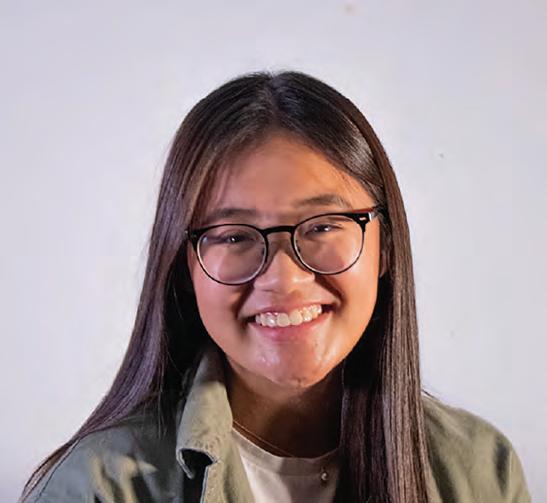
KATINA TRAN
VIRGINIA TECH
I'm a graphic and UI/UX designer based in Northern Virginia. With an interest in branding and static design, I prioritize collaboration, professionalism, and experimentation with design trends in my work. I find importance in creating for the community and incorporating a learning mindset throughout my whole design process. I am fueled by hand lettering, milk tea, and creating Spotify playlists for all occasions.
WHAT ARE YOU READING, LISTENING TO, WATCHING (BOOKS, MOVIES, TV, SOCIAL MEDIA, MUSIC)?
Currently reading: "Big Data, Big Design: Why Designers Should Care about Artificial Intelligence" by Helen Armstrong
Currently watching: Korean dancing shows and catching up on old movies that everyone has seen except me
Currently listening to: Seventeen, 5 Seconds of Summer, Sleeping at Last
Current IG Explore page: lots of Snoopy, relaxing painting videos, and UI advice carousels.
DO YOU CURRENTLY, OR DO YOU PLAN TO, DESIGN FOR ANY CAUSES OR CHARITIES?
I do not design for causes or charities, but I create graphics and social media content for various organizations in my community. I have served on 4 different officer boards during my time at school, helping create graphics for events and initiatives. I also design and take pictures for my church youth group. I think being able to use my talents to help the clubs and organizations I am part of is a great way to give back and contribute to the overall success of these hard-working groups.
DO YOU FEEL THAT DESIGN SCHOOL HAS PREPARED YOU TO SEARCH FOR AND FIND A JOB?
Yes! Design school has connected me with so many people and fine tuned my skills to be able to do good work post-grad. Because of my time in design school, I feel confident in my abilities and strengths, which comes in handy when doing job interviews and stepping into a new job or experience.
GDUSA 75
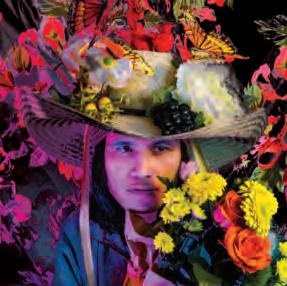
SAKARIT CHANKAEW
PRATT INSTITUTE
I am a Thai-American designer who began my career working as an assistant designer at two fashion houses and a footwear atelier in Bangkok, Thailand, developing skills in illustration, patternmaking, and textiles. Later, as co-curator at Conference of Birds, an alternative art space in Bangkok, I exhibited work by international contemporary artists. I then worked as a web designer and developer, exploring new possibilities offered by digital media. For several years I have also volunteered as a coordinator, designer, and webmaster for Dignity Returns, a garment factory cooperatively managed by former sweatshop workers.
I have continued to develop my multidisciplinary approach and “maximalist” vision further at Community College of Philadelphia, where I completed my Associates degree in Art and Design, and now Pratt, where I am now a Communications Design BFA student. In my current practice I am working to translate the humancentered design, sustainability, and visual expressiveness that I associate with my hometown in Northern Thailand to new media, including digital design, environmental graphic design, and fashion.
WHAT MAKES YOU FEEL INSPIRED?
I am very omnivorous, and thrive on new experiences and technologies. Each day brings fresh opportunities for discovery and unlikely juxtapositions.
WHAT AREA OF DESIGN ARE YOU HOPING TO WORK IN OR SPECIALIZE IN?
I am now exploring environmental graphic design (EGD), which offers the opportunity to merge sculpture, fashion design, animation, virtual and augmented reality, and many aspects of graphic design to develop a total, immersive spatial experience for participants. My style is very “maximalist,” and I work across many different media, so EGD seems like one way to integrate my various interests.
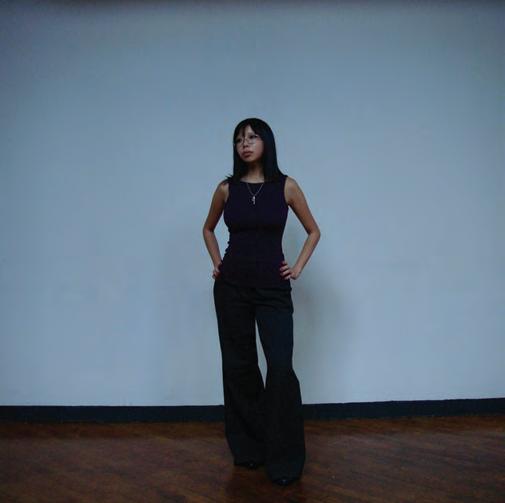
MELANIE LEUNG
PRATT INSTITUTE
Melanie Leung, a designer from New York City, currently attends Pratt Institute as a Communications Design (emphasis in Graphic Design) student. Aiming to explore the interplay between digital and physical realities, Leung is constantly intrigued by the prospect of generating captivating visuals using 3D, print, and other diverse forms of multimedia.
WHAT IS ONE THING THAT DESIGN SCHOOL HAS TAUGHT YOU THAT YOU DID NOT EXPECT?
I started to embrace the impact of design in all areas of my life. Attending design school has helped me cultivate an open-minded approach in my personal creative process, which I originally didn’t have but will now always have gratitude for.
WHAT ARE YOU READING/LISTENING TO/WATCHING?
I’m reading Design and the Elastic Mind by Paola Antonelli, listening to PinkPantheress’s new album, and watching Perfect Blue as we speak.
WHO IS SOMEONE YOU LOOK UP TO IN YOUR FIELD?
There is an abundance of designers that I look up to and find out about every day who inspire me. They range from my professors at school to micro-designers on Instagram. Someone who comes to mind right now is Irma Boom, whose artist’s books I really enjoy seeing.
DO YOU CURRENTLY, OR DO YOU PLAN TO, DESIGN FOR ANY CAUSES OR CHARITIES?
Presently, I’m leading the design of zine editions and identity for an upcoming AAPI group launch. I aspire to eventually design for causes that align with my beliefs and am always open to exploring diverse opportunities.
DO YOU FEEL THAT DESIGN SCHOOL HAS PREPARED YOU TO SEARCH FOR AND FIND A JOB?
Design school is what you make it. My skills unified throughout my time at Pratt, and a large part of this is because of the support I received from faculty, who have always believed in me and created a sense of community within my design experiences.
76 GDUSA 2024 | STUDENTS TO WATCH

AUDREY ALBERS
THE MODERN COLLEGE OF DESIGN
Hi there! My name is Audrey Albers, and I’m currently a secondyear student. I grew up in a small town and always felt a draw to a bigger life in a bigger city. Art has been a prevalent part of my life, and I don’t know where I would be without it. I found my love for graphic design during my junior and senior years of high school and knew that was what I wanted to pursue. I’ve also always been very passionate about performing. Throughout my childhood, I loved theater and sports, and it constantly kept me busy. I am so excited to continue my career in design, and the endless opportunities that await me keep me motivated for my future. I have always loved inciting emotion with my creativity, and I hope to one day make a name for myself as a great package designer.
WHAT MAKES YOU FEEL INSPIRED?
What helps me gain inspiration is being grateful for the little things in life. Something as simple as a frosted glass window could expand my ideas in ways I would never expect. I love exploring new places and taking in everything they have to offer.
WHAT AREA OF DESIGN ARE YOU HOPING TO WORK IN OR SPECIALIZE IN?
My dream is to work in the packaging industry, creating alcoholic beverage labels and brands. I’ve always been drawn to the fun and creative ways they’re designed.
WHAT IS ONE THING THAT DESIGN SCHOOL HAS TAUGHT YOU THAT YOU DID NOT EXPECT?
One thing design school taught me is so much design in the wild is not as good as non-creatives think it is.
WHO IS SOMEONE YOU LOOK UP TO IN YOUR FIELD? EITHER TODAY OR HISTORICALLY?
Two people in my field I look up to are Justin Morter and Matt Flick, two of the instructors I’ve had during my time at The Modern. Justin and Matt have taught me so much about being my authentic self in my design work.

MICAH HERMILLER
THE MODERN COLLEGE OF DESIGN
Hey! I’m Micah Hermiller, a second-year student at The Modern College of Design. In my early childhood, my family moved overseas to Egypt. Having lived the majority of my childhood and younger teenage years in Africa, I have a deep appreciation for the experiences of different cultures. I’ve always been creatively minded, so the fact that I get to design for a living is just incredible. I’m passionate about 3D design, and my time in design school has made me realize how valuable that skill is to the industry. Lately, I’ve been very interested in motorsport design and found a passion for the sport of racing in general. I’m also passionate about music, and over the years I’ve taught myself guitar, bass, and piano. I love what I do, and I plan to be creating for the rest of my life.
WHAT MAKES YOU FEEL INSPIRED?
All forms of art and creation inspire me, but music and design are where I draw the most inspiration.
WHAT AREA OF DESIGN ARE YOU HOPING TO WORK IN OR SPECIALIZE IN?
I love every area of design. I hope to do everything.
WHAT IS ONE THING THAT DESIGN SCHOOL HAS TAUGHT YOU THAT YOU DID NOT EXPECT?
The importance of networking and knowing the right people.
WHAT ARE YOU READING/LISTENING TO/WATCHING?
I don’t watch a lot of shows or movies, but I listen to a lot of music. Bands like Geese, The Strokes, and The Voidz are my favorites.
DO YOU CURRENTLY, OR DO YOU PLAN TO, DESIGN FOR ANY CAUSES OR CHARITIES?
I certainly hope to dedicate some of my time and talent to the causes important to me in the future.
DO YOU FEEL THAT DESIGN SCHOOL HAS PREPARED YOU TO SEARCH FOR AND FIND A JOB?
Yes, I am confident that The Modern will equip me with all the necessary tools to be successful in the industry.
GDUSA 77
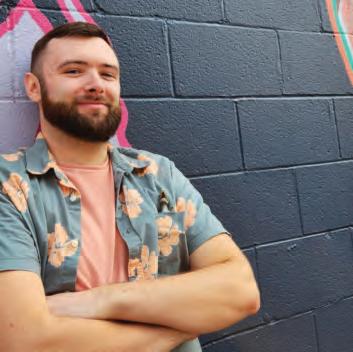
ZACH HASELOW SESSIONS COLLEGE FOR PROFESSIONAL DESIGN
Hi! My name is Zach Haselow. I am a graphic designer living in Columbus, OH, but my heart still lives in my home state of Alaska. I am an avid outdoorsman, and as someone who grew up surrounded by pristine natural landscapes, I derive much of my design inspiration from nature. I love being a graphic designer because it allows me to blend two of my passions, art and empathy. I have always been a creative, and design helps me to harness my creativity into something with a sense of humanity and problem solving. I aim to create solutions that push society forward in a positive manner with respect for people of all backgrounds and above all, the Earth!
WHAT MAKES YOU FEEL INSPIRED?
I feel most inspired by nature. The golden hour sun hitting the mountains speaks to my soul.
WHAT AREA OF DESIGN ARE YOU HOPING TO WORK IN OR SPECIALIZE IN?
I would love to continue work in the cannabis industry doing packaging design or working in the outdoor retail industry.
WHAT IS ONE THING THAT DESIGN SCHOOL HAS TAUGHT YOU THAT YOU DID NOT EXPECT?
What graphic design is. It's a lot more than just logos!
WHO IS SOMEONE YOU LOOK UP TO IN YOUR FIELD? EITHER TODAY OR HISTORICALLY?
I really look up to my Creative Director, Justin Nowak. Honest and driven.
WHAT ARE YOU READING, LISTENING TO, WATCHING (BOOKS, MOVIES, TV, SOCIAL MEDIA, MUSIC)?
I have been listening to a ton of Lofi HipHop and an artist from Alaska called Medium Build.
DO YOU CURRENTLY, OR DO YOU PLAN TO, DESIGN FOR ANY CAUSES OR CHARITIES?
I'd really love to be a part of a campaign for "Opt Outside" from REI.

KRISTIN WEIDEMANN
SESSIONS COLLEGE FOR PROFESSIONAL DESIGN
Kristin Danielle Weidemann was born and raised in California, and is currently based in Nashville, TN. She has been working in the graphic design field for 7 years, getting her design start in the music industry, before branching out into the beverage industry. She is currently completing her Bachelors of Fine Arts Degree in Graphic Design.
WHAT MAKES YOU FEEL INSPIRED?
Being in nature is refreshing, energizing and the colors—especially of sunsets—are so inspiring. In contrast, being in a busy city like New York, and having all your senses activated leaves me feeling inspired by the energy. Seeing good design, photography, and art inspires me to want to create.
WHAT AREA OF DESIGN ARE YOU HOPING TO WORK IN OR SPECIALIZE IN?
I hope to specialize in unique packaging design, as well as creative editorial layout and design.
WHAT IS ONE THING THAT DESIGN SCHOOL HAS TAUGHT YOU THAT YOU DID NOT EXPECT?
The importance of taking the time for the research and conceptualizing step as well as to start fleshing out your ideas on paper before getting onto a computer or starting the actual design process.
WHO IS SOMEONE YOU LOOK UP TO IN YOUR FIELD? EITHER TODAY OR HISTORICALLY?
I am a huge fan of Sharon Werner of Werner Design Werks. Her designs are creative, diverse, and she’s definitely someone I look up to in the packaging / branding design field.
DO YOU FEEL THAT DESIGN SCHOOL HAS PREPARED YOU TO SEARCH FOR AND FIND A JOB?
Absolutely. I feel that my skills, knowledge, confidence, and abilities have all increased significantly, which has helped me achieve more while in school, as well as set me up to succeed with future opportunities.
78 GDUSA 2024 | STUDENTS TO WATCH

NICOLE BEAUDET SYRACUSE UNIVERSITY NEWHOUSE SCHOOL OF PUBLIC COMMUNICATIONS
Nicole Beaudet was born and raised in New Jersey. She is a senior studying graphic design with a minor in marketing. With art direction internship experience at McCann Health NY, Nicole learned the power that creativity has to change lives. She hopes to continue creating work that is rooted in empathy and compassion. When she isn’t busy designing digital experiences, you can find her painting in her sketchbook. Nicole’s background in studio art encouraged her to take that passion to the digital space and embark on creative problem solving.
WHAT MAKES YOU FEEL INSPIRED?
Growing up, I spent most of my time in the school art room. Whether I was working on class assignments or projects of my own, studio art was a constant outlet for me. Similarly, I grew up taking dance classes and found an appreciation for performing arts. Therefore, I often find my inspiration away from the screen. Taking the time to attend concerts and visit art exhibits or even sketch on my own helps to energize me.
WHAT AREA OF DESIGN ARE YOU HOPING TO WORK IN OR SPECIALIZE IN?
I aspire to work in advertising as an art director. Developing big ideas into campaigns is my favorite type of project. I enjoy the collaborative nature of agencies and the ability to work on multiple accounts at once. Additionally, I enjoy designing campaigns that stick with and resonate with people. Watching an idea evolve from a brainstorm to a print ad to an inperson activation fulfills my passion for multimedia storytelling.
WHAT
IS ONE THING THAT DESIGN SCHOOL HAS TAUGHT YOU THAT YOU DID NOT EXPECT?
My most important, yet unexpected, takeaway from design school would have to be resilience. Learning to receive and apply feedback is an essential part of the creative process. Additionally, learning to challenge yourself and teach yourself technical skills outside of the classroom is crucial to growing as a designer.
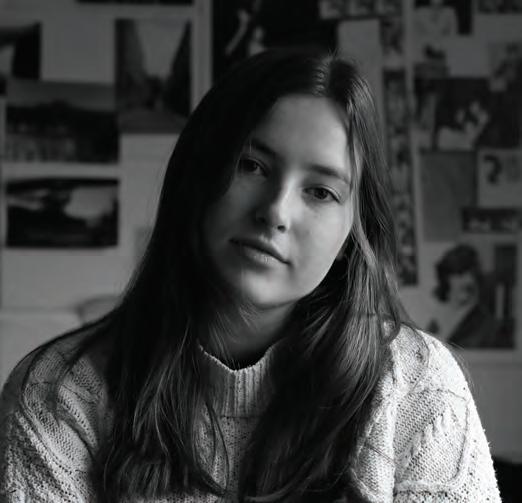
TESS MAZZUCCHELLI SYRACUSE UNIVERSITY NEWHOUSE SCHOOL OF PUBLIC COMMUNICATIONS
My name is Tess Mazzucchelli, I’m from a small town outside of Washington, D.C. I am a senior graphic design major and creative writing minor. It’s been a privilege to be surrounded by talented, creative people in both areas of study. My mother is a graphic designer for a nonprofit, so I’ve benefited greatly from her guidance in work and life. I hope to pursue my own fulfilling design career that allows me to create beautiful things every day.
WHO IS SOMEONE YOU LOOK UP TO IN YOUR FIELD?
EITHER TODAY OR HISTORICALLY?
My Newhouse professors have been huge inspirations. They enthusiastically encourage students to dream big, instilling confidence and skill for the next big steps. I specifically applaud my sophomore year professor, Claudia Strong for playing a crucial role in my early design studies. She taught me how to be meticulous with each design so that they, and I, could reach maximum potential.
WHAT ARE YOU READING, LISTENING TO, WATCHING (BOOKS, MOVIES, TV, SOCIAL MEDIA, MUSIC)?
I take after my father in my love for The Beatles. My walls are covered in memorabilia, my favorite being the White Album poster that came with his original 1968 record. Once hanging in my father’s freshman dorm, it now resides in my college house.
DO YOU CURRENTLY, OR DO YOU PLAN TO, DESIGN FOR ANY CAUSES OR CHARITIES?
I currently do not, but am always open to designing for a good cause. I believe design is an essential tool for communicating positive change.
DO YOU FEEL THAT DESIGN SCHOOL HAS PREPARED YOU TO SEARCH FOR AND FIND A JOB?
I’m grateful for the time and opportunities undergrad has given me to discover my likes and dislikes for a future career. The connections I’ve made and the portfolio I’ve built throughout my time at Syracuse have set me up for success in my job search.
GDUSA 79
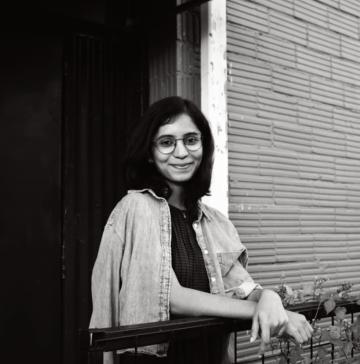
ATCHAYAA KRISHNAN
THE UNIVERSITY OF TEXAS AT AUSTIN
Atchayaa Krishnan is a General Physician, Designer, and Illustrator. She is originally from India and is currently pursuing her Master's degree in M.A. in Design focused on Health.
Her strong passion for Design and pioneering spirit led her to explore beyond the medical bubble, and she is now determined to work at the intersection of Design and healthcare.
As a young healthcare provider in India, She had the opportunity to work above and beyond the call of duty, which has given her a unique perspective on the challenges and complexities that the healthcare system faces in delivering quality and equitable care.
She says certain factors are beyond the hands of a physician in addressing these challenges, but by looking through the lens of a designer, we can resolve them. As a young designer from a medical background, she is committed to reframing the future of healthcare by driving innovative and responsible changes through Human-centered Design.
WHAT MAKES YOU FEEL INSPIRED?
I find great inspiration in observing people and things around me, which helps me design with purpose.
WHAT AREA OF DESIGN ARE YOU HOPING TO WORK IN OR SPECIALIZE IN?
As someone with a deep passion for both design and healthcare, I am driven to explore the intersection of these two fields and develop impactful solutions and services that facilitate the delivery of quality and equitable healthcare.
WHAT IS ONE THING THAT DESIGN SCHOOL HAS TAUGHT YOU THAT YOU DID NOT EXPECT?
Design can effortlessly shape human behavior and interactions with the world around us.
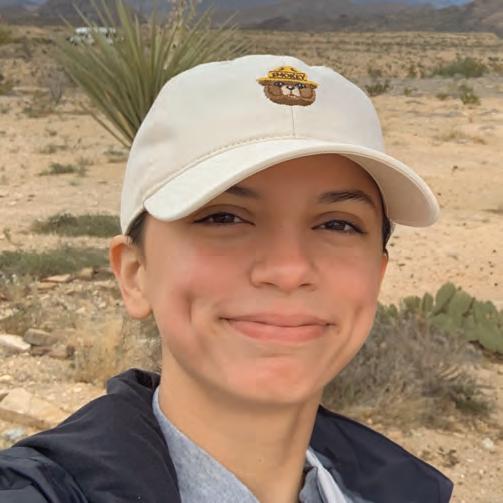
GABRIELA RIVERA
THE UNIVERSITY OF TEXAS AT AUSTIN
I am a senior pursuing a BFA in Design with a focus in printmaking. I work for a San Antonio, Texas based sausage company as a full-time graphic designer and it is as funny/fun as it sounds. I changed my major 5 times and eventually dropped out before I finally realized what I wanted to do. I took a few community college courses in “Communication Design”, learned the basics of Photoshop and Illustrator and I was HOOKED!
But, It wasn’t until I came to UT Austin that I was exposed to the world of printmaking, something I had never had the opportunity to explore before. I started to realize how much of my designs stay in the digital world.
Now, my main goal as a designer is to encourage others to continue to bridge the gap between “old” and “new” by showcasing the possibilities. Like taking a poster design that sat in a digital folder for 2 years and bringing it to life by means of screen printing!
In my free time I love hiking with my partner, going to museums with my siblings, and experimenting in the UT Design print shop.
WHAT ARE YOU READING/LISTENING TO/WATCHING?
I currently have King of the Hill, Abbott Elementary, or the Office on repeat while I work on projects (comfort shows). I listen to KUTX radio and mix it up with a bit of Black Sabbath, Megan Thee Stallion, George Strait or the Hidden Brain podcast.
WHO IS SOMEONE YOU LOOK UP TO IN YOUR FIELD?
In the letterpress world, I admire Dafi Küne. He is a Swiss designer/letterpress printer who loves to experiment with analog and digital techniques to produce incredible posters! I also admire the poster work of Vance Kelly and Dave Kloc, the printmaking of Eva Stalinski, and of course the designs/entrepreneurial spirit/mentor mentality of Aaron Draplin.
80 GDUSA 2024 | STUDENTS TO WATCH
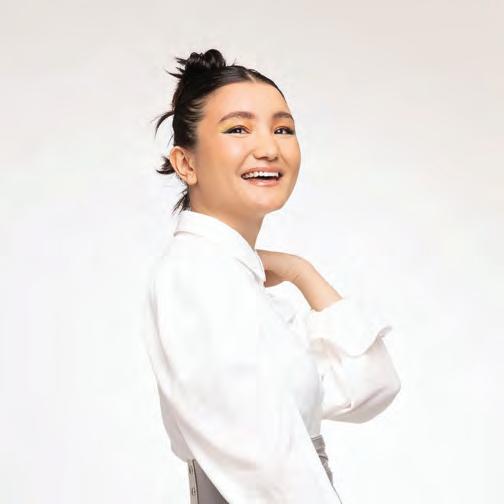
SANDRA LEE
RINGLING COLLEGE OF ART AND DESIGN
Sandra Lee is a multidisciplinary artist and designer majoring in Graphic Design and minoring in Creative Writing and Art History. Originally from Tennessee, she grew up surrounded by diverse cultures which inspired her interest in creative storytelling. Since her first year, Lee has been actively involved in her community, namely volunteering with local environmental nonprofits to amplify their voices, teaching art to K-12 students, and leading cultural and sustainability-focused organizations on-campus. She recently wrapped up a creative marketing internship at Workiva, a SaaS financial reporting company focused on ESG (environmental, social, and governance) solutions. Lee is passionate about integrating her interests in fine arts and worldbuilding into her work to design innovative solutions for social justice and climate change.
WHAT MAKES YOU FEEL INSPIRED?
I’m inspired by the resilience of the world and the human spirit—nature, peers, mentors, movements, music, art, culture, and more.
WHAT AREA OF DESIGN ARE YOU HOPING TO WORK IN OR SPECIALIZE IN?
It’s so hard to choose since I love so many aspects of design, but I’m especially keen on product, brand, packaging, UI/UX, environmental, and exhibition design.
WHAT IS ONE THING THAT DESIGN SCHOOL HAS TAUGHT YOU THAT YOU DID NOT EXPECT?
That being a designer isn’t just about designing—the very nature of the job is about being adaptive and multidisciplinary. You’re also presenting, collaborating, critiquing, writing, and most importantly, selling your ideas as a persuasive problem-solver.
WHO IS SOMEONE YOU LOOK UP TO IN YOUR FIELD? EITHER TODAY OR HISTORICALLY?
Mike Monteiro; his work about design ethics is something every designer should read. (A good start is his article “A Designer’s Code of Ethics.”)

TAKO PHARSENADZE
RINGLING COLLEGE OF ART AND DESIGN
Tako Pharsenadze is a senior from Batumi, Republic of Georgia, currently majoring in Graphic Design and minoring in Fine Arts and Business of Art and Design. Ever since she was little, she has been practicing creative expression. Her first memories include creating nonsensical shapes on papers, walls, or furniture. This innate passion for creation led her to pursue an art career; although requiring a long journey involving various art practices and explorations of diverse mediums, before ultimately discovering her niche. In her design practice, she loves to leverage different research methods to validate creative solutions and produce designs that consider the brand as a whole. Being a traditional artist before discovering graphic design, she used to be overwhelmed by the grid systems and typography that ironically have become her favorite things. If she’s not designing, she’s probably reading, cooking, watching a movie, or practicing the saxophone.
WHAT ARE YOU READING, LISTENING TO, WATCHING (BOOKS, MOVIES, TV, SOCIAL MEDIA, MUSIC)?
I am currently listening to Aphex Twin, Radiohead, King Krule, and PJ Harvey since they all go well with the book I’m reading, which is Demian by Hermann Hesse.
DO YOU CURRENTLY, OR DO YOU PLAN TO, DESIGN FOR ANY CAUSES OR CHARITIES?
I’ve been interested in learning more about sustainable design practices. As a graphic designer, it is often difficult to get away from unsustainable production methods. I want to design with sustainability in mind and possibly create educational resources, campaigns, and environmentally-conscious designs for other artists.
DO YOU FEEL THAT DESIGN SCHOOL HAS PREPARED YOU TO SEARCH FOR AND FIND A JOB?
Absolutely. I am forever grateful to Ringling College, which not only provided me with incredible knowledge and skills to succeed in the industry, but also allowed me to create lifelong bonds with talented students, mentors, and faculty.
GDUSA 81

KEATON
DILLARD
UNIVERSITY OF NORTH TEXAS
Keaton Dillard is a designer, brother to six, brother-in-law to two, and uncle to one living in Denton, Texas and studying Communication Design at the University of North Texas as a senior. Growing up primarily in Cappadocia (Kapadokya), Turkey amidst an enchanting landscape, hot-air-balloons, and endless amounts of Turkish tea, he developed a deep love of beauty that found its voice in drawing, painting, and typography. He takes great delight in elegant and detailed design, thick business cards, and small folios. Although he appreciates digital art and illustration, he will always be faithful to anything that finds its final voice in the physical, whether it be posters, publications, menus, or packaging. Find more of his work at keatondillard.com.
WHAT MAKES YOU FEEL INSPIRED?
Seeing beautiful design in film, fashion, architecture, and interior design all inspire me to create more beautiful things.
WHAT AREA OR AREAS OF DESIGN ARE YOU HOPING TO WORK IN OR SPECIALIZE IN?
I love publication and print design most of all so those will definitely be my focus in my career.
WHAT IS ONE THING YOUR TIME IN DESIGN SCHOOL HAS TAUGHT YOU THAT YOU DIDN’T EXPECT?
I was not at all prepared for how important ideation and process was to a final design result when I first started school.
WHO IS SOMEONE YOU LOOK UP TO IN YOUR FIELD?
My number one design hero will always be Charley Harper. His compositions and color combinations are absolutely brilliant. Dana Tanamachi (a UNT alumni) and Louise Fili are also incredible designers I deeply respect.
WHAT ARE YOU READING/LISTENING TO/WATCHING?
Recently I have been reading a lot of CS Lewis and Wendell Berry. Both are wonderful thinkers and have such sharp insights into creativity and observation.

JOHN PAUL NGUYEN UNIVERSITY OF NORTH TEXAS
John Paul Nguyen is a senior at the University of North Texas specializing in Communication Design with a focus on Graphic Design and a minor in Art History. He has a strong interest in branding, art direction, and publication design, with a keen interest in the sports design industry. Post-graduation, John Paul hopes to leverage his skills and passion by joining a sports team or a related company. He has always been a passionate and driven individual, eager to bring his creativity and innovative ideas to the table. Actively seeking opportunities to grow and make a difference in the world of design, he combines technical proficiency with a deep understanding of user-centric design to create captivating visuals that effectively communicate messages and ideas.
WHAT MAKES YOU FEEL INSPIRED?
What makes me feel inspired is the ability to create unique and meaningful designs that evoke emotion and convey a message. This inspiration drives me to wake up each day and do what I love, infusing passion into my work with every creative endeavor.
WHAT AREA OR AREAS OF DESIGN ARE YOU HOPING TO WORK IN OR SPECIALIZE IN?
I have a strong interest in branding, art direction, and publication design with a focus in the sports design industry.
DO YOU, OR DO YOU PLAN TO, DESIGN FOR ANY CAUSES OR CHARITIES, I.E., DESIGN FOR GOOD?
In the future, I aim to design for non-profits that align with causes I value such as mental health, education, and the environment. I plan to integrate this commitment into my career through freelance projects, contributing my skills to make a positive impact.
DO YOU FEEL THAT DESIGN SCHOOL HAS PREPARED YOU TO SEARCH FOR AND FIND A JOB?
Yes, I've not only acquired the fundamental skills of graphic design principles but have also refined my abilities through the application of design thinking and design process which seamlessly translates into real-world projects.
83 GDUSA 2024 | STUDENTS TO WATCH
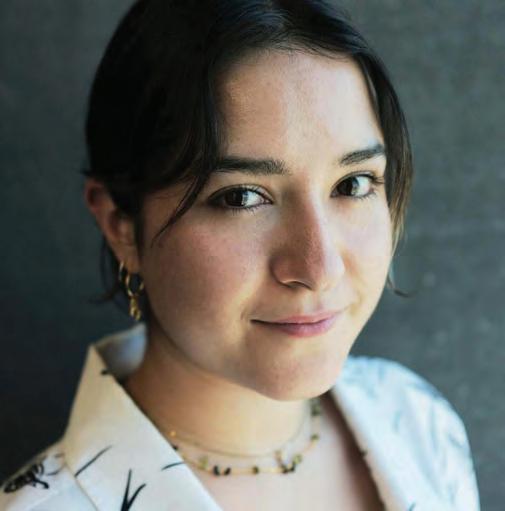
SOFIA MERINO ARZOZ
SCHOOL OF THE ART INSTITUTE OF CHICAGO (SAIC)
Sofia Merino Arzoz is a designer pursuing a bachelor of fine arts at the School of the Art Institute of Chicago (SAIC) with a focus in Visual Communication Design. She has studied in the US, Mexico, and Italy. She currently works at Hyde Park Art Center, a nonprofit hub for contemporary arts in Chicago, where she is in charge of everything from exhibition posters to maps. Sofia is both a Davis United World College Scholar and an SAIC Distinguished Scholar. Additionally, she is the recipient of the Justyna Palka Memorial Scholarship, which awarded her with a design internship at Ogilvy in Chicago in the summer of 2023. Curiosity and creativity drive her practice. Sofia’s design is mostly concerned with the “why” of the projects she takes on, which is why projects with social purposes stand at the core of her artistic pursuit. She enjoys constant reflection, challenging endeavors, and critique. She’s all about the subtle details and expansive research that propose a unique narrative and strong concept. Sofia sees design as a powerful tool to connect communities and ideas in the visual world we live in, and hopes to collaborate with other creative industries to create work that spans all mediums and approaches.
WHAT MAKES YOU FEEL INSPIRED?
Exploring new places, nature, beautiful cities, taking a break! (While saving interesting sights for design reference of course.)
WHAT AREA OR AREAS OF DESIGN ARE YOU HOPING TO WORK IN OR SPECIALIZE IN?
I’m hoping to work on projects that span multiple areas, mediums, and scales, shifting from design and art direction. Currently, I have a strong interest in typography and the film industry.
WHAT IS ONE THING THAT DESIGN SCHOOL HAS TAUGHT YOU THAT YOU DID NOT EXPECT?
The excitement of finding a design solution that makes you feel like you cracked the code.
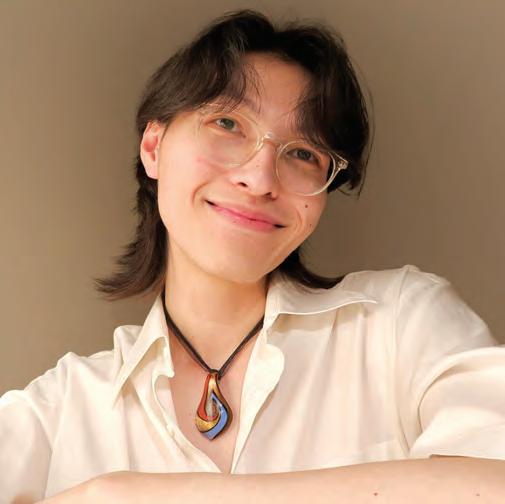
JACK (QUYEN) HOAC SCHOOL OF THE ART INSTITUTE OF CHICAGO (SAIC)
Jack (Quyen) Hoac is a graphic designer and interdisciplinary artist based in Chicago with a bachelor of fine arts from School of the Art Institute of Chicago (SAIC). He is currently in a love triangle with brand identity and digital illustration. His work explores the bridge between graphic design and fine arts. He loves putting himself in the shoes of a painter when it comes to experimenting with type and pushing the limits of typography. When Jack is not designing, he’s probably at a local thrift store, planning his outfits for the following week.
WHAT MAKES YOU FEEL INSPIRED?
Strangely, I feel most inspired by chaos and unexpected situations, as they challenge me to adapt and take on new uncomfortable perspectives. If plans can provide comfort, navigating through uncertainty can spark unique ideas and help produce innovative work.
WHAT IS ONE THING THAT DESIGN SCHOOL HAS TAUGHT YOU THAT YOU DID NOT EXPECT?
I was not a fan of teamwork myself, but the inherently collaborative environment at design/art school taught me to appreciate the value of having diverse perspectives in the creative process. Working with friends from many different backgrounds, I learned that the synergy of different voices and skills creates so much more impactful and better design solutions.
WHAT ARE YOU READING/LISTENING TO/ WATCHING?
Recently, I often put on a random episode from Underscore, a design podcast by The Chicago Graphic Design Club, on my morning commute. As a design student in Chicago, I’m super interested in learning more about the community of creatives in the city (and infiltrating myself into one). There’s something very charming about the way designers always look out for one another and never gatekeep in Chicago, and this podcast always strives to cultivate that.
GDUSA 83
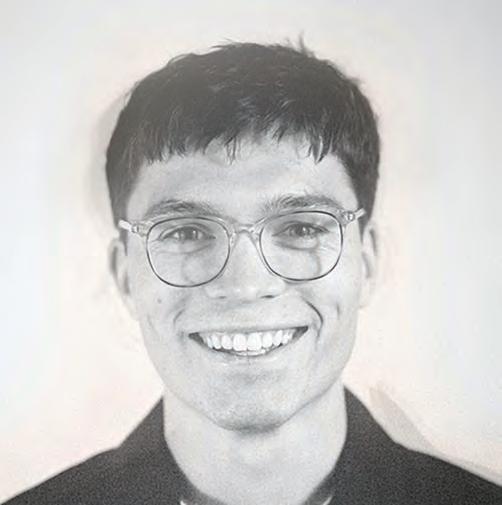
SPENCER ROBERTS
UNIVERSITY OF CINCINNATI
I’m Spencer Roberts, a no-BS designer pursuing a B.S. in Communication Design at the University of Cincinnati — in the city where I’ve studied, worked, eaten, and scratched my design itch since 2019. I’m passionate about designing brand identities, environmental graphics, and making things move, all with a typographic through-line. What do you need to know about me? I have a love for letters and doing weird things with words, I’m the basic kind of colorblind, and I’m serious about joking.
WHAT MAKES YOU FEEL INSPIRED?
I seek inspiration in observation, often borrowing from the forms, textures, and colors of historic Cincinnati.
WHAT AREA OR AREAS OF DESIGN ARE YOU HOPING TO WORK IN OR SPECIALIZE IN?
My work is governed by a need for narrative. An ideal focus would be in branding and strategy — allowing me to explore identity design through research and copywriting, custom lettering and typography where appropriate, and a mixed bag of print and environmental applications.
WHAT IS ONE THING THAT DESIGN SCHOOL HAS TAUGHT YOU THAT YOU DID NOT EXPECT?
Design school taught me that good design is not created in a bubble, to surround myself with good company, and that I can always rely on the opinions of my peers.
WHO IS SOMEONE YOU LOOK UP TO IN YOUR FIELD? EITHER TODAY OR HISTORICALLY?
Working alongside my professor, Reneé Seward, in the UC Digital Futures Learning by Design Lab, we’re on a mission to create literacy typefaces that empower young students struggling to read through the power of type design and emerging technology.
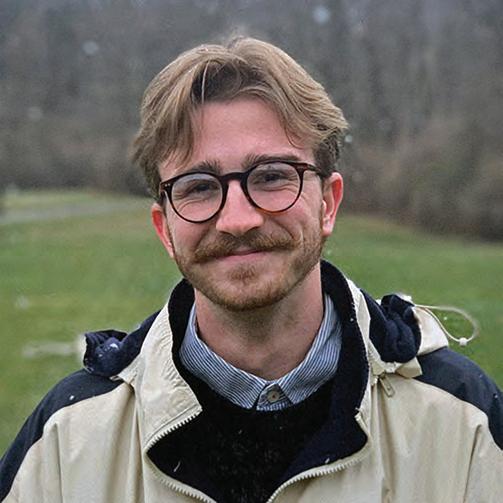
JOEY WOOD UNIVERSITY OF CINCINNATI
My name is Joey Wood, a student pursuing Communication Design at the College of Design, Architecture, Art, and Planning. My roots are based in Cincinnati, Ohio, a city to which I owe my passion. I was born here because of my grandpa’s cross-country pursuit of graphic design in the late 1960s. I have a deep and unwavering love for graphic design—a true source of joy in the endless experience of visual storytelling and creative expression. I believe that thoughtful attention, beauty, and life should be infused into everything we interact with. My lesser, but still cherished, passions include creating motion collages, running in the cold, and exploring the history of Cincinnati.
WHAT MAKES YOU FEEL INSPIRED?
I feel the most inspired as the seasons change, by fresh music, movies, and design elements that come into my days.
WHAT AREA OR AREAS OF DESIGN ARE YOU HOPING TO WORK IN OR SPECIALIZE IN?
Brand identity, packaging, or truly anything under the umbrella of visual storytelling!
WHAT IS ONE THING THAT DESIGN SCHOOL HAS TAUGHT YOU THAT YOU DID NOT EXPECT?
I was surprised by the many unexpected mediums that have great transferable knowledge to the world of design principles.
WHO IS SOMEONE YOU LOOK UP TO IN YOUR FIELD? EITHER TODAY OR HISTORICALLY?
I’m always in awe of the works by Mike McQuade.
WHAT ARE YOU READING, LISTENING TO, WATCHING (BOOKS, MOVIES, TV, SOCIAL MEDIA, MUSIC)?
Re-entered a folk phase! I’ve been loving movies from the Coen brothers and music from CW Stoneking, Blind Willie McTell, and Gregory Alan Isakov.
84 GDUSA 2024 | STUDENTS TO WATCH
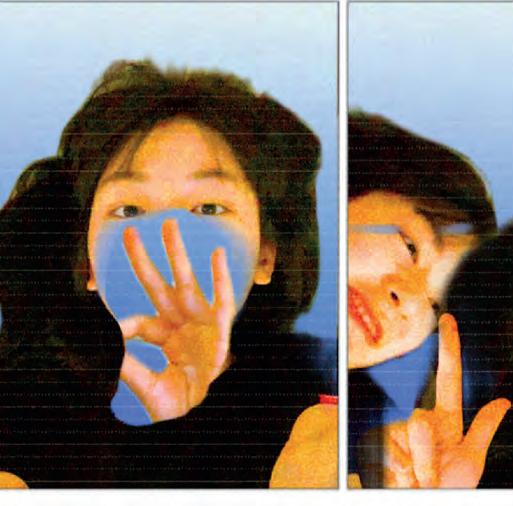
MAO LI
CALIFORNIA COLLEGE OF THE ARTS (CCA)
Mao is getting very close to having her bachelor’s degree in Graphic Design, a goal she set as she transferred to CCA in San Francisco from a Chinese university. She admires good wine packaging and commercial ads made by great illustrators, while also pursuing a minor in Computational Practices so that she won’t be swallowed by the technology that plays a role in shaping her life.
WHAT MAKES YOU FEEL INSPIRED?
I take inspiration from social media, and I appreciate posts that make art approachable. I also like to randomly click on tools in design software and mess around.
WHAT AREA OR AREAS OF DESIGN ARE YOU HOPING TO WORK IN OR SPECIALIZE IN?
I’ve always wanted to master ceramics so that I could pursue perfect symmetry even off-screen. And I’d love to work in tailoring someday and revive as many secondhand clothes as possible.
WHAT IS ONE THING THAT DESIGN SCHOOL HAS TAUGHT YOU THAT YOU DID NOT EXPECT?
I didn’t know I could get along with programming until I finished my very first personal website. I was reluctant to take an interactive design class at first, because it appeared to be about all the things that are on the opposite side of what I’m good at. However, I am glad I learned about computational thinking, algorithms, and basic coding skills from the course.
WHO IS SOMEONE YOU LOOK UP TO IN YOUR FIELD? EITHER TODAY OR HISTORICALLY?
Can Yang, she makes graphic design I’ve never seen before.
WHAT ARE YOU READING, LISTENING TO, WATCHING (BOOKS, MOVIES, TV, SOCIAL MEDIA, MUSIC)?
I’ve been listening to this podcast called “Eat Your Crust” to overcome cultural shock and my anxiety about English small talk.
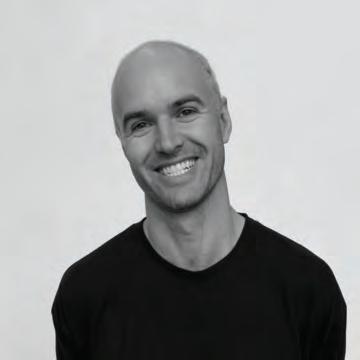
COLE RYDER
CALIFORNIA COLLEGE OF THE ARTS (CCA)
Cole Ryder was born in Ojai, California and is currently based in San Francisco, California where he is completing his final year of the Masters of Fine Arts Design program at California College of the Arts. He completed his BFA at UCLA and retains a strong connection to the music industry in Los Angeles where he has produced album and tour artwork for artists like Mareux (Warner Records) and Thundercat (Brainfeeder) amongst others. His academic work explores the exchange between subjective experience and objective reality and he is deeply interested in how we collectively determine truth. He is concerned about the visual homogenization of the world and appreciates design work that integrates specificity of place. Cole is interested in contributing to a stranger and kinder future.
WHAT MAKES YOU FEEL INSPIRED?
Long meandering walks, youth culture, friends, international travel, time spent in nature.
DO YOU, OR DO YOU PLAN TO, DESIGN FOR ANY CAUSES OR CHARITIES, I.E., DESIGN FOR GOOD?
Yes. It’s very important to me to produce some design directly for the community that I exist in, be that pro-bono work for a non-profit or really reduced rates for local small businesses. Getting to design for a living is a gift and it has allowed me to make some really lasting connections with great people and businesses here in San Francisco.
DO YOU FEEL THAT DESIGN SCHOOL HAS PREPARED YOU TO SEARCH FOR AND FIND A JOB?
I think that MFA and BFA programs are really different and it’s essential for prospective students to understand that. My MFA experience has been absolutely fantastic and I’ve expanded as a designer and artist in a million directions and have had great mentorship from people I really really respect. That being said, I think MFA programs sort of prepare you for your third or fourth job out of design school and not your first. Because our work is so conceptual we often don’t graduate with the sort of vocational school portfolio that many BFA programs guide students towards.
GDUSA 85
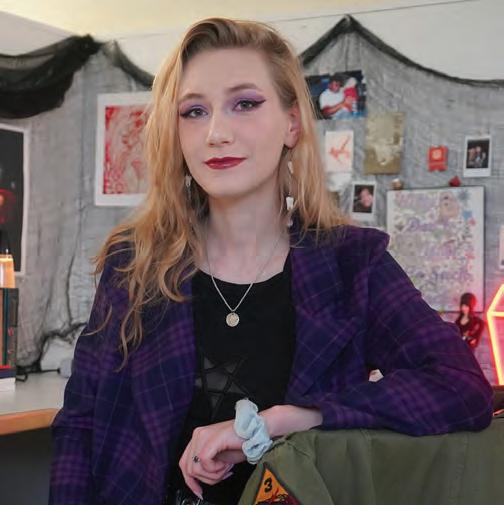
CLEO KENDRICK
PENNSYLVANIA COLLEGE OF ART AND DESIGN (PCA&D)
I’m a senior graphic design student with a minor in business in the creative industry. I grew up on a dairy farm in rural western New York, and was the token “art kid” throughout my childhood. I became interested in graphic design as a career in middle school after my Granny Shanny got me the opportunity to shadow the design department at CMT for a day. I decided to go to an art school so I could be surrounded by fellow creatives and get out of my comfort zone. These past four years I’ve gained a greater confidence in my own abilities as a designer. I was part of PCA&D's winning team for the 2022 America250PA’s statewide marketing competition. I’m an officer for our campus AIGA club, and I do my best to take an active role in our campus community. In college one thing I really loved learning about and working with is typography. I’ve always been fascinated with letters and how they can be depicted. Outside of classes, designing, and my part-time job, I spend my time being furniture for my cat Diva, hanging with friends, or going on adventures with my fiancé.
WHAT MAKES YOU FEEL INSPIRED?
I’m inspired by everything around me; design is everywhere you look. I love to look at how design has evolved over the years and often take inspiration from past design trends.
WHAT AREA OR AREAS OF DESIGN ARE YOU HOPING TO WORK IN OR SPECIALIZE IN?
Whenever I’m asked what I want to do in the design field, I always say entertainment media, print, or digital. I’m a go-with-the-flow kind of gal, so I really don’t mind where I end up, as long as it’s design-related.
WHAT IS ONE THING THAT DESIGN SCHOOL HAS TAUGHT YOU THAT YOU DID NOT EXPECT?
That the Adobe Creative Suite is not as scary as I thought it would be.

AUSTIN TAYLOR PENNSYLVANIA COLLEGE OF ART AND DESIGN (PCA&D)
I am a senior at PCA&D studying to be a graphic designer. Over the past three years, I realized that I enjoy graphic design more than I thought I would. Before going to college I didn't know what I was going to do; all I knew was that I liked creating stuff. So I took a shot in the dark and went to school for graphic design and I've been enjoying it ever since. I was part of PCA&D's 2022 winning team for America250PA’s statewide marketing competition. I am a big fan of the automotive industry so when I have the chance to design something related to that, it's always a fun time. As a designer, I want to push myself to be the best version I can be by taking on unique challenges and seeing how far I can go.
WHO IS SOMEONE YOU LOOK UP TO IN YOUR FIELD? EITHER TODAY OR HISTORICALLY?
The person that I look up to would have to be my design teacher from high school, Mr. Lewis. He was the one who showed me what the design world was and that I could make a living from it.
DO YOU CURRENTLY, OR DO YOU PLAN TO, DESIGN FOR ANY CAUSES OR CHARITIES?
As part of the college’s in-house design team, The Agency, I’ve created the branding for several area non-profits. I also participated on Designathon teams for two years, creating one-day branding work for nonprofit organizations.
DO YOU FEEL THAT DESIGN SCHOOL HAS PREPARED YOU TO SEARCH FOR AND FIND A JOB?
Yes, I feel that design school helped me prepare for finding jobs. One way is through my work with The Agency, where I took on a leadership role as the Creative Director, learning how to manage the workflow for several projects and supervise and assign work. As The Agency’s first student leader, I also created a Guidebook to help those who take on this role after me.
86 GDUSA 2024 | STUDENTS TO WATCH
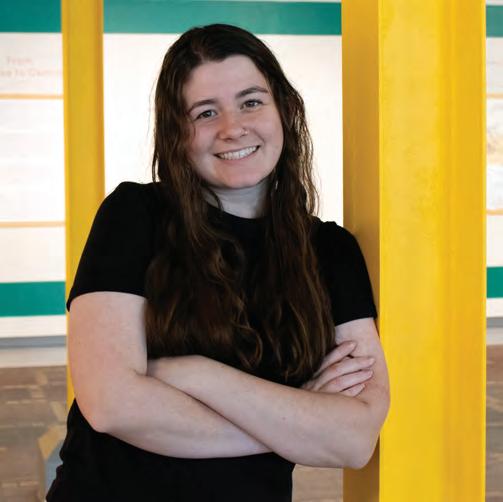
ASHLEY CURTIS MERCER UNIVERISTY
Ashley Curtis is a senior graphic design major at Mercer University in Macon, GA. Ashley’s love of art started at a young age. She particularly enjoyed drawing, and in high school she began learning graphic design. In addition, Ashley also learned about environmental science, and protecting the environment soon became something she cared deeply about. Ashley is passionate about sustainability and reflects that in the work she creates. She excels in packaging design, editorial design, and illustration. She enjoys working in a wide variety of styles and tailoring her style to the messages her designs communicate. Ashley currently designs posters and promotional content for Mercer’s art gallery, the McEachern Art Center.
WHAT MAKES YOU FEEL INSPIRED?
I find inspiration by exploring new places and getting out of my comfort zone. I strive to make designs that leave a lasting impression on people, so I am always looking for interesting designs to draw inspiration from.
WHAT AREA OR AREAS OF DESIGN ARE YOU HOPING TO WORK IN OR SPECIALIZE IN?
I hope to continue to create branding and promotional content for museums and art galleries. I also love packaging design and would consider that as a career as well.
WHAT IS ONE THING THAT DESIGN SCHOOL HAS TAUGHT YOU THAT YOU DID NOT EXPECT?
A lot of the design process happens on paper before it ever makes it to the computer.
DO YOU CURRENTLY, OR DO YOU PLAN TO, DESIGN FOR ANY CAUSES OR CHARITIES?
I plan to design for my local chapter of the Georgia Native Plant Society to encourage people to plant native.
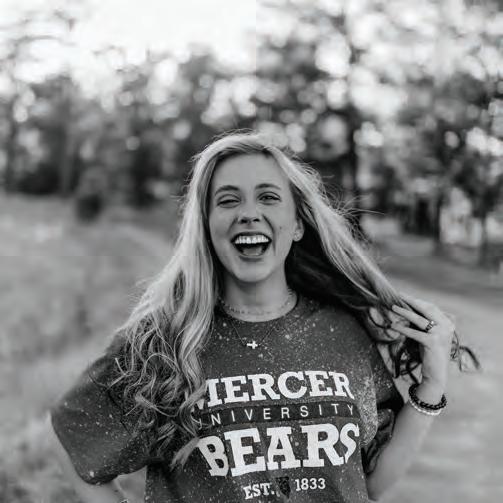
HELEN O’DELL MERCER UNIVERSITY
Helen is receiving her Bachelor of Arts in Graphic Design. Born, raised, and educated in Macon, GA, her designs are driven by community. She strives to connect people through the commonality of design. Macon is a community rooted in history, which was brought to the forefront in recent revitalization efforts. This developed Helen’s love of connecting past and present in her designs. Her love of nostalgia and childhood is a large influence, extending even to her travels. From short trips throughout the United States to international journeys, she is drawn to the various ways community and history are physically seen.
Helen’s professional work is focused on branding and marketing for local companies. She strives to show the nature and history of a brand to build its consumer base and community. Besides her work for non-profits and corporations, Helen enjoys creating pieces for individuals. This aspect of her work focuses on reinvigorating connections between people on a small scale.
WHAT MAKES YOU FEEL INSPIRED?
I am inspired by my environment, using influences from nature, architecture, people, and history that surround those I design for.
WHO IS SOMEONE YOU LOOK UP TO IN YOUR FIELD? EITHER TODAY OR HISTORICALLY?
I am currently fawning over Shana Marie Kubilius Wanco and her work as a stationer.
WHAT ARE YOU READING, LISTENING TO, WATCHING (BOOKS, MOVIES, TV, SOCIAL MEDIA, MUSIC)?
The Head and The Heart and Gregory Alan Isakov are necessary additions to any of my playlists, especially when it comes to music while I’m designing.
GDUSA 87
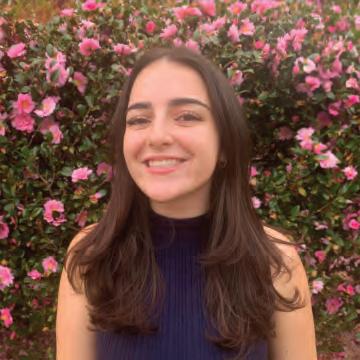
LAUREN BISTRITZ
AUBURN UNIVERSITY
Lauren Bistritz — originally from Birmingham, AL — graduated with a BFA in Graphic Design from Auburn University in December 2023. During her time at Auburn, Lauren was president of Humans of Auburn and ran a weekly design podcast that aired on WEGL 91.1 FM. She worked for Auburn University’s Student Involvement, designing deliverables for campus traditions like Hey Day. Lauren’s work has been featured in Auburn’s Graphic Design Student Juried show and Auburn’s literary art magazine, The Circle. She has been named on the Dean’s list for 7 semesters. Her portfolio can be found at www.laurenbistritz.com. When she isn’t designing, she enjoys thrifting, going to art museums, or playing with her cat.
WHAT MAKES YOU FEEL INSPIRED?
Traveling, thrifting, creating (even if it isn’t good), and admiring any coffee table book I can.
WHAT AREA OR AREAS OF DESIGN ARE YOU HOPING TO WORK IN OR SPECIALIZE IN?
Publication or packaging.
WHAT IS ONE THING THAT DESIGN SCHOOL HAS TAUGHT YOU THAT YOU DID NOT EXPECT?
The importance of working with a group in terms of getting feedback and improving your own designs.
WHO IS SOMEONE YOU LOOK UP TO IN YOUR FIELD?
EITHER TODAY OR HISTORICALLY?
Saul Bass, Malika Favre, and professors I’ve had in school like Courtney Windham and Mario Bocanegra Martinez.
DO YOU CURRENTLY, OR DO YOU PLAN TO, DESIGN FOR ANY CAUSES OR CHARITIES?
I have been very involved with the Crohn’s and Colitis Foundation through my personal life, have designed for them before and plan on designing more for them soon!

BRIELLE STEIN AUBURN UNIVERSITY
Brielle Stein is a multi-disciplinary designer, artist, writer, curator, and student. She is eagerly passionate about typography and the grand power it has to connect people. She is a curious learner and recently wrapped up a BFA in Graphic Design from Auburn University. She also studied classical art techniques at the Florence University of the Arts in Italy while working as a curator in a local gallery. She is captivated by publication design, typography, animation, illustration, exhibition design, fine arts, art history, and writing. She recently completed a body of work for a solo art exhibition and is excited for future opportunities in these fields.
WHAT MAKES YOU FEEL INSPIRED?
I feel deeply inspired by systems and handmade/natural forms in tandem. I find this a lot in urban architecture and construction as I see buildings and grid systems worn in by human use and desire. I also love the relationship between beauty and function in typography. Typography has an undeniable power to connect us and convey stories. I think the beauty of typographic anatomy and the diversity of forms as they connect to practical utility inspires me.
WHAT IS ONE THING THAT DESIGN SCHOOL HAS TAUGHT YOU THAT YOU DID NOT EXPECT?
Design school taught me that at the end of the day, you are the designer. You are the one with the concept and the skills to execute. If you have a vision and believe in it, push for it, research it, and prove why it works. Looking to others for their approval rather than their constructive critique will not get you as far as you’d hope.
WHAT ARE YOU READING/LISTENING TO/WATCHING?
I am currently reading “Circe” by Madeline Miller – the Iliad from the perspective of the Circe - the woman villain of the story. I’m listening to a lot of The Smiths lately, and watching Abstract – The Art of Design and, less seriously, Ted Lasso.
DO YOU CURRENTLY, OR DO YOU PLAN TO, DESIGN FOR ANY CAUSES OR CHARITIES?
I hope to do work with art galleries in the future that offer platforms to historically underrepresented groups in the art world. An organization I admire greatly is Women and Their Work based in Austin TX.
88 GDUSA 2024 | STUDENTS TO WATCH

MIRIAM DEEB
MICHIGAN STATE UNIVERSITY
Miriam Deeb is a senior pursuing a BFA in Graphic Design with a minor in Animation and Comics Storytelling. Miriam’s earliest hobby was drawing, taking trips to the library in order to check out illustration books to practice with. As she’s aged, her artistic interest has expanded to many other mediums, such as painting, sculpting, and crocheting. After learning art fundamentals from these studio art explorations, Miriam became fascinated with applying these concepts to digital art and graphic design. Through personal projects and design jobs, she is constantly learning how to develop her work as a designer. Currently, Miriam works as the Director of Creative Services for the Residence Halls Association, and held a summer internship position for Know Advertising. She is passionate about creating unique, intentional design, with a love for illustration and interesting fonts.
WHAT MAKES YOU FEEL INSPIRED?
As an artistic person, I feel a need to surround myself with creative materials at all times. From clothing, to music, to room decorations; it’s important to me to put a form of personal expression in everything I do. In turn, I stay inspired by my curated environment as well as anything that catches my eye outside of it. I enjoy looking at old books and records at thrift stores or packaging in grocery aisles, anything with unique design to spark my imagination.
WHAT AREA OR SPECIALTY ARE YOU HOPING TO WORK IN?
I love design within the music industry, because of how fun and creative it can be. I design the marketing and merchandise for the MSU Spring concert, and enjoy the process of applying the sound of an artist into visual material. I would also enjoy work in publication or illustration as well.
DO YOU DESIGN FOR ANY CAUSES OR CHARITIES?
Within my internship this past summer, I designed a full social and marketing campaign for an environmental non profit, as well as branding for a fundraising charity event.

MELISSA UTYKANSKI
MICHIGAN STATE UNIVERSITY
I’m Melissa Utykanski, a senior pursuing a BFA in Graphic Design, graduating in the Spring of 2024. Since I was very young, I’ve had a passion for the arts. I was a competitive dancer for over 12 years and continued dancing in college on the MSU Dance Team for three years. Alongside that, I always enjoyed making things with my hands. High school was where I really dove into drawing, painting, clay, and mediums alike. With the support of my family, friends, and teachers, it was then that I realized I could make my passion for creativity the center of my career. Entering MSU I knew very little about graphic design, but I quickly fell in love with it and I am very excited to continue contributing my work to the design community.
WHO IS SOMEONE YOU LOOK UP TO IN YOUR FIELD? EITHER TODAY OR HISTORICALLY?
Aside from my professors and peers, I often find myself visiting Kelli Anderson’s work. I love how she uses both physical and digital processes to make her unique work.
WHAT ARE YOU READING, LISTENING TO, WATCHING (BOOKS, MOVIES, TV, SOCIAL MEDIA, MUSIC)?
I just finished reading Then She Was Gone by Lisa Jewell and am currently watching Chambers, a short television series. I also enjoy listening to the podcast “Graphic Design Is Fun.”
DO YOU CURRENTLY, OR DO YOU PLAN TO, DESIGN FOR ANY CAUSES OR CHARITIES?
I do not currently design for any causes or charities, but the thought to do so has crossed my mind a lot more recently in my Arts and Cultural Management class, where we look at everything about non-profit organizations and what it takes to run or be involved with them.
DO YOU FEEL THAT DESIGN SCHOOL HAS PREPARED YOU TO SEARCH FOR AND FIND A JOB?
Design school has prepared me with the skills and confidence to enter the workforce. It really is what you make of it, and I feel proud of the portfolio pieces I have accumulated over the last four years and am eager to figure out where I will land professionally.
GDUSA 89

ANGEL CANCHARI
FASHION INSTITUTE OF TECHNOLOGY (FIT)
Angel Joan Melgar Canchari is a Peruvian non-binary graphic designer. They like for their work to be an encapsulation of their person, determination and care to detail. They currently freelance. They don’t like to talk in third person. Set to graduate 2024 with a Graphic Design BFA. angelcmelgarc.com
WHAT MAKES YOU FEEL INSPIRED?
Definitely cyberpunk, mecha and maximalism. I love books that collect works of fantasy artists or punk flyers. Being surrounded by fellow designers whose qualities and forms of decision-making I can’t replicate but admire. I take it as healthy competition to be “the best”. This is an illusion, but it makes me evolve. Also knowing that I am doing all this to move up and provide more for myself and my partner.
WHAT AREA OR AREAS OF DESIGN ARE YOU HOPING TO WORK IN OR SPECIALIZE IN?
I’ve always loved punk music and, in fact, my pull into graphic design was wanting to design posters, albums and be involved in the music scene. I want to specialize in print and web; my intent behind web design is that it needs more disruption and individuality. Rethink how a website should look, like, don't be lazy.
WHAT IS ONE THING YOUR TIME IN DESIGN SCHOOL HAS TAUGHT YOU THAT YOU DIDN’T EXPECT?
Nothing will break me, there’s always an after. By that I do not mean to relax, but to not amputate creativity based on time constraints or what you don’t know now; to push as much as humanly possible.
WHO IS SOMEONE YOU LOOK UP TO IN YOUR FIELD?
EITHER TODAY OR HISTORICALLY?
Graphic designers: James Rönkkö, Robin Roche and Bráulio Amado.
DO YOU FEEL THAT DESIGN SCHOOL HAS PREPARED YOU TO SEARCH FOR AND FIND A JOB?
It has given new connections, built my confidence and anticipation to use my skill, and to understand my physical limits. I don’t just want a job but a legacy.

LIAM MCKINLEY
FASHION INSTITUTE OF TECHNOLOGY (FIT)
Liam is a young graphic designer based in New York NY. His work is distinct in conceptual viability, soft-spoken dignity, and typographic sensibility. Outside of design, Liam cooks personally and professionally. His heart will always rest in the kitchen. The progress and trajectory of his life can be attributed to the endurance of Abuela’s selfless love.
WHAT MAKES YOU FEEL INSPIRED?
Inspiration comes from the feeling of my immediate environment. Our surroundings help to define who we are, so design, being an extension of ourselves, is also a product of our environment. The city is in a constant flux of raw, chaotic life. We may choose to celebrate the continual change with bold rhythms and colors, or we could choose to soothe the overwhelming environment with quiet, minimalism. Either way, the design responds to its surroundings.
WHAT AREA OR AREAS OF DESIGN ARE YOU HOPING TO WORK IN?
Branding. This field is frequently critiqued because of its capital motivations, and I’m honestly a little embarrassed by my answer, however, my love for brandmarks usurps my shame.
WHAT IS ONE THING YOUR TIME IN DESIGN SCHOOL HAS TAUGHT YOU THAT YOU DIDN’T EXPECT?
Design school taught me that there is not a single formula, or template, for Good Design. Every unique problem has an infinite number of valid solutions. A design is Good if it feels right. Only experience, taste, and God-given talent can make a proper determination.
WHO IS SOMEONE YOU LOOK UP TO IN YOUR FIELD?
Paul Rand. He is my superhero. His humility, childlike curiosity, and philosophical view of design continue to amaze me. I also owe a huge thanks to one of Paul Rand’s pupils, Eli Kince, for teaching me how to “see.”
WHAT ARE YOU READING/LISTENING TO/WATCHING?
Currently, I am reading Waiting by Ha Jin; a book about the demands of human longing in contention with centuries of customs. Tao Te Ching and Meditations are a daily reference.
90 GDUSA 2024 | STUDENTS TO WATCH
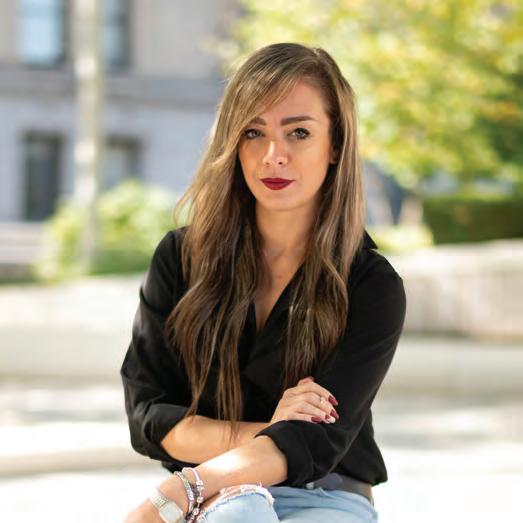
GIADA BARDELLI
BARUCH COLLEGE
Giada Bardelli, aka Giada Joys, is an Italian Graphic Designer based in NYC. Born and raised in the countryside outside Milan, she had years of experience in the fashion industry before deciding to move to New York City and study graphic design. She mastered a Multimedia and Programming Design degree and a Bachelor’s Degree in Business Communication at Baruch College.
Within the short span of one year, not only was she a GDUSA 2022 award winner, but she was also recognized with two awards in the same edition of the GDUSA 2023 competition. Giada possesses effective communication, organizational, and leadership skills. She has a powerful passion for typography and aims to give uniqueness and modernity to her creations consistently. Giada’s vital asset in the creative realm stems from her keen eye for design, complemented by her extensive work experience, making her a valuable addition to any firm. https://giadajoys.com
WHAT MAKES YOU FEEL INSPIRED?
My primary motivation in design comes from my emotions. I draw inspiration for my creativity from various sources such as music, books, posters, and social causes that hold personal significance for me.
WHAT AREA OR AREAS OF DESIGN ARE YOU HOPING TO WORK IN OR SPECIALIZE IN?
I aspire to specialize in graphic design specifically tailored for the fashion industry.
WHAT IS ONE THING THAT DESIGN SCHOOL HAS TAUGHT YOU THAT YOU DID NOT EXPECT?
Designers wield significant influence in advertising, and with this influence comes the responsibility to ensure that our work contributes positively to communities.

TERRY XU BARUCH COLLEGE
Hello! I’m Terry, a Graphic Designer based in New York City. I was born in Manhattan, NY, and raised in Brooklyn and have been interested in art and design since a young age. Being constantly surrounded by animations, cartoons, games, and tech, helped to fuel my creative passion.
I was greatly inspired by the logos of NBA players and eventually fell in love with design in middle school and decided to pursue Graphic Design as a major in college. The endless possibilities of designs can be seen everywhere, especially in New York City.
My hobbies and interests include basketball, mobile gaming, technology, music, animations, fashion, and working out. I love exposing myself to different art and design forms to inspire my work. https://www.terryxu-design.com/
GDUSA 91

DAVID FETHERSTON DREXEL UNIVERSITY
David Fetherston is a senior pursuing a B.S in graphic design and a minor in marketing at Drexel University. He worked as an environmental designer at Exit Design during his Co-Op, and is the Vice President for the Drexel AIGA Student Group. In 2023, David created the brand identity for Drexel Westphal’s showcase at the Design Philadelphia Festival. He appreciates all things branding and enjoys designing systems that test the limits of visual communication. David works with images and typography that push into abstract and illegible territories. He doesn’t believe in reinventing the wheel but just spinning it enough to keep it loose.
WHAT MAKES YOU FEEL INSPIRED?
An idea can hit me anywhere - while people watching, reading and writing poetry, watching films, collecting books, and listening to music.
WHAT AREA OR AREAS OF DESIGN ARE YOU HOPING TO WORK IN OR SPECIALIZE IN?
Brand Identity
WHAT IS ONE THING THAT DESIGN SCHOOL HAS TAUGHT YOU THAT YOU DID NOT EXPECT?
I never thought I would become a storyteller. I used to think graphic design was only about using shapes and forms to create graphics. As I progressed through my coursework I realized that I could use these fundamentals to craft a message for an audience. I use this as inspiration to tell my own stories and bring other people’s stories to life.
WHO IS SOMEONE YOU LOOK UP TO IN YOUR FIELD?
EITHER TODAY OR HISTORICALLY?
Matt Willey
WHAT ARE YOU READING, LISTENING TO, WATCHING?
Watching Peaky Blinders (for the 4th time!) Listening to lots, and lots, of lofi music.
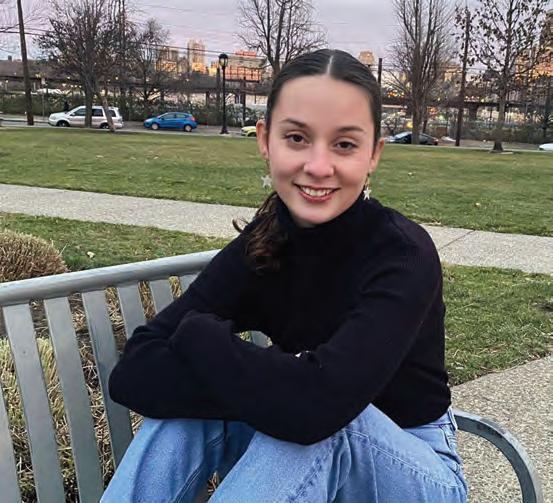
BRIDGET MCLAUGHLIN
DREXEL UNIVERSITY
Bridget McLaughlin is a senior pursuing her B.S. in Graphic Design with a minor in Entrepreneurship and Innovation. She was born, raised, and is living and learning in Philadelphia. Bridget’s early infatuation with drawing the alphabet in many different styles translated directly to her love of typography when she began her coursework at Drexel. She is constantly trying to find the intersection between lived experiences and art to create authentic designs. She loves to integrate personal stories and imagery as well as clever copywriting into her work to create one-of-a-kind, genuine designs that evoke a sense of excitement and belonging. In her free time, Bridget likes to read, play the cello for her school’s chamber strings group, watch movies, bake, write, and go on walks.
WHAT MAKES YOU FEEL INSPIRED?
People-watching is the best way I know to escape artist’s block. As I see the way people interact with one another and the world, all the frustration and silliness and anxiety and love inspire my designs. I attempt to create a feeling of authenticity that connects with many. There’s also nothing that inspires me more than experiencing nature – being down the shore, watching a sunrise, and just being witness to the beauty that surrounds all of us.
WHAT AREA OR AREAS OF DESIGN ARE YOU HOPING TO WORK IN OR SPECIALIZE IN?
I absolutely love designing whole brand identities – figuring out how the logo relates to the typography, how the imagery relates to the copywriting, how it all connects.
WHAT IS ONE THING THAT DESIGN SCHOOL HAS TAUGHT YOU THAT YOU DID NOT EXPECT?
“Comparison is the thief of joy.” –Theodore Roosevelt
WHO IS SOMEONE YOU LOOK UP TO IN YOUR FIELD? EITHER TODAY OR HISTORICALLY?
Michael Bierut brings complete authenticity to his work. His designs are functional, and his writing makes you feel like you know him.
92 GDUSA 2024 | STUDENTS TO WATCH
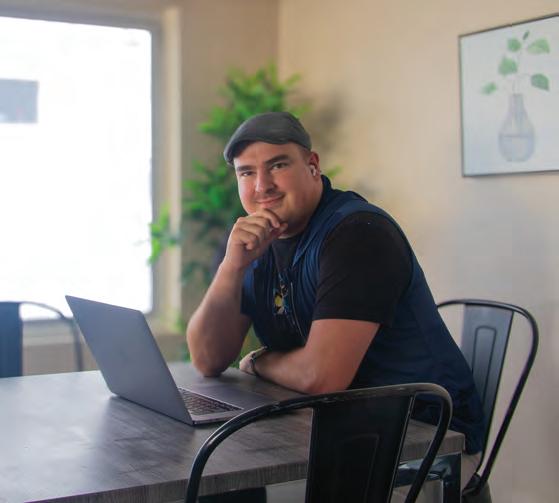
RYAN NEWMAN
WOODBURY UNIVERSITY
Ryan Newman is a 4th year graphic design student at Woodbury University working towards obtaining his BFA in 2024. Since transferring from Santa Barbara City College amid the COVID-19 pandemic he has made it on the university’s dean’s list three times. His love for graphic design blossomed upon discovering his unique creative integrity - wanting to see how to challenge his mindset by channeling his own imagination into his work. Ryan has a firm belief, even with the uprise in AI software, that no machine could replace the amount of love poured into any project by living designers, who are willing to help those who are in need of someone trustworthy to help reach whatever goal they may have, be it a brand or something personal. He would love a career that lends itself to his personable and illustrative design methods, which have grown over the years. Ryan also enjoys gaming with friends and even dabbling into character design and voice acting on the side.
WHAT MAKES YOU FEEL INSPIRED?
The people around me, along with those I’ve met through social networking, have all inspired me through their own creative mindsets. Being an optimistic kind of guy, I also tend to look at the bright side of things, even with any challenges I face along the way.
WHAT AREA OR AREAS OF DESIGN ARE YOU HOPING TO WORK IN OR SPECIALIZE IN?
While I don’t have a certain area of focus at the moment, I do intend to constantly hone my skills by exploring and seeing various aspects of graphic design whenever I can, to help me grow not just as a designer, but as a person.
WHAT IS ONE THING THAT DESIGN SCHOOL HAS TAUGHT YOU THAT YOU DID NOT EXPECT?
Social networking is important, even in the field of graphic design. It allows you to be open to people who follow in the same career path as a designer, and even gives you access to many opportunities, like new clients or even friends in the same field as you.

BRANDON WEBSTER WOODBURY UNIVERSITY
I'm based out of Upland, California and am currently in my senior year of Graphic Design attending Woodbury University. It’s funny, I work as a journalist for Hollywood Weekly – constantly interviewing and writing about other people’s lives but I’m drawing blanks trying to write out mine lol. From a young age my mother taught me to embrace myself as an individual to the fullest extent and I live every day doing just that to make my younger self proud. I bring that up because design has allowed me to view the world with the eyes of a newborn. Discovering the endless amount of art that goes into our everyday lives has been truly humbling to the core. I strive to always learn and grow through every opportunity that finds its way to me, as well as through all the unique souls that I have encountered on this beautiful journey. Not sure if you get the gist of who I am through that lol – but I enjoy producing music, sewing, and social events. Thank You for your time and curiosity.
WHAT MAKES YOU FEEL INSPIRED?
That’s a hard one. Without being cliché and saying “all of life’s moments” – I would say currently, eco futurism has been an obsessive idea that has been cycling through my mind for a while now.
WHAT AREA OR AREAS OF DESIGN ARE YOU HOPING TO WORK IN OR SPECIALIZE IN?
I wish to dive into as many forms of design as possible while I can still have fun with this craft. So, I’ll be seeking to become a creative director with a company that will allow me to do just that. But in terms of specifics – industries like fashion, home decor, entertainment and environmental design have been embedded into my radar.
WHAT IS ONE THING THAT DESIGN SCHOOL HAS TAUGHT YOU THAT YOU DID NOT EXPECT?
Design school has taught me the importance of teamwork. There’s no way I would have gotten through my years in school without having a mental crisis if It wasn’t for the help of my classmates and professors. I’m a freelancer by nature, so learning this key factor in this profession has been extremely crucial and liberating. Designing and learning as a team is a beautiful thing.
GDUSA 93
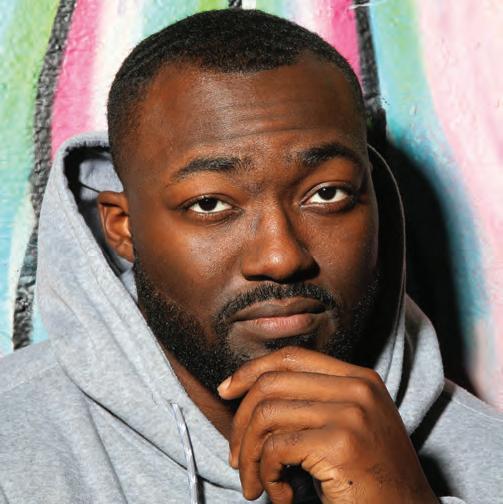
CHARLES JORDAN
KENNESAW STATE UNIVERSITY
As a designer, my inspiration comes from the finer things in life; overpriced everyday luxuries. My work is an effort to make basic items and ideas appear grander and more desirable, similar to what big brand names do with the simplest of products. My more recent projects explore the use of artificial intelligence programs to imitate high end product photography for the purpose of advertising and marketing. I believe that all you need is a bold image, a splash of color, with minimal text, and you can sell anything.
WHAT MAKES YOU FEEL INSPIRED?
Watching people around me grow is one of the greatest experiences I have had as a designer. It inspires me to continue to do better.
WHAT AREA OR AREAS OF DESIGN ARE YOU HOPING TO WORK IN OR SPECIALIZE IN?
I plan to specialize in photography as well as advertising and marketing.
WHAT IS ONE THING THAT DESIGN SCHOOL HAS TAUGHT YOU THAT YOU DID NOT EXPECT?
Design school has taught me the importance of being able to collaborate with others. Different perspectives produces even greater results.
DO YOU CURRENTLY, OR DO YOU PLAN TO, DESIGN FOR ANY CAUSES OR CHARITIES?
I have not planned to design for charities or causes. However, if the opportunity presented itself, I would graciously accept.
DO YOU FEEL THAT DESIGN SCHOOL HAS PREPARED YOU TO SEARCH FOR AND FIND A JOB?
I believe Design School has prepared me for finding jobs, especially when it comes to valuing my own work.
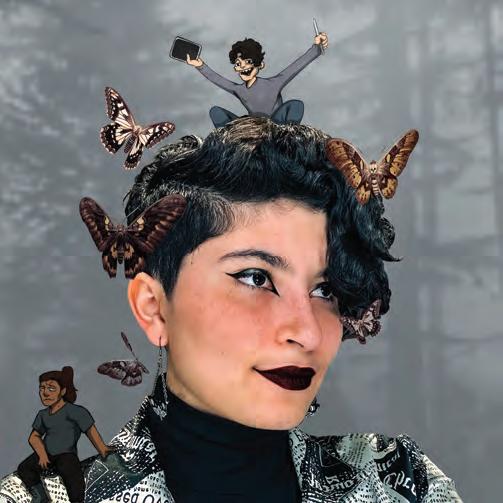
KIANA MELENDEZ
KENNESAW STATE UNIVERSITY
Kiana Melendez is a 22-year-old KSU student born to a Colombian immigrant and a Puerto Rican, whose unique story of hardships and change shaped how she perceives the world and life. Growing up in a house like that meant nights where dinner consisted of Mofongo con un side de arepas and where the language of the house was English, Spanish, and Spanglish. Her journey into graphic design stemmed from a passion for art that didn't align with the traditional paths of most artists. Influenced by her mother's unrealized artistic dreams and her encouragement to venture into the field of art, Kiana became a designer. Growing up in the Southern US and being exposed to the concepts of Southern Gothic, while watching classic horror movies like Halloween (1978) and Friday the 13th, sparked a fascination with a Gothic macabre style that permeates her life, particularly evident in her art and design. The aesthetics of classic horror and the uses of colors, especially red, are something she looks at as inspiration. Now as an adult who is entering the professional world, she is excited to see how her work and style can influence the design world.
WHAT MAKES YOU FEEL INSPIRED?
I draw inspiration from pursuing a career in the arts. The fact that I'm not engaged in a non-artistic field propels me forward, fueling my optimism and drive.
WHAT AREA OR AREAS OF DESIGN ARE YOU HOPING TO WORK IN OR SPECIALIZE IN?
Packaging design is my favorite! What I love most is not just envisioning the design but also how tangible it feels in the end. There's something incredibly satisfying about crafting these packages and bringing them to life. I almost find them cute in their physical form.
WHAT IS ONE THING THAT DESIGN SCHOOL HAS TAUGHT YOU THAT YOU DID NOT EXPECT?
Initially, I hadn't associated graphic designers with UI/UX and hadn’t even heard of the program Figma. Yet, realizing the need for visual appeal in these areas made sense to me and I ended up really enjoying it. Similarly, programming on Dreamweaver, once unfamiliar, turned into an unexpectedly enjoyable and fun experience.
94 GDUSA 2024 | STUDENTS TO WATCH

ANNA MCCREARY BALL STATE UNIVERSITY
Anna McCreary is a senior pursuing a BFA in Graphic Design with an anticipated graduation in May 2024. For Anna, graphic design is not merely a profession; it’s a lifelong fascination–the perfect blend of art and communication, a creative puzzle waiting to be solved. She states that graphic design allows her to turn challenges into opportunities, creating designs that serve a purpose. Anna has had the privilege of seizing remarkable opportunities during her time at Ball State. She has spent the past two semesters as a project manager for Studio 165+, an award-winning student-led design studio, working closely with both local and international clients. Anna is eager to continue exploring the boundless possibilities within graphic design and forging new connections along the way.
WHAT MAKES YOU FEEL INSPIRED?
I find the greatest inspiration when envisioning the future – picturing my dream career, the city I’ll call home, and the positive impact my design work could have. It’s the anticipation of my future goals that motivates me to do my best work and fuels my eagerness to learn and embrace new challenges.
WHAT AREA OR AREAS OF DESIGN ARE YOU HOPING TO WORK IN OR SPECIALIZE IN?
I’m looking to pursue a career in UI/UX design, where I can transform complex problems into visually engaging and functional solutions. I am also particularly interested in sports design due to its ability to energize and capture the spirit of teams and fans.
WHAT IS ONE THING THAT DESIGN SCHOOL HAS TAUGHT YOU THAT YOU DID NOT EXPECT?
How to talk about your work and how to visually present it. This unexpected lesson turned out to be one of the most important ones.
WHO IS SOMEONE YOU LOOK UP TO IN YOUR FIELD? EITHER TODAY OR HISTORICALLY?
I look up to Shantanu Suman, my graphic design professor, for the significant role he has played in shaping who I am as a designer.
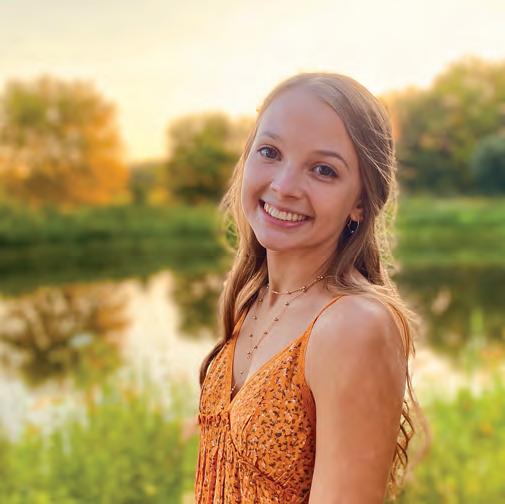
CASSIE POMIERSKI
BALL STATE UNIVERSITY
I am a senior pursuing a Bachelor of Fine Arts in Graphic Design. I’m from the small town of Yorkville, IL, about 50 miles west of Chicago. Growing up, I always knew I was made to create, having made little movies with my older sister and taking many drawing, fashion design, and interior design classes. I eventually decided on a degree in graphic design to channel my creativity while also being able to help others, and I am excited to navigate the versatile and ever-expanding digital world. Now, in my last semester at Ball State, I am a member of the Honors College and a Design Specialist at the Digital Corps, a student-staffed digital agency on campus. I also have had the wonderful opportunity to work as both a Project Manager and a Team Lead at Studio 165+, a student-led design studio at Ball State. When I’m not designing, I love going to concerts, finding new coffee shops to try, and adventuring outdoors.
WHAT MAKES YOU FEEL INSPIRED?
My biggest inspirations are the people I look up to, the nature around me, and the fine arts, whether that be a piece of music or a poem that speaks to me.
WHAT AREA OR AREAS OF DESIGN ARE YOU HOPING TO WORK IN OR SPECIALIZE IN?
UI/UX design and illustration. I would love to explore game design in the future as well.
WHAT IS ONE THING THAT DESIGN SCHOOL HAS TAUGHT YOU THAT YOU DID NOT EXPECT?
Design school taught me to defend and present my work as an integral part of the design process.
WHO IS SOMEONE YOU LOOK UP TO IN YOUR FIELD? EITHER TODAY OR HISTORICALLY?
Someone I look up to in the design field is Ron Mace for his revolutionary advancements in accessibility and his universal design approach. I also can’t thank my professors and mentors enough for helping me become the designer and person I am today.
GDUSA 95
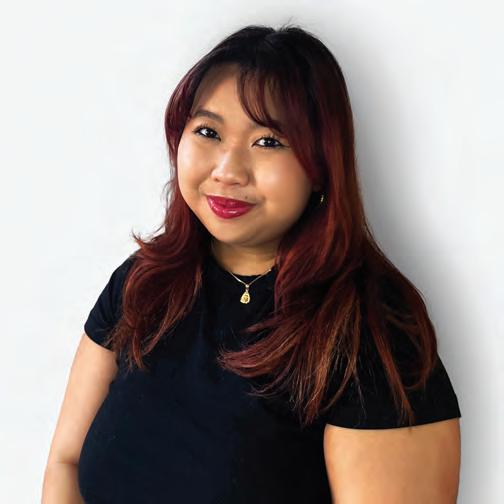
ASHLEY ANOUSAYA
THOMAS JEFFERSON UNIVERSITY
Ashley Anousaya, a Laotian American, is a senior at Thomas Jefferson University in Philadelphia, majoring in Visual Communication Design with a minor in Web Design and Development. During high school her graphic design courses quickly became her favorites. Those classes fostered her passion for aesthetics, colors, and technology and inspired her to pursue a career in design. Ashley thrives in collaboration and leadership roles and actively participates in various aspects of school life and community engagement. Currently serving as the president of the Asian Student Association at Jefferson, she also holds the positions of Resident Assistant, Peer Mentor, and Graphic Designer in Jefferson’s Office of Student Engagement. Her joy lies in uplifting and connecting with others, and she finds fulfillment in spreading happiness, color, and design everywhere she goes.
WHAT MAKES YOU FEEL INSPIRED?
What makes me feel inspired are the people all around me. Empathy is a huge part of the design process so gaining an initial connection and understanding of the people I design for and just interact with helps me gain so much more insight into them as people and other views I never thought of myself. Creation for me truly stems from connection.
WHAT AREA OR AREAS OF DESIGN ARE YOU HOPING TO WORK IN OR SPECIALIZE IN?
I am hoping to specialize in branding or UI/UX design. I love branding because you get to see how a whole system comes to life across so many touchpoints. UI/UX design has always interested me in pushing what interactive design can do even beyond websites and apps.
WHAT IS ONE THING THAT DESIGN SCHOOL HAS TAUGHT YOU THAT YOU DID NOT EXPECT?
I underestimated the importance of initial steps in the design process, particularly the research phase of a project. There is so much to do and figure out before diving into a design program/software. I did not expect to grow to love the research stage so much.
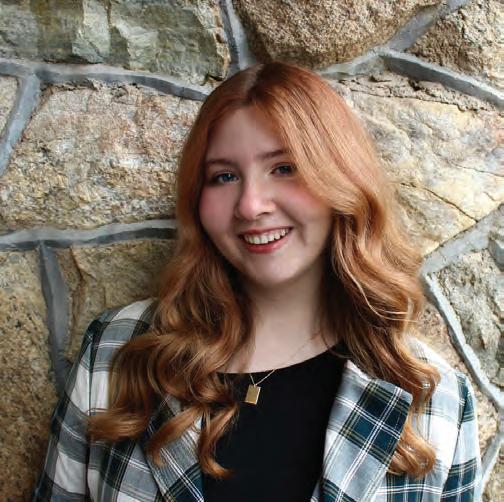
EMMA MADDALUNA
THOMAS JEFFERSON UNIVERSITY
Emma Maddaluna, currently a senior at Thomas Jefferson University, is pursuing her B.S. in Visual Communication Design. Her artistic journey began early, finding creative outlets by participating in art and photography clubs. However, it was during high school that she was introduced to photoshop and the world of graphic design and realized her interests could lead to a career. Today, even outside of the studios and assignments, Emma is perpetually in search of new techniques and enjoys tackling creative design briefs found on social media. She takes pride in her work and specializes in connecting and fine-tuning all the details in a project. Her work recently earned her recognition as the runner-up for the best in show in the AIGA Philly’s Locally Sourced publication. When Emma is not designing, she spends time reading, listening to music, painting, illustrating, and honing her skills in embroidery.
WHO IS SOMEONE YOU LOOK UP TO IN YOUR FIELD? EITHER TODAY OR HISTORICALLY?
I look up to a lot of illustrators in the field. I really enjoy Jessica Hische and her combination of lettering and illustration.
WHAT ARE YOU READING, LISTENING TO, WATCHING (BOOKS, MOVIES, TV, SOCIAL MEDIA, MUSIC)?
I am always listening to music, so it’s hard to pick certain artists, but I have been enjoying listening to rock, show tunes, or folk music. I read a lot! I am currently working on the A Court of Thorns and Roses series, as well as Fourth Wing.
DO YOU CURRENTLY, OR DO YOU PLAN TO, DESIGN FOR ANY CAUSES OR CHARITIES?
This semester, I will be working with industrial designer and occupational therapy students to help The International Fibrodysplasia Ossificans Progressiva Association provide DIY adaptive technology to their community. I would love to someday work with the Make A Wish Foundation — as I saw how impactful their work is when my neighbor was a participant.
96 GDUSA 2024 | STUDENTS TO WATCH

MADELINE PARADIS COLUMBIA COLLEGE CHICAGO
Madeline Paradis is a designer based in Chicago, graduating this spring with a BA in Graphic Design and a minor in Design Management. Originally from Kansas, Paradis started her design journey on her high school’s newsmagazine team; this experience has led to a love of storytelling and collaboration in her current work. On campus she is the graphic designer for the Career Center and the Director of Public Engagement for AIGA.
WHAT MAKES YOU FEEL INSPIRED?
Seeing the work of my classmates, especially those studying different disciplines like photography or fine art. It is motivating to have peers that are making better work than myself and it is such a gift to be surrounded and inspired by that.
WHAT AREA OR AREAS OF DESIGN ARE YOU HOPING TO WORK IN OR SPECIALIZE IN?
I really love brand identity, print materials, and installations, although I try not to narrow myself down into one area. Creating and contributing to the unfamiliar is the fun of being a designer.
WHAT IS ONE THING THAT DESIGN SCHOOL HAS TAUGHT YOU THAT YOU DID NOT EXPECT?
Design school has taught me the gift of feedback, and how to give and take critique objectively, rather than personally. To be better designers and artists, we have to be open to the opinions of others and willing to try seeing things from other's perspectives.
WHAT ARE YOU READING, LISTENING TO, WATCHING (BOOKS, MOVIES, TV, SOCIAL MEDIA, MUSIC)?
Reading: Braiding Sweetgrass Robin Wall Kimmerer and Travels with Charley by John Steinbeck
Looking: Ray Johnson c/o
Listening: CMAT, Yebba, and boygenius
Watching: Pretend It’s a City with Fran Lebowitz

ANDRES RODRIGUEZ
COLUMBIA COLLEGE CHICAGO
Andres Rodriguez is a Chicago-based designer. Despite not having an initial interest in art or design during his childhood, he was always intrigued by the transformative nature of creativity. It wasn't until his high school digital media class that Andres was introduced to graphic design, sparking a newfound passion for visual storytelling and communication. As a result of this, he is now currently pursuing a B.A. in Graphic Design. In his creative practice, Andres often relies on a balance between research, experimentation, and intuition. His approach is not limited to conventional boundaries; instead, he sees each project as an opportunity to break new ground and challenge established norms. In the everevolving design industry, Andres views the collaborative exchange of ideas as a catalyst for pushing the boundaries of visual communication. As he grows as a designer, he remains dedicated to seeking fresh perspectives to incorporate into his evolving style.
WHAT MAKES YOU FEEL INSPIRED?
Learning new tools and software is a constant source of inspiration for me. I often get a wave of ideas when I look into what these tools can do and try to think of ways to incorporate them in my workflow for upcoming projects. My interest in design is fueled by pushing the limits of what can be accomplished with each new tool, which inspires me to come up with fresh perspectives and creative solutions that elevate the visual impact of my work.
WHAT AREA OR
AREAS OF DESIGN ARE YOU HOPING TO WORK IN OR SPECIALIZE IN?
I’m drawn to the dynamic and ever-evolving field of interactive and user experience design, where I try to find a balance that blends aesthetics with functionality that enhances user engagement and satisfaction. I’m also passionate about publication design, where I can combine visual storytelling with layout aesthetics to create engaging narratives. Additionally, my goal is to explore graphic design within the the energy and creativity of the sports industry.
GDUSA 97
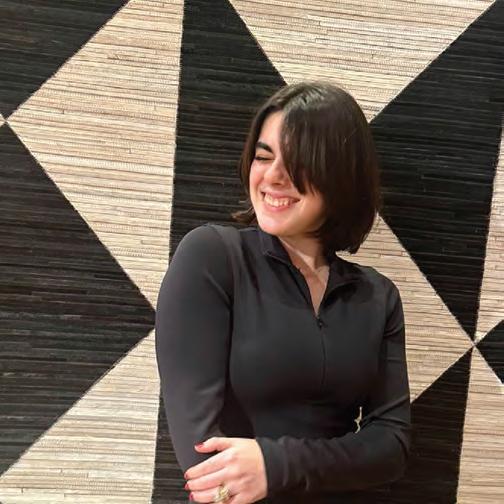
JULIA CYR HARTFORD ART SCHOOL
Julia was born and raised in Connecticut, and is currently a third year student with a major in Visual Communication Design and double minoring in marketing and art history. While pursuing a bachelor in fine arts, Julia is a senior residential assistant on campus for a first year living area. She also has assisted in founding Hartford Art School’s first VCD club “.JPEG” creating a community studio space for peers interested in graphic design to work together in a stress-free environment.
WHO IS SOMEONE YOU LOOK UP TO IN YOUR FIELD? EITHER TODAY OR HISTORICALLY?
Someone that I currently look up to in my field is Elliot Ulm, a graphic designer that mainly shares his work on Instagram and YouTube. He isn’t afraid to explore and be experimental with graphic design. He steps out of his comfort zone by doing self-initiated challenges such as designing a hundred posters in a hundred minutes or designing a logo in unconventional programs such as a creative Minecraft world.
WHAT ARE YOU READING, LISTENING TO, WATCHING (BOOKS, MOVIES, TV, SOCIAL MEDIA, MUSIC)?
I am currently reading the Jujutsu Kaisen manga and watching the anime. My Spotify wrapped listed The Beach Boys, Laufey, Doja Cat, Nirvana and Johnny Cash. I enjoy scrolling and occasionally posting on Instagram and TikTok.
DO YOU CURRENTLY, OR DO YOU PLAN TO, DESIGN FOR ANY CAUSES OR CHARITIES?
Recently, I have created infographics demonstrating the different levels of the air quality; currently not working for any causes or charities, but would love the opportunity to work directly.
DO YOU FEEL THAT DESIGN SCHOOL HAS PREPARED YOU TO SEARCH FOR AND FIND A JOB?
I have been able to develop a portfolio and use the tools to create a website, personal branding, and material to have a consistent social media presence. I can represent myself in the best way when searching for a position.

RACHEL TARINELLI HARTFORD ART SCHOOL
Rachel is a fourth year Visual Communications Design major at the University of Hartford. She is a designer and illustrator. Rachel grew up in Canton, Connecticut and creativity has always been a central part of her life. From a young age Rachel has been interested in a variety of artistic hobbies and always knew she wanted to have a creative career in some way. In her work, she enjoys combining her illustration style with graphic design.
WHAT MAKES YOU FEEL INSPIRED?
Like many designers, there’s a lot of things that inspire my work. If I had to choose one, I’d say I’m most inspired by my peers and other creatives in my community.
WHAT AREA OR AREAS OF DESIGN ARE YOU HOPING TO WORK IN OR SPECIALIZE IN?
As a student I'm still learning a lot about what's out there in the industry, but as of now I most enjoy identity projects and branding.
WHAT IS ONE THING THAT DESIGN SCHOOL HAS TAUGHT YOU THAT YOU DID NOT EXPECT?
One thing I have learned throughout design school is how much attention to detail matters. Small details that may seem insignificant, can have a big impact on the result. Taking into consideration all the little things, and being thorough with one's work, says a lot about a designer.
98 GDUSA 2024 | STUDENTS TO WATCH

AUTUMN GRAVES
UNIVERSITY OF SOUTHERN MISSISSIPPI
Autumn Graves is a senior graduating in the Spring of 2024 with a BFA in graphic design. Growing up in Hattiesburg, MS, she was homeschooled until college which gave her the opportunity to hone her education around her love for the arts from an early age. In high school, she focused on classes like painting, classical piano, and classic literature, influencing her current creative direction and inspiration as an artist now.
Although always drawn to art, it was in college that she discovered a passion for graphic design. She loves the relationship between problem solving and creativity in design. Autumn currently works as the associate creative director for the USM Design and Marketing Team and as the graphic designer at Temple Baptist Church. Her focus lies in illustration, and she particularly enjoys branding and publication design. Autumn loves traveling, hiking, reading, thrifting, and live music.
WHAT MAKES YOU FEEL INSPIRED?
Music, travel, and my husband inspire me the most - with him being a musician, seeing his passion and talent inspires and motivates me.
WHAT AREA OR AREAS OF DESIGN ARE YOU HOPING TO WORK IN OR SPECIALIZE IN?
My passion definitely lies in illustration, branding, and publication design. I would love to pursue those things in a future career, however, I am excited to keep an open mind and see where my career takes me..
WHAT IS ONE THING THAT DESIGN SCHOOL HAS TAUGHT YOU THAT YOU DID NOT EXPECT?
Design school really taught me to love the process of critique and the importance of it in the design process. Critique has made me a good visual communicator and to challenge my own bias and opinions.

GRACE MAY
UNIVERSITY OF SOUTHERN MISSISSIPPI
My name is Grace, and I am currently a senior graphic design student at the University of Southern Mississippi. I grew up in a small-town south of Jackson, MS, and spent most of my high school years being creative in any way possible. I always knew that I was meant to be an artist in some capacity, but I never knew that graphic design was my calling!
WHAT MAKES YOU FEEL INSPIRED?
Going shopping at antique stores and finding little knick-knacks with cool designs. Anything vintage or unique in some way inspires me to go beyond my comfort zone and try new things.
WHO IS SOMEONE YOU LOOK UP TO IN YOUR FIELD? EITHER TODAY OR HISTORICALLY?
I’m often encouraged and supported by my classmates. I look up to a few specifically that are great designers and friends.
WHAT ARE YOU READING, LISTENING TO, WATCHING (BOOKS, MOVIES, TV, SOCIAL MEDIA, MUSIC)?
I’m always scrolling through Pinterest or TikTok during my free time.
DO YOU CURRENTLY, OR DO YOU PLAN TO, DESIGN FOR ANY CAUSES OR CHARITIES?
Maybe one day in the future. I’m definitely open to the idea of designing for causes that are important to me. Usually non-profits are overlooked and I believe that any organization would find more success with good design.
DO YOU FEEL THAT DESIGN SCHOOL HAS PREPARED YOU TO SEARCH FOR AND FIND A JOB?
Based on recent alumni, I am hopeful that I will be successful in my job search.
GDUSA 99
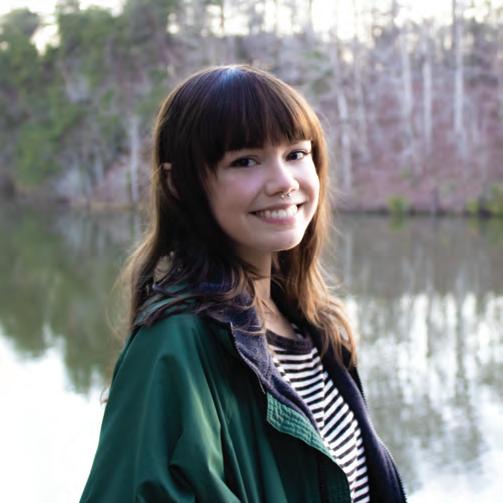
KATELYN DANIEWICZ
THE UNIVERSITY OF ALABAMA
My name is Katelyn Daniewicz, and I am a graduated graphic design student from The University of Alabama. I started out at UA as a STEM major, not exactly knowing what path I wanted to take in college or in my future career. As soon as I failed my first computer science exam, I knew I had to try something different. I have always enjoyed art and design, so I decided that graphic design would be a safe bet. As soon as I switched over to studying design, I felt like I had finally found my way. My time spent as a graphic design student at UA was extremely enjoyable, beneficial, and incredibly inspiring. I learned that I am a chronic perfectionist, and that I have an insatiable passion for branding and package design. With my valuable experience from classwork and student design jobs at UA, I landed a full-time job immediately after graduation with a creative marketing agency. I am immensely lucky that I get to design for a living—I feel like I won’t have to work a day in my life. Earning my degree in graphic design at UA has changed my life, and I would not want it any other way.
WHAT ARE YOU READING, LISTENING TO, WATCHING (BOOKS, MOVIES, TV, SOCIAL MEDIA, MUSIC)?
I don’t watch much, but I listen to music a lot while designing. My favorite artists at the moment are Shygirl, Hannah Diamond, and Cowgirl Clue.
DO YOU FEEL THAT DESIGN SCHOOL HAS PREPARED YOU TO SEARCH FOR AND FIND A JOB?
Luckily, I had a design job lined up right after graduation. I do believe that The University of Alabama properly prepared me to find a job, because the woman who recruited me found me in my ART-414 portfolio class. If you put in the work and are passionate about design, design school will equip you with a great portfolio to jumpstart your career.

DARRELL SHELBY THE UNIVERSITY OF ALABAMA
Hello! My name is Darrell Shelby, and I am a senior at The University of Alabama studying for a BFA in graphic design. Since I was young, I have always had a passion for art and design but did not know how to bring my skills together until I discovered brand and UI design. My goal is to turn this passion into a career in the user interface and user experience industry with a focus on web and mobile design and potentially brand identity design on the side. My approach to creative problem solving is a blend of research, conceptualization, and eye-catching visual delivery; this process has led me to developing a quality body of work that I am proud of and plan to expand/improve upon for as long as I can. Outside of design, I enjoy landscape and architectural photography, as it helps me get out and observe things I would otherwise ignore. In my free time, I enjoy hanging out with friends, playing video games, and getting lost in one of my many hobbies.
WHAT MAKES YOU FEEL INSPIRED?
My main inspiration to design is the enjoyment of solving new and interesting problems both visually and functionally.
WHAT AREA OR AREAS OF DESIGN ARE YOU HOPING TO WORK IN OR SPECIALIZE IN?
I plan to work for a company as a user interface designer, creating intuitive and visually striking websites and apps.
WHAT IS ONE THING THAT DESIGN SCHOOL HAS TAUGHT YOU THAT YOU DID NOT EXPECT?
A big lesson I have learned in design school is not to fall in love with your first idea, instead work through as many iterations of a design as you can and see where it takes you.
WHO IS SOMEONE YOU LOOK UP TO IN YOUR FIELD? EITHER TODAY OR HISTORICALLY?
I look up to both Don Norman, author of The Design of Everyday Things and Steve Krug, author of Don’t Make Me Think. Their books have helped me form my personal philosophy for design.
100 GDUSA 2024 | STUDENTS TO WATCH

MARIA PENLER BOWLING GREEN STATE UNIVERSITY
Maria Penler graduated with a BFA in Digital Arts from BGSU in 2018 and is currently pursuing a Master of Design degre in the Integrative Design program, expecting to graduate in December 2024. Since her undergraduate studies, Maria has been actively contributing to the real estate industry, collaborating on projects that explore the intricacies of housing and promote equitable and inclusive practices. Her design interest extends to healthcare, where she focuses on enhancing accessibility and transparency for patients and consumers. In her ongoing research, Maria dedicates herself to simplifying complex systems such as medical billing and health insurance, empowering, and educating individuals to navigate these challenges. Her commitment to thoughtful design can be seen in both academic achievements and practical contributions, working towards becoming a more inclusive and accessible designer with each project.
WHAT MAKES YOU FEEL INSPIRED?
What makes me feel inspired is collaborating with a group of other creatives. There is nothing like being a part of a group where everyone gets to contribute their talent, the outcome is always so much more authentic.
WHAT AREA OR AREAS OF DESIGN ARE YOU HOPING TO WORK IN OR SPECIALIZE IN?
I hope to begin working within the healthcare or insurance industry after graduation.
WHAT IS ONE THING THAT DESIGN SCHOOL HAS TAUGHT YOU THAT YOU DID NOT EXPECT?
Design school has taught me alot about taking ownership of not only my work but the process of that work. At the end of the day, the output doesn’t matter if the process to get there was not sustainable or growth minded.
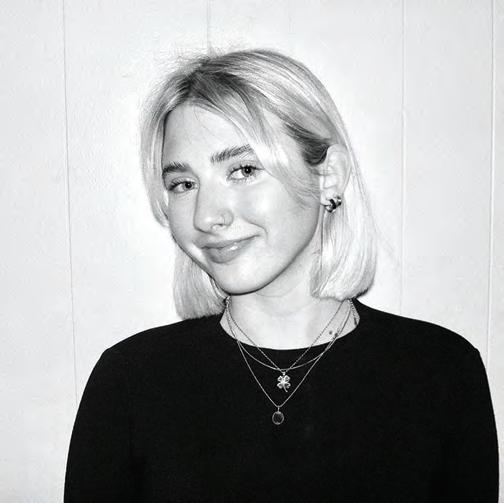
DAISY SCHWIND
BOWLING GREEN STATE UNIVERSITY
Daisy Schwind is a designer and multimedia artist in Toledo, Ohio. She is pursuing a BFA in Graphic Design at Bowling Green State University. Daisy has always been a multi-passionate and incredibly creative person; she has performed as a cellist in numerous symphonies, including one that toured several European countries; she designs and constructs clothes and toys; and creates collages from found objects. Art, design, and the humanities have always been driving forces in Daisy's life as many of her family members are themselves artists or artistically inclined. As a designer, she is passionate about creative problem-solving, the usage of colors and geometric shapes, the exploration of aesthetics, and the history of graphic design.
WHAT MAKES YOU FEEL INSPIRED?
There are so many things by which to be inspired in this world. My chief inspirations are music, nature, vintage photographs, and design, as well as grocery stores. I love going into the grocery store and analyzing the signage, brand packaging, and even the arrangement, colors, and forms of fruits and vegetables to derive inspiration for a new project
WHAT AREA OR AREAS OF DESIGN ARE YOU HOPING TO WORK OR SPECIALIZE IN?
As I move toward the conclusion of my undergraduate work and consider a career, I am hoping to specialize in multimedia design, as I enjoy incorporating various media into my work– it makes my work nimble, and nuanced, and draws in a broader audience.
WHAT IS ONE THING THAT DESIGN SCHOOL HAS TAUGHT YOU THAT YOU DID NOT EXPECT?
While a BGSU design school student, I have absolutely learned to be confident in my craft. As a new designer I often feel insecure about my designs or get in my head about an idea, but, ironically, the work I tend to be most insecure about turns out to be the most distinctive and successful that I’ve made. It has taught me to follow my intuition about artistic integrity and not allow my insecurities to limit my creative process.
GDUSA 101
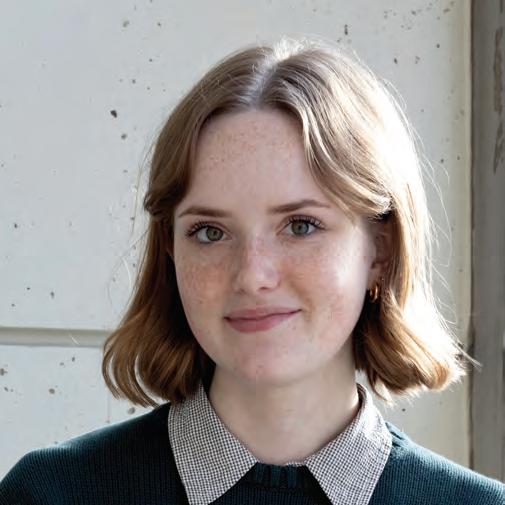
LAUREN FAVIER
UNIVERSITY OF TENNESSEE SCHOOL OF DESIGN
Lauren Favier is a Tennessee-based student pursuing a Bachelor of Fine Arts in Graphic Design. With a background in both fine art and music, Lauren is always seeking opportunities for interdisciplinary connections. As a designer, she places a great emphasis on storytelling, recognizing narratives as an age-old and unfading tool for communication. At the University of Tennessee, Knoxville, she manages the Graphic Design program’s two Risograph printers, hosting workshops to teach students and faculty about the printing process. Her favorite ink is Fluorescent Pink. Conversation and play have come to occupy an integral part of her creative process and assisting fellow designers in their work only grows that habit. Aside from her focus on the Risograph, Lauren also enjoys branding and illustration work.
WHAT MAKES YOU FEEL INSPIRED?
My best ideas and fixations come from my other classes, outside of Graphic Design; recently, a class on Pre-Renaissance Italian Art drove me into a months-long medieval phase.
WHAT AREA OR AREAS OF DESIGN ARE YOU HOPING TO WORK IN OR SPECIALIZE IN?
My work within my program as our resident Risograph tech has made working in a specialty Risograph studio a dream of mine, although I also love the branding process.
WHAT IS ONE THING THAT DESIGN SCHOOL HAS TAUGHT YOU THAT YOU DID NOT EXPECT?
No one does anything alone, not really.
WHAT ARE YOU READING, LISTENING TO, WATCHING?
Reading Austin Kleon’s Steal Like an Artist, listening to Vince Guaraldi, and watching every Jane Austen adaptation ever made.

JAIDEN KASAVAL
UNIVERSITY OF TENNESSEE SCHOOL OF DESIGN
Jaiden Kasaval is a Knoxville-based, senior BFA Graphic Design student at the University of Tennessee School of Design. He grew up in the rural Appalachian town of Dandridge, Tennessee, nurturing an artistic and creative background. College brought along with it the idea of design and simultaneously his cultivating passions for print, publication, typography, web design, and branding. The combination of digital and analog processes is constantly driving his work in new and exciting directions.
Though he often gets raveled up by the technical aspects of design, his love lies in storytelling. From a young age, he has consistently invested in his affinities for books and writing, which has consequently bled into his design applications. Whether its branding identities, archival research through web experiences, or practicing methods of print, he’s always searching for a story to tell; thoughtful design stands at the core of his values..
WHAT MAKES YOU FEEL INSPIRED?
My time studying through the UT School of Design has recently sparked a study abroad trip this past summer to Seoul, South Korea, in which I traveled alongside 12 of my fellow classmates. This entire experience was very enriching for me as I was able to explore my normal habits and art/design practices (like photography and typography), but in a whole new lens and amongst a totally unknown environment. I was able to perceive an entirely different side of design, one that wasn’t entirely Western-influenced.
WHAT AREA OR AREAS OF DESIGN ARE YOU HOPING TO WORK IN OR SPECIALIZE IN?
Karel Martens is a role model whose work I find myself constantly referring to. I also look up to Na Kim, who was a student of Karel Martens and whose exhibition I was able to attend during my stay in Seoul. I enjoy their shared interests of bold, experimental design.
102 GDUSA 2024 | STUDENTS TO WATCH

ANCIL AUSTIN JR. UNIVERSITY OF THE ARTS
Ancil Austin Jr. (he/they) is a senior studying graphic design with a minor in art history at the University of the Arts, situated in the vibrant city of Philadelphia. Drawing inspiration from their profound appreciation for plants and nature, Ancil infuses their designs with an organic and gentle allure to captivate the eyes of viewers. Beyond the realm of design, Ancil delves into diverse artistic realms, exploring printmaking and ceramics while also harboring a keen interest in the intricacies of computer science. Their senior capstone project focuses on creating seed bombs using recycled paper to populate Philadelphia’s vacant lots with native flowering plants rather than illegally dumped trash, and to also find a direct use for the discarded paper generated by graphic designers.
WHAT MAKES YOU FEEL INSPIRED?
I get my inspiration from nature. I’ve always loved learning about and caring for plants from a young age. Plants are a big part of my art and they mold the way I think when it comes to design..
WHAT AREA OR AREAS OF DESIGN ARE YOU HOPING TO WORK IN OR SPECIALIZE IN?
I’m hoping to expand my horizons in environmental design, looking to bring sustainability to the world of design.
WHAT IS ONE THING THAT DESIGN SCHOOL HAS TAUGHT YOU THAT YOU DID NOT EXPECT?
Design school taught me how to think, even though it’s something I do every second. It teaches me how to analyze the world around me, and to ask questions..
WHAT ARE YOU READING, LISTENING TO, WATCHING?
Reading: I’m reading Cathedral by Raymond Carver. I find his writing to be brilliant, the way he reaches into human emotion and creates room for abstraction is very intriguing.
Listening: Breatharian by Mndsgn
Watching: The Sopranos

PERRY COKER UNIVERSITY OF THE ARTS
Perry Coker is a senior earning her BFA in Graphic Design at The University of the Arts in Philadelphia. Her upbringing in Florida inspires much of her bold and colorful designs, infusing everyday life with humor and whimsy. Perry’s work spans a variety of media and her love for hand-driven processes informs her solutions to design problems. She aims to reveal the complexity and nuances of being human while challenging people to think differently about design. When she is not designing, you can find her reading cookbooks, making pasta, hiking, or learning a new craft. Perry is excited for the opportunities coming next in her career.
WHAT MAKES YOU FEEL INSPIRED?
Lately I have been really inspired by the architecture of the city. I get very excited about a good door, which there are no shortages of here in Philly. .
WHAT AREA OR AREAS OF DESIGN ARE YOU HOPING TO WORK IN OR SPECIALIZE IN?
To lean into my unique skill set and to trust myself.
WHAT IS ONE THING THAT DESIGN SCHOOL HAS TAUGHT YOU THAT YOU DID NOT EXPECT?
I love storytelling and solving problems with design. I hope to land in a position that allows me to tap into many aspects of design while getting to see my work live in the real world.
103 GDUSA
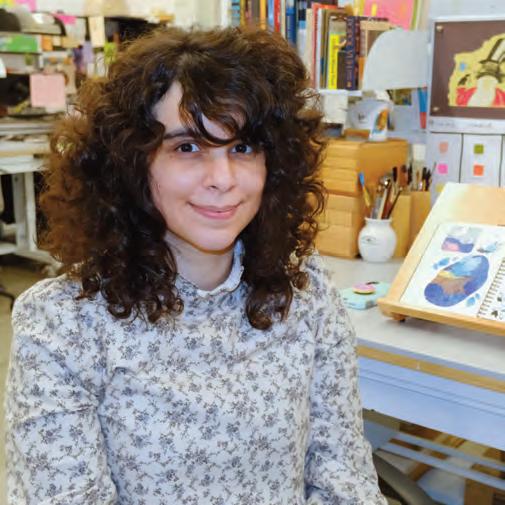
CLEONIQUE HILSACA
WASHINGTON UNIVERSITY IN ST. LOUIS
Cleonique Hilsaca is an illustrator from Honduras based in St. Louis, Missouri. Her professional work can be found in picture books, newspapers, magazines, board games, and galleries. She has worked with clients such as Penguin Random House, MTA Arts & Design, Sesame Workshop, Renegade Game Studios, and Il Corriere della Sera. Cleonique’s work has been featured in Spectrum: Fantastic Art, The Society of Illustrators, 3X3, and La Bienal de Ilustración de México. Hilsaca is currently studying in the MFA in Illustration & Visual Culture program at Sam Fox School of Design & Visual Arts at Washington University in St. Louis. She illustrated for the board game Artisans of Splendent Vale, and the picture books Rat Fair (2021), Dream Submarine (2024), and Sleep, Little Dozer (2024).
WHAT MAKES YOU FEEL INSPIRED?
I feel inspired by the creative community of the places where I’ve lived and traveled, as well as by my cohort, mentors, and peers at WashU.
WHAT AREA OR AREAS OF DESIGN ARE YOU HOPING TO WORK IN OR SPECIALIZE IN?
I love working in publishing, with a focus in children’s picture books, and hope to one day publish books I’ve written and illustrated myself.
WHAT IS ONE THING THAT DESIGN SCHOOL HAS TAUGHT YOU THAT YOU DID NOT EXPECT?
The importance of visual culture study and research as part of my creative practice and personal growth as an artist.
WHAT ARE YOU READING, LISTENING TO, WATCHING?
I’m reading “Writing Picture Books” by Ann Whitford Paul, listening to the podcast “Grupo de Autoayuda de Dibujo,” and recently watched the amazing film “The Boy and the Heron.”

HALLIE KING
WASHINGTON UNIVERSITY IN ST. LOUIS
Hallie King is a designer from Rancho Palos Verdes, California. King is a senior pursuing a BFA in Communication Design with a minor in Human-Computer Interaction at the Sam Fox School of Design & Visual Arts at Washington University in St. Louis. Her experiences have included branding and identity design, web and mobile design, book design, illustration, and motion design. King enjoys creating multimedia projects, especially those that relate to the visual and performing arts. Additionally, she loves finding ways to incorporate analog details and tactility into her work. When not designing, King can often still be found making something, whether it’s knitting a scarf, baking a peach pie, or painting by the beach.
WHAT MAKES YOU FEEL INSPIRED?
I think live performance is one of the most inspiring things to experience. I grew up dancing and have always had a love for theater and music, so seeing a live show always makes me feel more energized and excited to create things.
WHAT AREA OR AREAS OF DESIGN ARE YOU HOPING TO WORK IN OR SPECIALIZE IN?
I would love to pursue branding and identity design! I really enjoy projects that allow me to consider multiple channels for a single design system.
WHAT IS ONE THING THAT DESIGN SCHOOL HAS TAUGHT YOU THAT YOU DID NOT EXPECT?
There is always room to experiment with different design disciplines, even if you think you’ve decided on pursuing a specific area. I came into design school as an aspiring illustrator, then took a detour into UI and UX design before finding that I really enjoy branding. I’m hoping that all of these interests will end up having an influence on my practice in one way or another.
104 GDUSA 2024 | STUDENTS TO WATCH
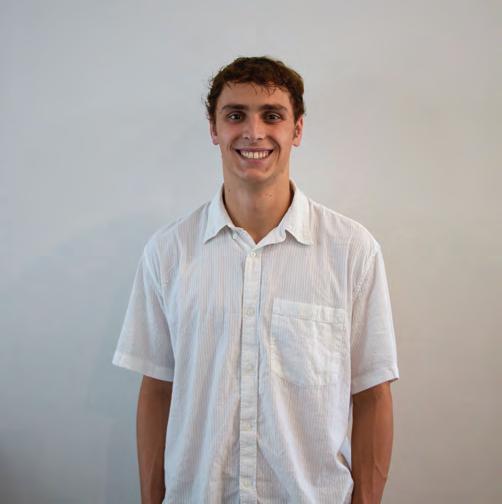
NICK BAZZONI BELMONT UNIVERSITY
My name is Nick Bazzoni, I’m a senior Design Communications student from Belmont University. I am currently working as a part time shop designer at The Buntin Group in Nashville, TN where I design for brands like Perkins, Trex, Gracious Homes, Servpro, Tennessee Lottery, among many other amazing brands. When I’m not working, going to school, or designing, you can normally find me watching movies at the local Regal, playing some kind of sport outside, or attending a concert. My goal through my work is to challenge conventional approaches by incorporating market research and user experience to dictate the form, function, and concepts I convey in my designs. One day, I would like to work as a graphic designer or creative director in the entertainment industry.
WHAT MAKES YOU FEEL INSPIRED?
I think with the release of new movies like Spiderman: Into the Spiderverse and TMNT: Mutant Mahem, the animation industry has been reinventing the way animation looks and feels which inspires me to make more ambitious decisions in my work.
WHAT AREA OR AREAS OF DESIGN ARE YOU HOPING TO WORK IN OR SPECIALIZE IN?
I’m not really sure what specific type of design I would like to specialize in; however, I always thought it would be fun to work as a graphic designer in the entertainment industry in some capacity potentially in sports, music, or film.
WHAT IS ONE THING THAT DESIGN SCHOOL HAS TAUGHT YOU THAT YOU DID NOT EXPECT?
Collaboration and critique make better designs, so I try to face that head on instead of shying away from it. The best way to understand your audience is to ask them.
WHO IS SOMEONE YOU LOOK UP TO IN YOUR FIELD? EITHER TODAY OR HISTORICALLY?
I am a big fan of David Carson and Neville Brody. I think they both threw a wrench in the traditional design style of the 21st Century which made some really awesome work.
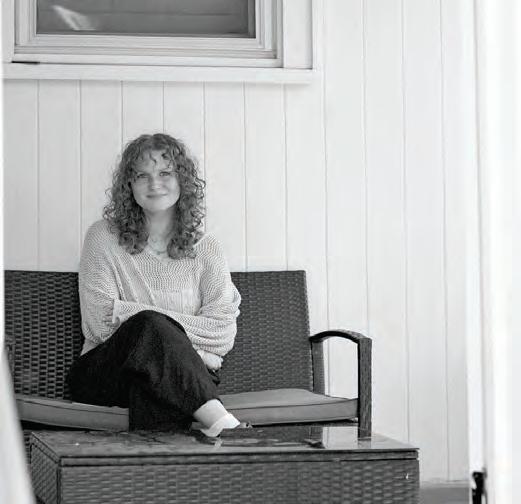
ANNA MAACK BELMONT UNIVERSITY
Anna Maack is a senior Design Communications BFA student at Belmont University. She loves music of all kinds and loves attending concerts for her favorite artists in Nashville. Anna has been working toward her dream of being a graphic designer since the age of 11, when she began making custom designs for her friends on her family’s computer. She found a specific love for typography after developing an unhealthy obsession for fonts from an early age, and used this obsession to stem a love of hand lettering, which is another one of her passions. After graduation, she aims to find a career in branding, packaging, or layout design. Anna aims to synthesize the beauty of simplicity with the complexity of maximalism, and seeks to do so in her art.
WHAT MAKES YOU FEEL INSPIRED?
I am always inspired by people! Family, friends, classmates, strangers. Everyday I’m rediscovering the beauty of humanity.
WHAT AREA OR AREAS OF DESIGN ARE YOU HOPING TO WORK IN OR SPECIALIZE IN?
I find myself gravitating towards any kind of print medium, whether that be packaging design, editorial design, branding, and everything in between. Through my studies I've been inspired by projects centering around social change and advocacy.
WHAT IS ONE THING THAT DESIGN SCHOOL HAS TAUGHT YOU THAT YOU DID NOT EXPECT?
That it is so important to hear and see from fellow designers! I am so inspired by my classmates work and it pushes me to be better every day.
WHAT ARE YOU READING, LISTENING TO, WATCHING?
I currently love-
Show: The Marvelous Mrs. Maisel
Movie: Roman Holiday
Music: John Vincent III’s Songs for the Canyon Book: Agatha Christie’s “And Then There Were None”
105 GDUSA

LILYANA BRYAN
THE OHIO STATE UNIVERSITY
Lilyana Bryan is a senior studying visual communication design at Ohio State University. She’s excited about creating enriching interactions that bring communities together and is particularly interested in product design and brand identity. Outside the studio, Lilyana helps lead her school’s Columbus Society of Communicating Arts chapter through planning and facilitating fun events for design students. In her free time she loves adventuring outdoors, rock climbing, and exploring music.
WHAT MAKES YOU FEEL INSPIRED?
Getting outside! I feel deeply inspired by nature and the design of Earth’s systems. From the spirals and folds in pinecones to lightning storms and sunsets, I’m often grounded in reminders that Mother Nature is the greatest designer. I also love winging it in the kitchen; going in without a plan and combining flavors gets me in a creative mood.
WHAT AREA OR AREAS OF DESIGN ARE YOU HOPING TO WORK IN OR SPECIALIZE IN?
Brand identity, product design, and user experience.
WHAT IS ONE THING THAT DESIGN SCHOOL HAS TAUGHT YOU THAT YOU DID NOT EXPECT?
Embracing ambiguity and trusting the process. It’s okay to not know what you’re doing for a bit!
WHO IS SOMEONE YOU LOOK UP TO IN YOUR FIELD? EITHER TODAY OR HISTORICALLY?
Kendall Markley and Deb Scott. I interned under Kendall for a while and I so deeply admire her leadership and skill as a designer. Deb is a design professor in my program and although I took only one class with her, I grew immensely as a maker under her mentorship.
WHAT ARE YOU READING, LISTENING TO, WATCHING?
Some of my favorite musicians right now include Hiatus Kaiyote, Yussef Dayes, and Jeff Parker. As for books, I always recommend Braiding Sweetgrass by Robin Wall Kimmerer.
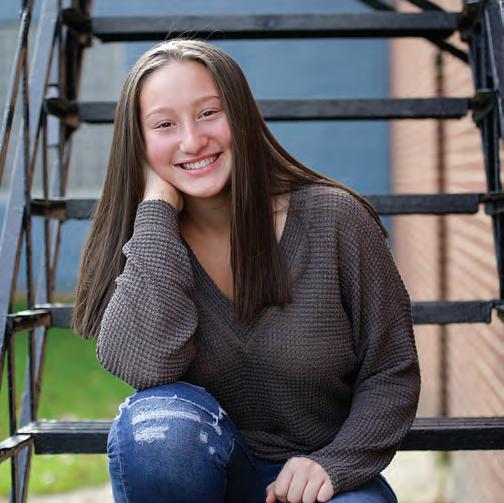
KAYLA EASTMAN
THE OHIO STATE UNIVERSITY
Kayla Eastman is a fourth year Visual Communication Design student who is eager to learn and gain new design experiences. For the past two school years, she has worked alongside the Ohio State Athletics Creative and Branding Team where she works on a wide range of brand application projects. She also interned for Bonfire Red this past summer where she worked on two website redesigns and learned how to screenprint. She freelances in her spare time and enjoys digital and film photography as both a hobby and its role in design. She won two CSCA Awards for her student work and is currently working on an art and research distinction. She is excited to see where her career goes post graduation! Check out her work at eastman104.myportfolio.com.
WHAT MAKES YOU FEEL INSPIRED?
I find inspiration in the art of storytelling within design, and tend to gravitate towards designs that highlight that.
WHAT AREA OR AREAS OF DESIGN ARE YOU HOPING TO WORK IN OR SPECIALIZE IN?
I am passionate about branding and UX/UI, but hope to work somewhere that brings in a wide range of projects. I find the versatility within design careers very exciting.
DO YOU, OR DO YOU PLAN TO, DESIGN FOR ANY CAUSES OR CHARITIES, I.E., DESIGN FOR GOOD?
Absolutely. I’ve done a few branding projects for nonprofits and for my senior thesis I designed an app/brand to help families navigate an Alzheimer’s diagnosis and the caretaking responsibilities it entails.
DO YOU FEEL THAT DESIGN SCHOOL HAS PREPARED YOU TO SEARCH FOR AND FIND A JOB?
I do - I think my design program allowed me to gain experience in many avenues of design, allowing me to both have knowledge in these specialties and also make an educated decision when choosing which design path to steer my career on to.
106 GDUSA 2024 | STUDENTS TO WATCH
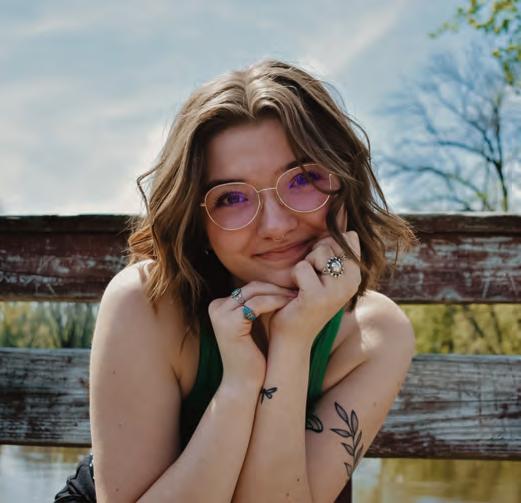
EMMA JENKINS
MILWAUKEE INSTITUTE OF ART AND DESIGN (MIAD)
Emma Jenkins is a third-year student pursuing her BFA in Communication Design. Her love for graphic design stems from a childhood of creativity, and she is happy to have found a career that allows her to merge her love for creating with problem-solving techniques. Emma considers herself a passionate and curious learner, always willing to take on a challenge that can push her conceptual and technical capabilities. She has an overarching interest in print design and branding, and plans to utilize these skills within her future career. Emma dreams of traveling the world to gain cultural experiences and make a difference with her design.
WHAT MAKES YOU FEEL INSPIRED?
Music has always been something that truly excites me. For most of my childhood, my dad was in a rock band — being exposed to the music scene at such a young age has made music an essential part of my everyday life. Now within my own work I find myself trying to replicate the fun, vibrant energy of music.
WHAT AREA OR AREAS OF DESIGN ARE YOU HOPING TO WORK IN OR SPECIALIZE IN?
I hope to one day specialize in branding and/ or print design. I have fallen in love with screen printing this year and would love to see where that takes me.
WHAT IS ONE THING THAT DESIGN SCHOOL HAS TAUGHT YOU THAT YOU DID NOT EXPECT?
I’ve learned that spending time away from our work is so important for creative people. Sometimes you need to take a step back for the missing piece to finally click.
WHO IS SOMEONE YOU LOOK UP TO IN YOUR FIELD? EITHER TODAY OR HISTORICALLY?
My professor, Nicole Hauch, is someone who I have really come to look up to throughout my years at MIAD. She has helped me grow tremendously as a designer.

BRADY VANDERHART
MILWAUKEE INSTITUTE OF ART AND DESIGN (MIAD)
Brady VanderHart will soon graduate with a BFA in communication design from the Milwaukee Institute of Art & Design. His love for all things creative has led him down the path of graphic design. There is little that Brady hasn’t dabbled in, from traditional oil portrait painting, to digital sci-fi concept art; and the sensibilities of this multifaceted creative practice are evident in his design work. He has had the incredible opportunity to work for a variety of agencies as a creative intern, and this has prepared him well for his future endeavors.
WHAT ARE YOU READING, LISTENING TO, WATCHING?
As far as movies are concerned, I was recently enamored with the graphic design within The Creator. Much of my inspiration comes from my other creative love, choral music. Both from listening, as well as singing.
DO YOU CURRENTLY, OR DO YOU PLAN TO, DESIGN FOR ANY CAUSES OR CHARITIES?
One cause that I am currently designing for is the mitigation of social anxiety, as it pertains to fitness. My senior thesis is an app concept dedicated to reducing the anxiety that inhibits some from pursuing their fitness goals. This is an issue that has caused resistance for myself, as well as many others in making exercise a habit.
DO YOU FEEL THAT DESIGN SCHOOL HAS PREPARED YOU TO SEARCH FOR AND FIND A JOB?
Certainly, my education at the Milwaukee Institute of Art & Design has provided me with a plethora of opportunities to advance my professional career. Through my higher education, I found a path that I never thought I could follow, and have been able to make connections and secure a range of professional experiences that have expanded my portfolio and prepared me for what lies ahead.
107 GDUSA
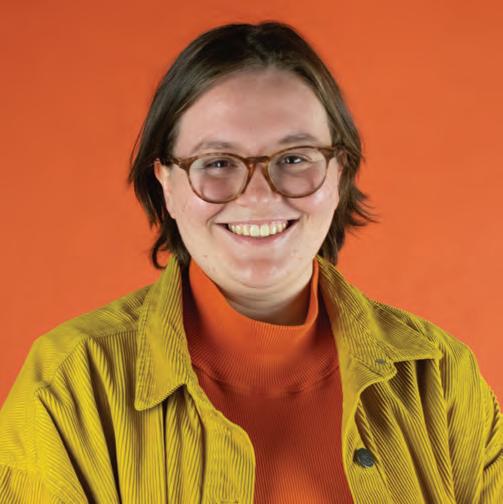
WHITNEY HOCKMAN
COLLEGE FOR CREATIVE STUDIES (CCS)
Whitney Hockman is a communication designer and print enthusiast. She is currently a senior pursuing a degree in Communication Design. Whitney is interested in print, motion, and identity design grounded in research and play. At CCS, she is the AIGA student chapter president, as well as the cofounder of Freeform Press, a Risograph printing and zine club. Whitney believes in the power of community surrounding printed work. She enjoys using the Risograph printer and collaborative projects to bring people together.
WHAT MAKES YOU FEEL INSPIRED?
I am inspired by moments of design that often feel invisible. I like collecting scraps of life- like tickets, receipts or maps- that are designed for such a practical purpose. I think good design has a strong balance between beauty and utility.
WHAT AREA OR AREAS OF DESIGN ARE YOU HOPING TO WORK IN OR SPECIALIZE IN?
I hope that I can continue working with smart and talented people across a variety of mediums and industries. For my personal work, I would love to continue to explore Risograph printing.
WHAT IS ONE THING THAT DESIGN SCHOOL HAS TAUGHT YOU THAT YOU DID NOT EXPECT?
Design school has taught me the importance of writing and speaking about my work. I think the story and process behind design work is just as important as the work itself, and knowing how to explain this to an audience is crucial.
WHO IS SOMEONE YOU LOOK UP TO IN YOUR FIELD? EITHER TODAY OR HISTORICALLY?
Ellen Lupton. Her design expertise and commitment to thoughtful design practice is inspiring.
WHAT ARE YOU READING, LISTENING TO, WATCHING?
I am currently listening to boygenius, rereading Tomorrow, and Tomorrow, and Tomorrow by Gabrielle Zevin, and I just saw Saltburn in theaters for second time.

ANNAMALIS SHARP
COLLEGE FOR CREATIVE STUDIES (CCS)
Annamalis Sharp is a designer born in Chicago and based in Detroit. She is curious in every sense of the word.
WHAT MAKES YOU FEEL INSPIRED?
Before I am a designer, I consider myself a writer first. My best work and the work that inspires me most happens when there is a narrative unfolding and a story I want to tell.
WHAT AREA OR AREAS OF DESIGN ARE YOU HOPING TO WORK IN OR SPECIALIZE IN?
I love motion design for its capacity for storytelling. Even simple animations can surprise and delight and bring the most ordinary thing to life.
WHAT IS ONE THING THAT DESIGN SCHOOL HAS TAUGHT YOU THAT YOU DID NOT EXPECT?
Failure is a difficult but beautiful and necessary step in the process of creating. Wanting to create that perfect final product almost always comes from a process of iterating through things that don’t always work, and even when things don’t work out you’ve still learned something.
DO YOU, OR DO YOU PLAN TO, DESIGN FOR ANY CAUSES OR CHARITIES, I.E., DESIGN FOR GOOD?
Absolutely yes. I believe, especially as a Detroit transplant, it is my responsibility to incorporate social practice into my work. The ideal career path for me is one focused on improving the community around me.
DO YOU FEEL THAT DESIGN SCHOOL HAS PREPARED YOU TO SEARCH FOR AND FIND A JOB?
My experience at CCS has done a great job of preparing me not only with the technical skills needed to find a job but also with the soft skills like being able to communicate and collaborate with a team effectively.
108 GDUSA 2024 | STUDENTS TO WATCH

TYLER DIVALERIO
SHILLINGTON
Tyler, a designer & photographer rooted in Brooklyn, brings a wealth of experience spanning brand development, marketing, art direction, & creative talent acquisition. As a self-driven creative professional, Tyler takes pleasure in devising innovative ways to inspire others, consistently exploring the realms of "more" & questioning the status quo by asking “why?" His artistic pursuits know no bounds, as he doesn’t confine himself to a singular medium. Rebellious, cutting edge, & unique in every decision he makes— Tyler is a true Aquarius.
WHAT MAKES YOU FEEL INSPIRED?
Urban environments, music and fashion culture, LGBTQIA+ community. I love all things Swiss design with a strong grid system, adding a touch of modernism, and creating juxtapositions. Bending the rules (well) is what I do best :)
WHAT AREA OR AREAS OF DESIGN ARE YOU HOPING TO WORK IN OR SPECIALIZE IN?
Having a background in brand I would love to focus on art direction and branding, with photography tied in since I have been a professional photographer for some time. Recently I’ve grown interested in digital and product design as well. At the end of the day I don’t believe in limiting myself as I think as a good designer you can flex if you’re naturally curious and committed.
WHAT IS ONE THING THAT DESIGN SCHOOL HAS TAUGHT YOU THAT YOU DID NOT EXPECT?
You don’t need to know everything to succeed in creative; much of design is about trying things out and failing before you succeed. Some of my best designs happened from iterating.
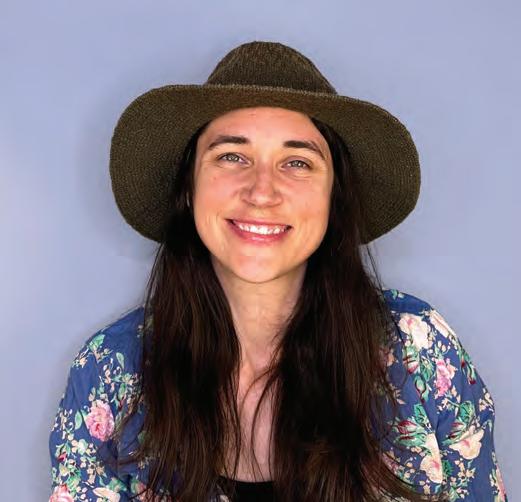
JEANNE SALMON
MILWAUKEE AREA TECHNICAL COLLEGE (MATC)
I am an award winning graphic designer and crafty night owl. A world traveler and lover of the outdoors, I always seem to be crafting or making something, finding inspiration wherever I am. My two older rescue dogs are my favorite studio collaborators, and I have some of my best ideas while we’re out on walks. I am deeply inspired by vintage and antique design, and have a growing collection of advertising ephemera and typewriters. I enjoy hand making my own photo props for graphic design projects, and finding effective, collaborative, and creative solutions when problem solving.
Returning to school in my mid 30s to pursue a career in Graphic Design is the next exciting chapter in my life adventure, and it’s wonderful to have finally embraced my creative side, especially my love of dimensional and print design. I can’t wait to see where the road takes me and all the people I’ll meet along the way! My mantra is simple: love life, travel far.
Visit salmondesignco.com to learn more about me and my work.
WHAT MAKES YOU FEEL INSPIRED?
I find inspiration all around me, everywhere I go; the world is a beautiful and fascinating place. Typefaces that I love or loathe, great branding or clever ads, funny or odd encounters or happenstances, even snapping pictures to capture color palettes of plants at the botanical gardens keep my creative mind flowing. You can never know where the inspiration for your next great idea will come from.
WHAT AREA OR AREAS OF DESIGN ARE YOU HOPING TO WORK IN OR SPECIALIZE IN?
My top three dream jobs would be as a product and packaging designer in the tabletop board gaming industry, as a designer of coffee table books, or crafting period appropriate graphic design related props for film and stage. However, I am exploring agency work because I believe it will be a wonderful opportunity to work on a wide range of projects with a diverse set of clients.
109 GDUSA
2024: YOUR YEAR TO SHINE IN DIGITAL DESIGN
BY LUCY MARINO

As a creative professional, are you thinking about shaking things up career-wise in 2024? Digital design might just be the exciting path you're looking for.
But why is digital design such a hot prospect, and how can you prepare to focus on it?
Recent research from Robert Half illuminates the growing importance of digital design in the marketing and creative sectors. Almost half (48%) of marketing and creative managers place digital marketing at the top of their strategic to-do list for 2024, yet a quarter of them report a lack of digital and web design and development expertise on their teams.
All of this makes the digital design realm ripe with opportunities. This applies to those ready to make the leap toward a permanent position as well as those who might consider contract roles. More than one in four (28%) marketing and creative managers plan to hire contract talent in digital and web design and development in the first half of the year.
Here are some practical tips and insights to help you “redesign” a career in digital design.
START BUILDING A DIGITAL PORTFOLIO
Even if digital design isn’t your primary role, there's a good chance you've dabbled in it. Here’s how you can leverage that experience to build a digital portfolio that pops:
● Highlight relevant digital design projects: Comb through your past work and identify any digital design projects you may have been involved in. These could be website designs, digital marketing materials, or social media graphics. The idea is to showcase your foundational skills in the digital realm.
● Showcase versatility: Your portfolio should be a mix of depth and breadth. Include varied work — from the simple and excellent logo you designed to more complex web layouts. This diversity will demonstrate your adaptability and eagerness to explore different facets of design.
● Narrate your design journey: Use your portfolio to tell the story of your planned transition and how you expect to apply your previous experience to digital design. What are your transferable skills? Do you have an eye for aesthetics, experience with layout or a knack for user experience? Make these connections clear in your portfolio descriptions.
110 GDUSA
● Include descriptive captions: For each piece, include captions that explain the project's context, your role, the tools used and the impact of your work, such as increased user engagement or improved visual communication.
● Demonstrate learning and growth: If you’ve taken courses or earned certifications in digital design, mention them. This shows your commitment to learning and staying updated with industry trends.
● Include personal projects: These can reflect your skills and enthusiasm for digital design as effectively as professional work. If you’ve done any design work for personal blogs, volunteer organizations or just for fun, consider including these.
KEEP YOUR FINGER ON THE PULSE
Staying abreast of the hottest trends in digital design, especially in areas like information architecture, web and mobile design, UI/UX and interaction design, is crucial.
Bookmark essential design blogs and websites for daily inspiration, join online forums for lively discussions on the latest trends, and attend webinars or workshops to refine your skills with hands-on experience.
REFOCUS YOUR PROFESSIONAL DEVELOPMENT
Are you ready to stretch beyond your comfort zone? Volunteer for projects that push your boundaries and showcase your versatility. Consider cross-training in digital skills or seeking a mentor in the field for targeted guidance.
Remember: professional development is not just about acquiring new skills. It’s also about adapting your mindset to embrace innovation, which sometimes includes getting comfortable with judicious risk-taking.
ASSEMBLE AN AUDIENCE – AND KEEP THEM ENGAGED
Platforms like Instagram, TikTok, and Pinterest are where your work meets the world — digital galleries where your designs can be discovered, shared and celebrated. Embrace the power of these platforms to build a community around your work, engage with your audience in real time and showcase your adaptability to new forms of media.
But as you navigate the social media landscape, remember that creating an audience is as much about quality as quantity. Rather than casting a wide net and dabbling in a bit of everything, being the go-to person in a particular area is more beneficial. This will make your content more attractive to people who will champion your work, share it within their networks and help you grow your presence in the digital space. It's about adding depth to your brand and creating a lasting impression that offers more value to those who follow you on social media.
HARNESS THE POWER OF ARTIFICIAL INTELLIGENCE
AI-powered tools can help you concentrate on the more creative aspects of digital design. By allowing AI to do the technical heavy lifting — repetitive tasks like image editing, resizing and adjusting colors — you can focus on conceptual thinking, storytelling and work that packs an emotional punch.
Transitioning to digital design in 2024 is not just following a trend; it's a wise career choice. The industry's appetite for digital talent is growing — embrace this chance to develop your skills, and you could find yourself in a role that's both fulfilling and future-proof.

LUCY MARINO is executive director of the marketing and creative practice at global talent solutions firm Robert Half, which connects employers with skilled marketing, creative, digital, advertising and public relations professionals to meet their specialized recruiting needs. Marino manages strategy and operations for the company’s marketing and creative talent solutions teams across U.S. locations.
GDUSA 111
ADVERTISER INDEX
To request free product information from companies featured in this issue contact the advertisers directly as provided below or within their advertisements.
Artisan 7 artisantalent.com Billerud 28 billerud.com Domtar 23 paper.domtar.com Graphic Design USA (GDUSA) 99 gdusa.com Kallima IBC kallimapaper.com 1.800.411.7011 Mohawk IFC mohawkconnects.com/madetofold Mohawk 12 mohawkconnects.com/madetofold Robert Half roberthalf.com-salary guide 59 SCAD 3 scad.edu/visit Sylvamo BC accentopaque.com/heavyweights Syracuse University 19 College of Visual & Performing Arts admissu@syr.edu https://vpa.syr.edu/cmd2023 Syracuse University 5 Newhouse School of Public Communications newhouse.syr.edu 112 GDUSA
Designed to meet your clients’ printing and finishing needs, the only 3-ply paperboard made in North America is the perfect canvas for consistent printability, reliable runnability and vivid visuals. It’s the smart way to save time and money.
Innovative paperboard. Attentive people.
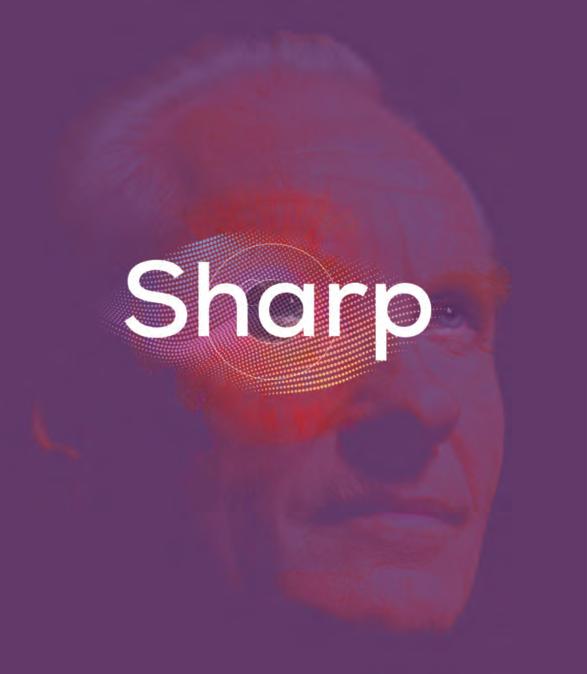
1
800 411-7011 Kallimapaper.com

The same premium uncoated sheet you’ve come to expect from Accent Opaque — now in a range of heavier weights up to 130 lb.
The Heavyweights have all the features you love about Accent:
• Smooth, level printing surface for crisp, vivid images and consistent production
• High brightness and preferred blue-white shade for standout print contrast
• Excellent opacity for minimal show-through
©2024 Sylvamo Corporation. All rights reserved. Accent, Sylvamo and the Sylvamo logo are registered trademarks of Sylvamo Corporation. All other trademarks are the property of their respective owners and are hereby acknowledged.
Say something with substance
Explore finishes and options at accentopaque.com/heavyweights Scan to Request Your Sample
The Heavyweights by Accent® Opaque

 GORDON KAYE AND SASHA KAYE-WALSH ARE EDITORS AT GDUSA
Comments,
editorial@ gdusa.com.
GORDON KAYE AND SASHA KAYE-WALSH ARE EDITORS AT GDUSA
Comments,
editorial@ gdusa.com.












































 JOSHUA TYNER
JOSHUA TYNER










 DAVID LEMLEY
DAVID LEMLEY








 SARAH SANSOM EXECUTIVE DIRECTOR OF CREATIVE INNOVATION CSB, NEW YORK NY
SARAH SANSOM EXECUTIVE DIRECTOR OF CREATIVE INNOVATION CSB, NEW YORK NY









































































































